Home Blog Business The Essential Guide to Marketing Plan Presentations

The Essential Guide to Marketing Plan Presentations
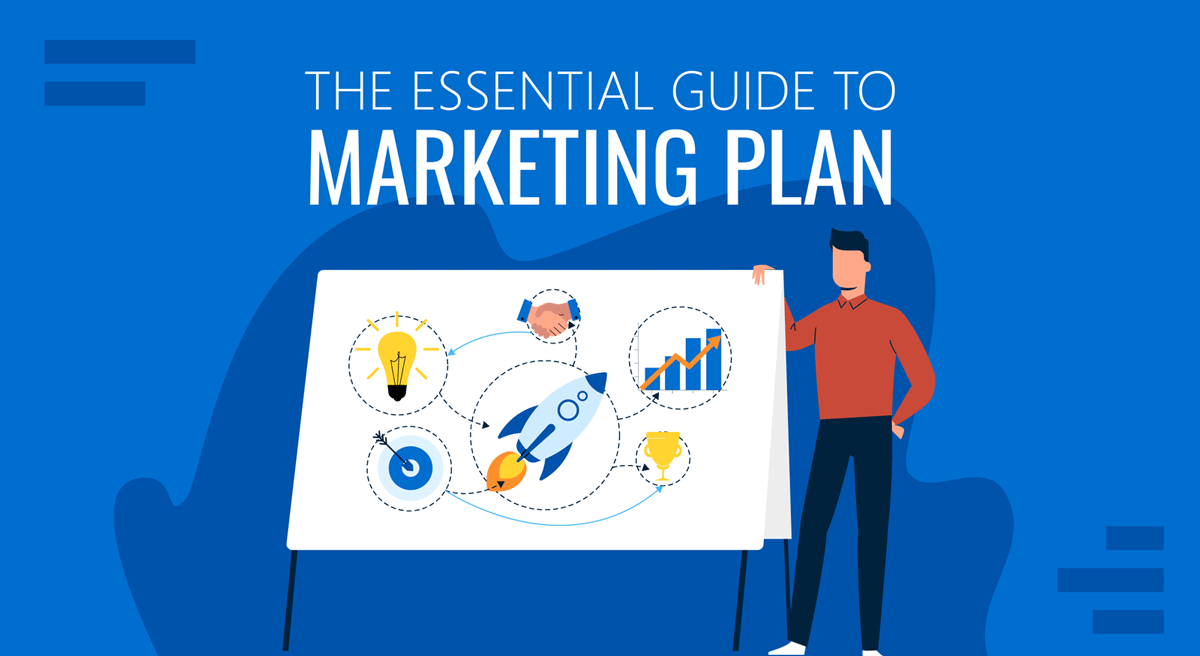
“What helps people, helps business,” explains Leo Burnett. A marketing plan is a method businesses incorporate to achieve corporate objectives aligned with their mission and statement. Still, creating a successful marketing plan presentation can become a challenge for many professionals.
What to include, which metrics should be tracked, how to present data visually compellingly, and plenty of other questions can surface when creating a marketing plan presentation. In this article, we will explore in detail all those topics and more to help you create a stellar marketing plan presentation.
Table of Contents
What is a marketing plan?
Why do you need a marketing plan.
- Difference between a marketing plan and a business plan
- Types of marketing plan
- Step 1 – Defining business goals
Step 2 – KPI (Key Performance Indicators)
- Step 3 – Building a market analysis
Step 4 – Defining the target market
- Step 5 – Defining marketing objectives
- Step 6 – Building marketing strategies
- Step 7 – Selecting marketing channels
Recommended Marketing Plan Templates for Presentations
- What are marketing tactics?
- Content Marketing tactics
- Email Marketing tactics
- Social Media Marketing tactics
- Influencer Marketing tactics
- Marketing budget
- What is the difference between a marketing strategy and a marketing plan?
Marketing Strategy Outline for an effective Marketing Plan Presentation
- Why do you need a marketing strategy?
- Marketing implementation
Tips and avoiding pitfalls when preparing a Marketing Plan
- Final words
A marketing plan outlines an organization’s advertising approach for generating leads and reaching its target market. A marketing strategy outlines the outreach activities that will be implemented over time and how the organization achieves its goals according to these actions.
According to Harvard , “The marketing plan defines the opportunity, the strategy, the budget, and the expected product sales results.” The ultimate objective of the marketing plan is to generate adequate and lucrative activity. Therefore, it should include valuable and practical instructions for allocating resources correctly.
Having a marketing plan for your business is essential, as it gives direction to advertising strategy, sales strategy, customer support strategy, etc. It provides a timeframe and implementation for the marketing strategies built.
Overall, the main items a marketing plan solve are:
- Establishing measurable goals
- Actionable consistency for business strategy
- Working within a budget for clear financials and detailed expenditure
- Improves your relationship with customers
- Helps businesses to gain new investors
- It is a powerful motivator for marketing teams
Defining your marketing plan early on has numerous advantages. Setting clear goals and objectives and matching marketing techniques to reach them can put you to success.
Moreover, while establishing a firm, marketing expenditures may be restricted, so having a clear plan guarantees you don’t squander money.
Difference between a Marketing Plan and a Business Plan
A marketing plan and a business plan are both essential tools for the success of any organization, but they serve distinct purposes and focus on different aspects of the business:
Marketing Plan: The primary purpose of a marketing plan is to outline the strategies and tactics that a business will use to promote its products or services, reach its target audience, and achieve its marketing goals.
Business Plan: A business plan, on the other hand, provides a comprehensive overview of the entire business, including its mission, vision, financial projections, operations, and long-term goals. It serves as a roadmap for the entire organization.
Marketing Plan: A marketing plan is a subset of a business plan, focusing exclusively on the marketing aspects of the business. It delves into the specifics of how the business will attract and retain customers.
Business Plan: A business plan encompasses all aspects of the business, including marketing, finance, operations, and management.
Time Horizon
Marketing Plan: Marketing plans typically have shorter time horizons, often covering a year or less, and are more tactical in nature.
Business Plan: Business plans have a longer time horizon and often outline the company’s goals and strategies for the next three to five years or even longer.
Marketing Plan: The primary audience for a marketing plan includes marketing teams, sales teams, and other departments involved in implementing marketing strategies.
Business Plan: Business plans are intended for a broader audience, including potential investors, lenders, stakeholders, and company executives.
Marketing Plan: Content in a marketing plan typically includes market analysis, target audience profiles, marketing objectives, strategies, tactics, budget, and key performance indicators (KPIs).
Business Plan: A business plan includes sections on executive summary, company description, market analysis, organizational structure, financial projections, and more.
In summary, while a marketing plan focuses specifically on the marketing strategies and activities of a business, a business plan provides a comprehensive overview of the entire organization, including its marketing efforts, financial outlook, and long-term goals. Both plans are crucial for a company’s success, and they often complement each other in achieving overall business objectives.
Types of Marketing Plan
Marketing plans can take various forms depending on the specific needs and goals of the business. Some common types of marketing plans include:
- Annual Marketing Plan: This is a comprehensive marketing plan that outlines the marketing strategies and tactics for the upcoming year. It typically includes a detailed budget and specific objectives for the year ahead.
- Product Launch Marketing Plan: This type of plan is focused on the launch of a new product or service. It includes strategies for generating buzz, attracting early adopters, and achieving a successful product launch.
- Digital Marketing Plan: In today’s digital age, businesses often create specialized plans for their online marketing efforts. This plan may cover areas such as website optimization, social media marketing, email marketing, and online advertising.
- Content Marketing Plan: Content marketing plans focus on creating and distributing valuable content to attract and engage the target audience. This can include blog posts, videos, infographics, and more.
- Social Media Marketing Plan: This plan centers on strategies for building and maintaining a strong presence on social media platforms. It includes content calendars, posting schedules, and engagement strategies.
- Event Marketing Plan: For businesses that participate in or host events, this plan outlines the marketing strategies for promoting and maximizing the impact of those events.
- Branding and Rebranding Plan: Businesses looking to establish or reposition their brand in the market create branding or rebranding plans. These plans focus on building a strong brand identity and messaging.
- Crisis Management Plan: In the event of a crisis or negative publicity, this plan outlines strategies for managing the situation and mitigating damage to the brand.
The choice of marketing plan type depends on the specific goals and priorities of the business. Some businesses may also create a combination of these plans to address different aspects of their marketing efforts.
The Anatomy of an Effective Marketing Plan
Step 1 – defining business goals .
Your company’s marketing goals and objectives could be to promote the brand, name, and logo design , expand into a new market, or improve product marketing by a certain percentage. These objectives can be better tracked, measured, and duplicated if they are more defined and numerical.
Understanding high-level marketing and company objectives is the first step. These should form the basis of your strategy. The work can be grouped according to its objectives, allowing your teammates to see the plan behind your operations. Defining your business goals will also assist you in determining whether or not the programs and campaigns you launch are on schedule.
Those who write down their goals are more successful than those who do not. You can set goals using various methods, including the SMART Goals method . Your marketing team can use the SMART Goals method to explain your company’s long-term objectives, make adjustments, and develop promotional activities. SMART stands for Specific, Measurable, Achievable, Realistic, and Time-bound. These objectives give you a framework for choosing the most efficient marketing strategy.
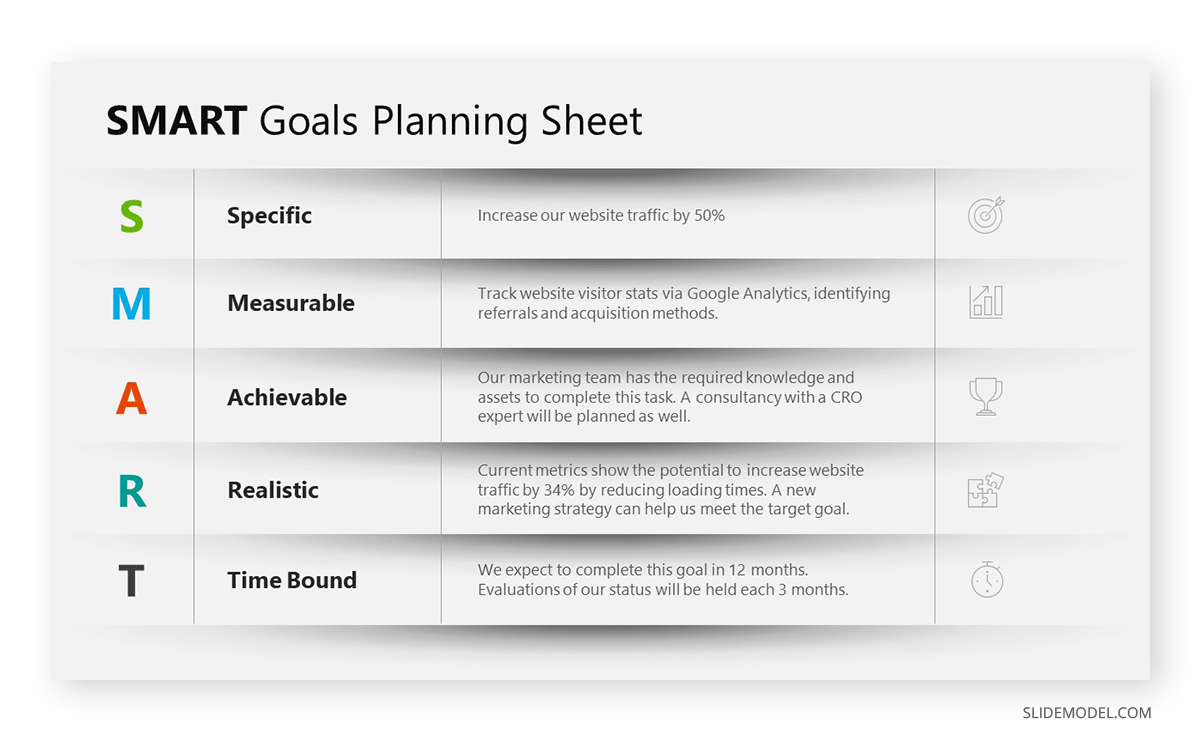
KPI, also known as Key Performance Indicators, is a collection of quantitative measurements a firm or sector uses to assess or compare performance in accomplishing strategic and operational objectives. Measurable KPIs allow you to establish a sense of ownership and accountability for your company goals. They’re necessary for completing any company plan actions. A KPI dashboard (a collection of pre-selected and relevant KPIs) shared with a specific team can motivate by offering concrete insight into the team’s performance and improving peer efforts.
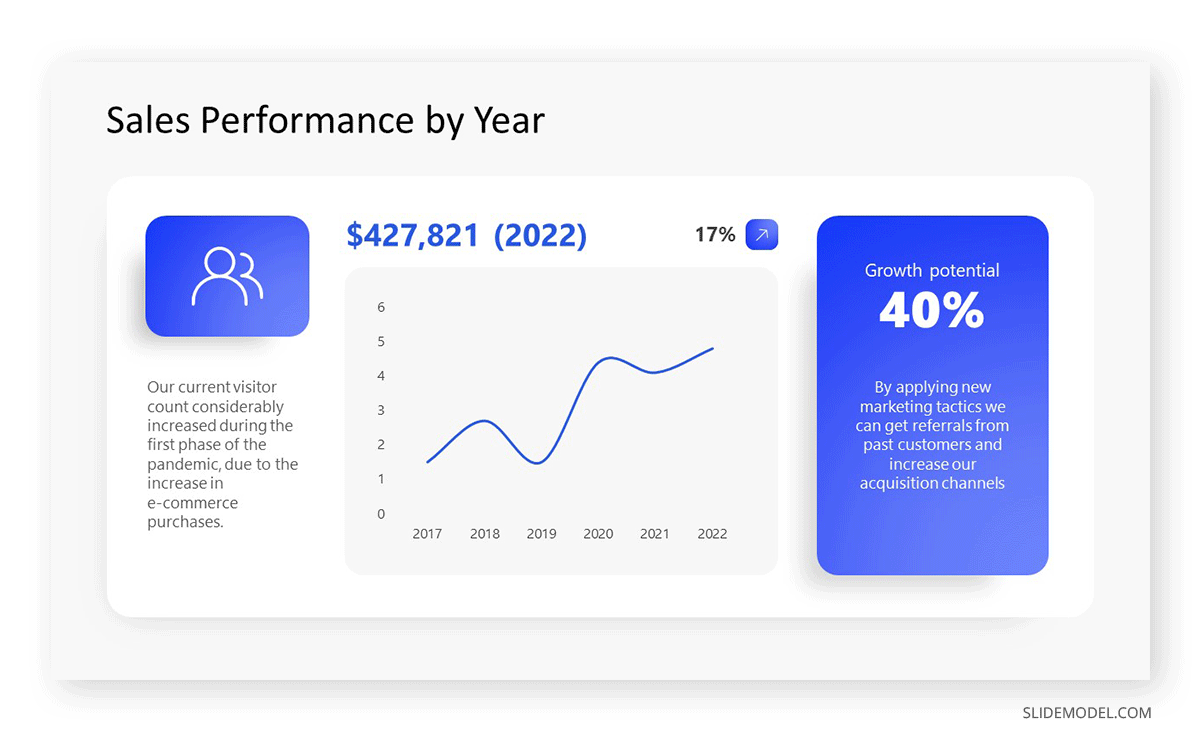
Step 3 – Building a Market analysis
Marketing environment.
A marketing environment refers to all internal and external aspects influencing and driving your company’s promotional efforts. Your managers should know the marketing environment to sustain success and address any threats or possibilities that may affect their work.
Understanding the marketing environment is critical in recognizing what your customers desire. You would require a marketing environment because it helps to identify your target audience and their demands, particularly when it comes to how customers make purchasing decisions. Evaluating your marketing environment allows your company to create effective marketing strategies before too late.
The marketing environment is wide and varied, with controllable and uncontrollable variables. There are two types of marketing environments to consider: internal and external environments.
Internal marketing environments include your company’s strengths, limitations, distinctiveness, capabilities, capital assets and finances, and corporate policies.
To be precise, all the elements that are under your control have an impact on your marketing operations.
All aspects outside your company’s control are included in the external marketing environment. The external marketing environment is divided into micro and macro marketing environments.
The marketing microenvironment is inherently related to your company and directly impacts marketing procedures. Buyers, manufacturers, company associates, distributors, and opponents are included. To some point, it can be possible to control microenvironmental influences.
All things outside your company’s control make up your macro marketing environment. External environmental forces such as competitive, economic, political, legal and regulatory, technological, and sociocultural parties are considered in the environmental analysis. A marketing strategist can be efficient only by accepting and comprehending the intricacies of the marketing environment.
Competitor analysis
A competitive analysis is a method of identifying competitors and evaluating their strengths and weaknesses compared to your own. It assists you in determining how to deal with competition and fine-tuning your plan. It is essential to conduct a competitive analysis because it will help you to create effective competitive strategies to expand your target market.
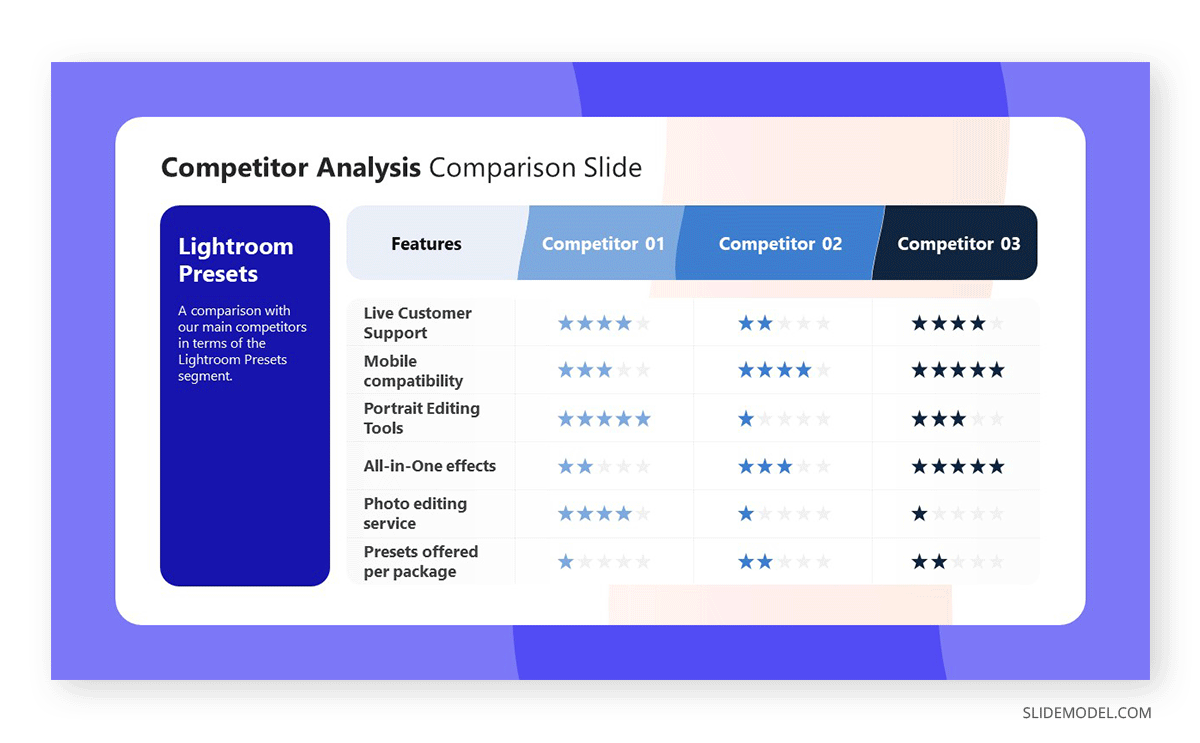
First of all, identify who your competitors are and what products they offer. Take note of their marketing strategies. You’ll be able to design methods to help you stay ahead of your main competitors using the information from the competitive analysis.
SWOT analysis
A SWOT (Strengths, Weaknesses, Opportunities, and Threats) analysis is an excellent method to determine how you match up against your market competitors. It is one of the most effective strategies for eliciting the most significant difficulties your company faces today and in the future. It is an integral part of any marketing strategy.
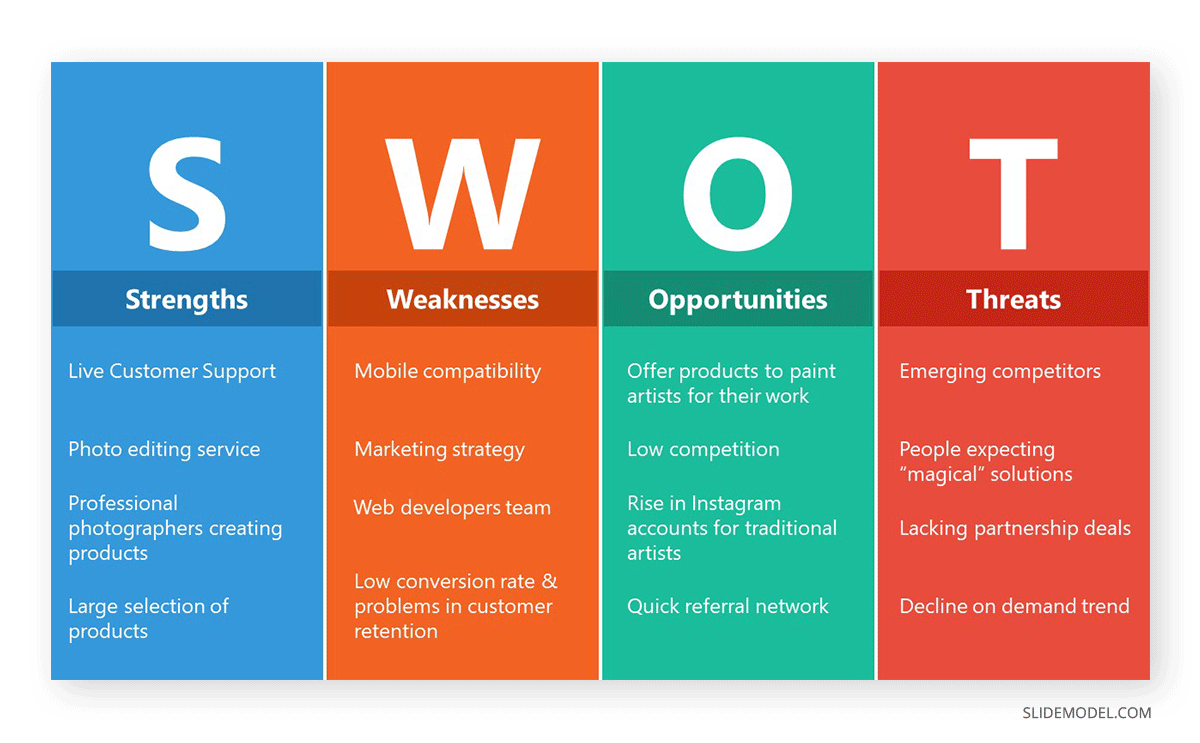
You can use a SWOT analysis to look at your company’s strengths, weaknesses, opportunities, and threats. This activity might help you determine where your company stands in the competitive marketplace.
With SWOT analysis, you’ll have a promising approach for prioritizing the tasks you need to perform to build your business. If you want to get in and start, feel free to download our editable SWOT PowerPoint templates .
Since you’ve performed your analysis, the next step is to focus on your target market.
Once you have assessed precisely whom your company wants to cater to, it will be easier to choose which marketing strategies. Your marketing and communication channels must be tailored to your target audience. Age, gender, geographic region, likes, interests, and other demographics can be associated with audience criteria.
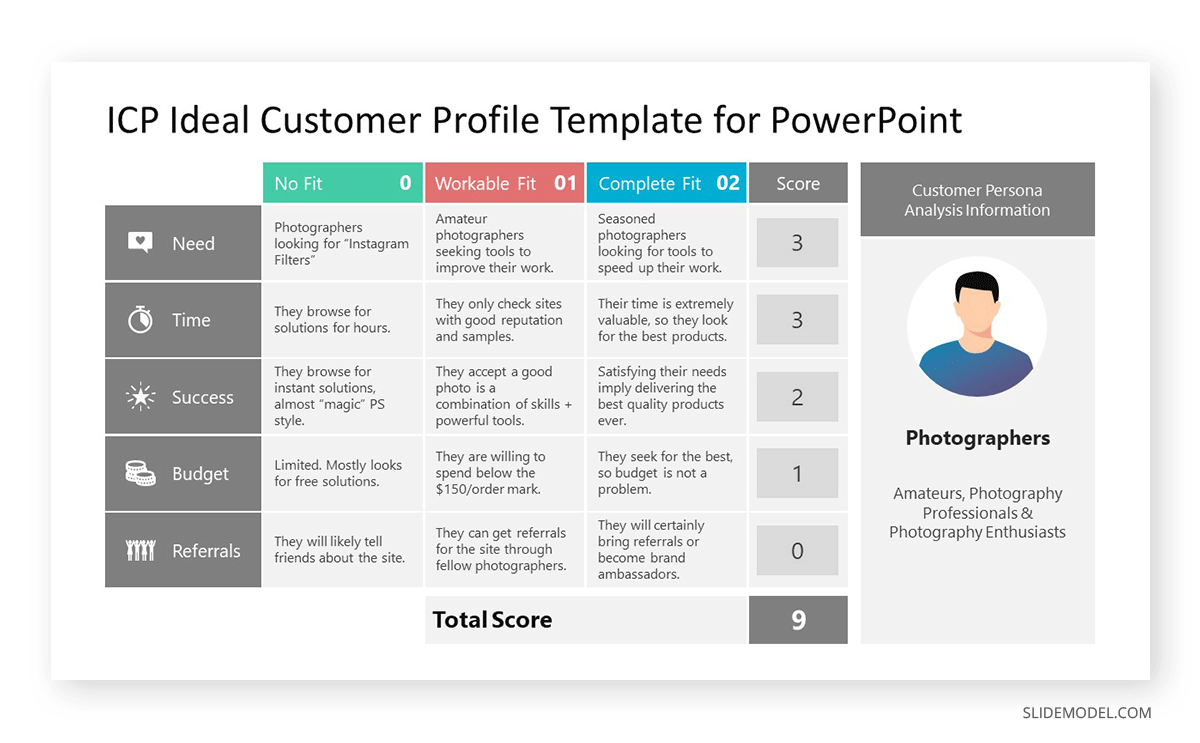
To help you with the process, create different customer profiles or perform market segmentation. By focusing on commitment to service and quality, you can effectively implement a niche differentiation strategy in a somewhat diverse marketplace.
Market Size
The size of a market is one of the most important criteria for evaluating a business plan because if the market is too limited, expansion and funding are not worthwhile. As a result, determining the market size is an integral aspect of every business marketing plan.
TAM stands for “Total Addressable Market”
The TAM reflects the broadest market potential imaginable. It solves who might buy goods or services in general. The TAM is the potential profit a single firm could make in this market.
SAM stands for “Serviceable Addressable Market”
The SAM provides a solution to which TAM market share can be addressed with the particular product or service in view or which could reasonably buy it. The SAM is important since it demonstrates the moderate potential of your business plan. The target audience is outlined and accurately described at this stage.
SOM stands for “Serviceable Obtainable Market”
Lastly, the SOM depicts the SAM’s market share that can be practically obtained over a predictable timeframe. It considers the current market environment, production capabilities, promotion, and distribution channels. As a result, the SOM represents the sales potential of your business during its early stages of growth.
The above are crucial components of a company’s strategy, especially as you develop your sales and marketing plan, make appropriate revenue targets, and decide which markets are worth your time and money.
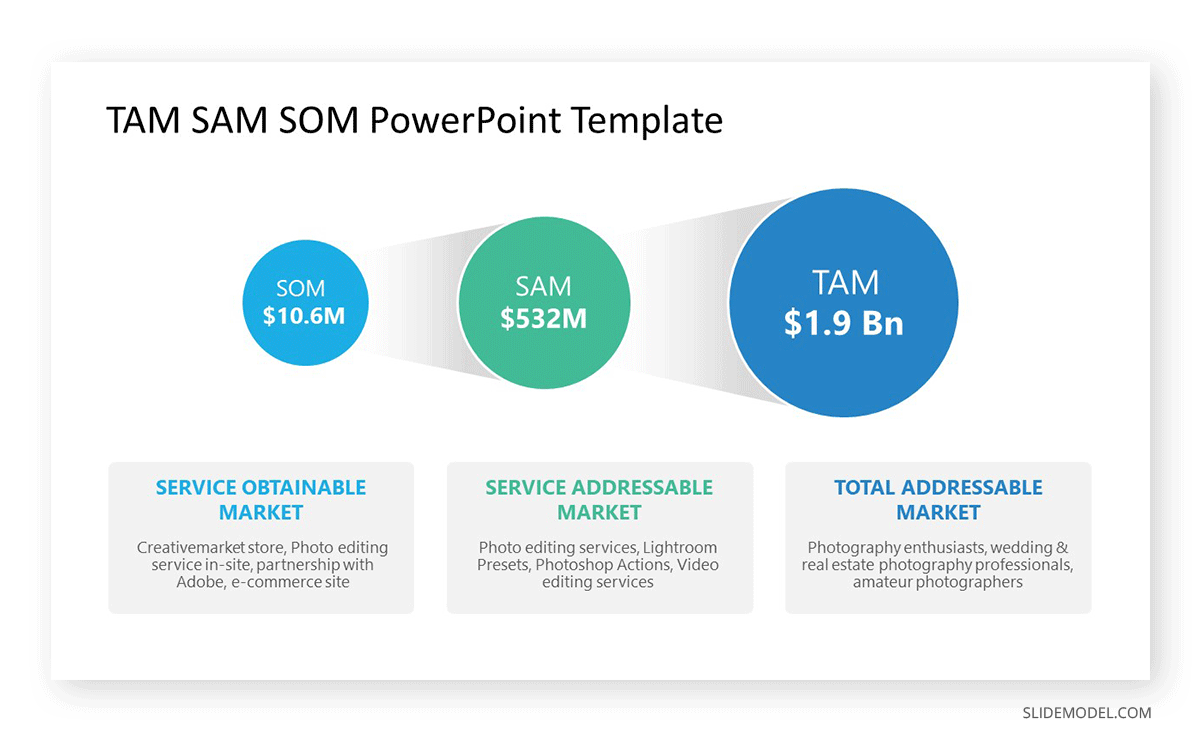
Unique Selling Proposition
Your company’s unique selling proposition or USP indicates the unique advantages that your company provides, and hence provides the basis for differentiating you from your competitors.
A strong USP helps to reach your target audience and achieve your company goals by distinguishing your goods in a significant and exclusive way. It makes your marketing content effective and attractive to potential consumers. Your USP concept should reflect throughout your products and marketing strategies.
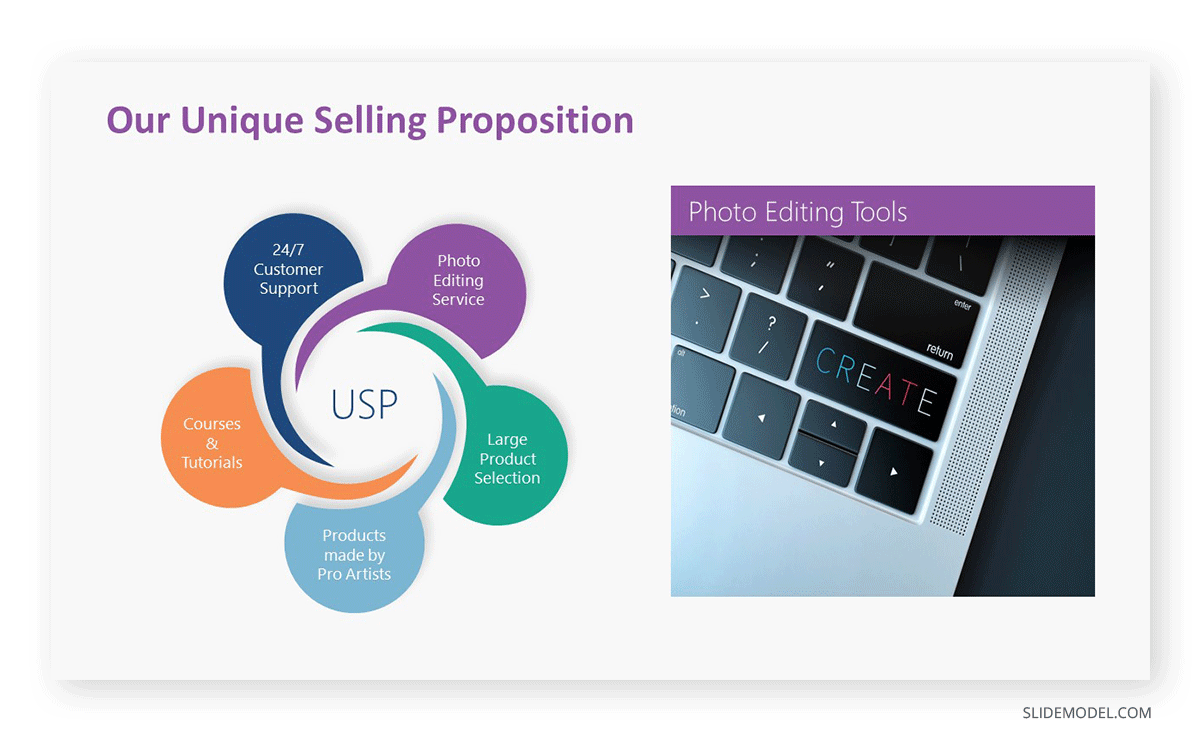
Step 5 – Defining Marketing objectives
Formulating marketing strategies and organizational marketing practices is based on the marketing objectives. The marketing objectives declare what you intend to achieve in the marketplace. The internal and external environmental analysis outcomes significantly impact the marketing objectives plan.
Marketing objectives are both economic and market-psychological objectives. Financial goals are responsible for higher turnover, i.e., they use desirable outcomes to affect sales quantity and price. The company’s goals and objectives must be established in concrete terms so that the concerned managers can evaluate performance and, if needed, take remedial action. Increased product awareness among targeted consumers provides information about product features, and increasing consumer willingness to acquire the product are some of the goals for a specific product.
Market-psychological goals are a variant of marketing objectives with a focus on quality. They represent intentional, purposeful changes in future client purchase behavior that correlate to financial aims driving a company’s marketing initiatives. Brand awareness , business model, buying intensity, customer service, and product are suitable for qualitative expected values.
Before moving on to the next level of planning and designing the marketing strategy, you must understand the marketing objectives.
Step 6 – Building Marketing strategies
Let us discuss various marketing strategies to Boost your Business Growth.
Marketing mix and its importance
The marketing mix is a significant component of developing and executing a successful marketing strategy. It should demonstrate how your product or service is preferable to your competitors.
The marketing mix describes the many aspects of your company’s market strategy. It is a diverse list of elements your company uses to attain its goals by effectively marketing its goods or services to a specific consumer segment.
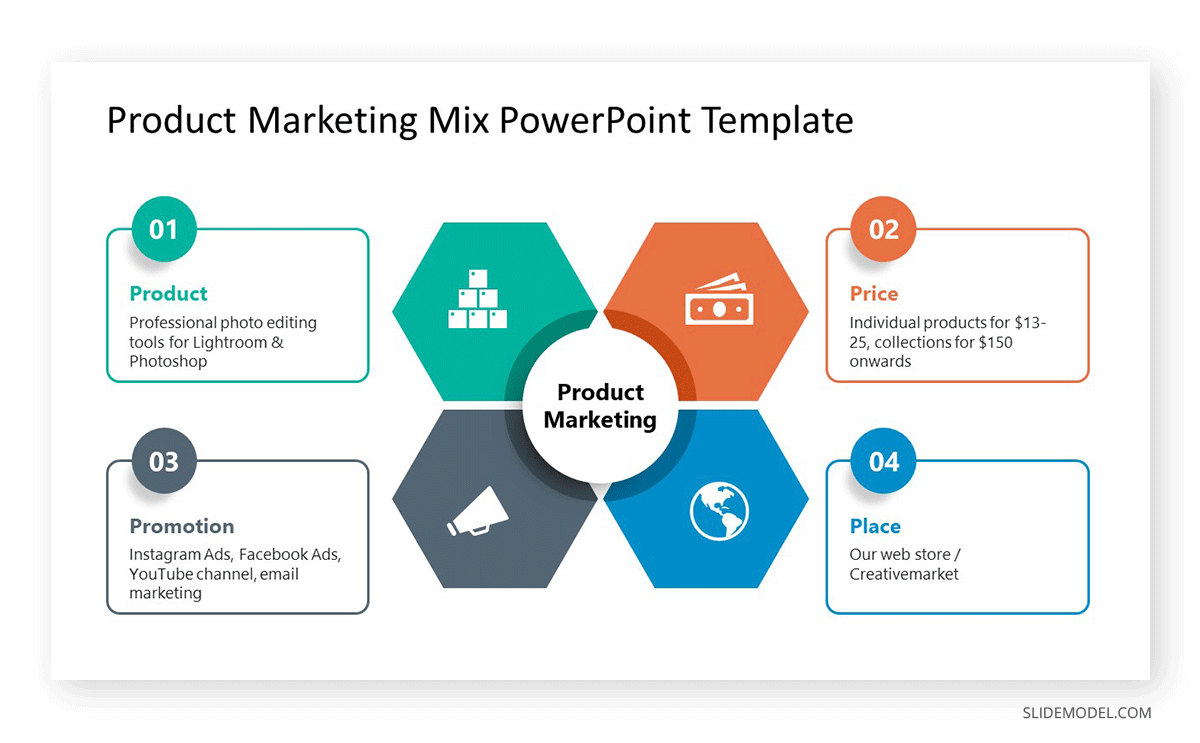
The marketing mix, commonly known as the 4 Ps, comprises four major components: products, price, promotion, and location. The 4Ps are the most essential components to consider when developing a marketing plan. A variant of the services marketing mix is also known as 7Ps Marketing Mix, and includes the addition of people, processes, and physical evidence to the list.
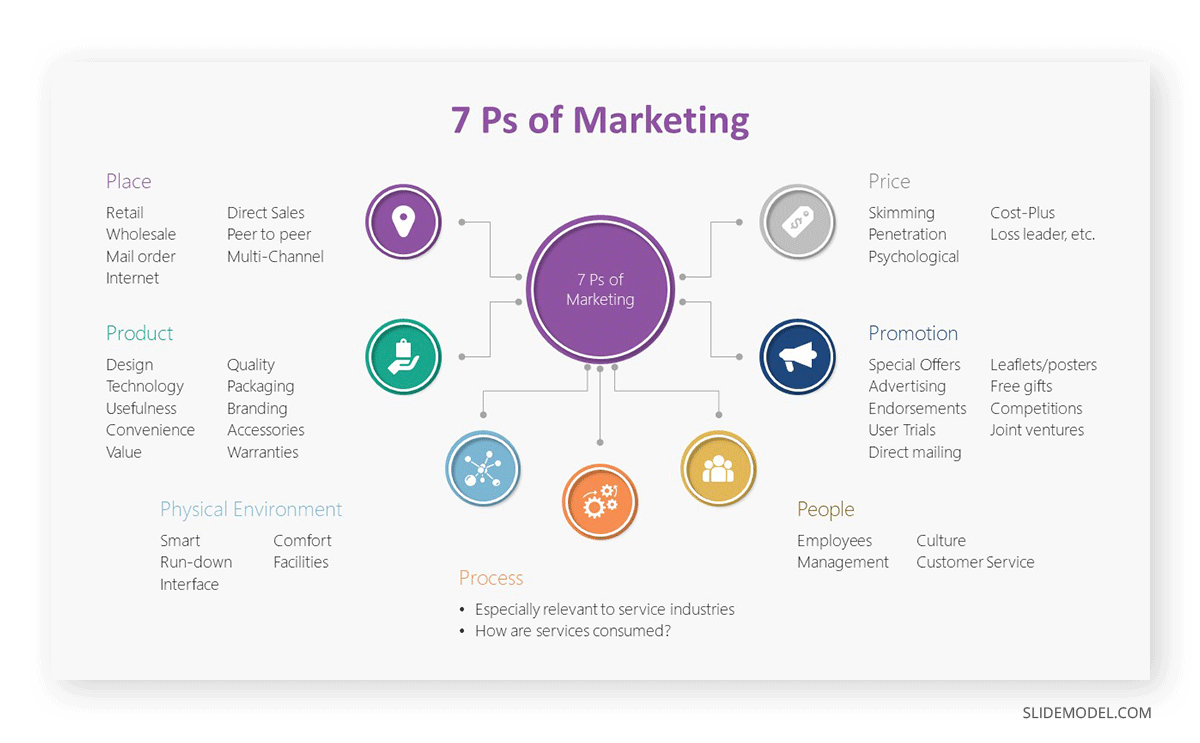
Product development aims to create the best product or service for your target market. Your goods or services must meet every individual client’s demand.
The first P consists of two main elements:
Branding is the name, term, symbol, and design by which your product is known. A strong brand name can help shoppers recognize the goods they desire faster, which speeds up purchasing.
Packaging entails advertising and safeguarding the product. It can improve the use of a product or keep it from degrading or being damaged. Quality packaging makes it easy to recognize your products and promote your reputation.
When deciding on a price for your goods, analyze the competition in your target market and the whole marketing mix’s cost. Estimate how customers will react to potential product prices.
Pricing and Positioning Strategy
Pricing and positioning strategy determine how you want your customers to recognize your products and services compared to your competitive brands. Your pricing and positioning strategy must be aligned; your product’s price should be according to its position in the market. Consider your competition, target audience, and running expenditure while deciding on your positioning and pricing plan.
Here are different types of pricing strategies:
Price Skimming
This strategy is often used when you have a high-priced brand offering that too very unique in the market. Basically, it is linked with highly valued or luxury products. When your product is new, you want to generate sales, and as it grows more prominent, you wish to acquire a wide range of consumers.
Penetration Pricing
Penetration pricing is the complete opposite of price skimming. Companies utilizing a penetration pricing approach have a low-priced product to capture as much market share as possible rather than going to market with a high price.
Time-based Pricing
In the holiday sector, time-based pricing is employed to maximize revenues during summer, when resorts are often busiest. When an airline’s aircraft is nearing capacity, it also charges extra. If there is spare space and a short time before departure, it also offers bargains. This strategy is based on delivering a product or service faster by increasing the prices.
Value-Based Pricing
This strategy ignores the cost of production and instead focuses on using the value customers gain from the price of a product or service. This strategy can be used when your product or service is good enough not to be replaced with an alternative.
This includes all the considerations that go into getting the correct product into the hands of your target market. Customers should expect to locate a product or service like yours where placement decisions, such as accessing the proper distribution channels, are made. The layout of your store or shop is also a part of the location decision. It should entice people into your store and simplify finding what they’re looking for.
Telling your target market about your goods or service is the goal here. It entails direct communication between potential customers and sellers.
Your marketing mix will assist you in promoting suitable goods to the right people at the right price and at the right time for your company. Therefore, your marketing mix serves as a blueprint for achieving your business goals. It provides a sense of direction while reminding you to think about your target market.
Step 7 – Selecting Marketing Channels
Where does your target audience spend most of their time? Is it social media or reading newspapers or online periodicals? When you know what they prefer more, you can better select the channel of marketing you want to use in your strategies.
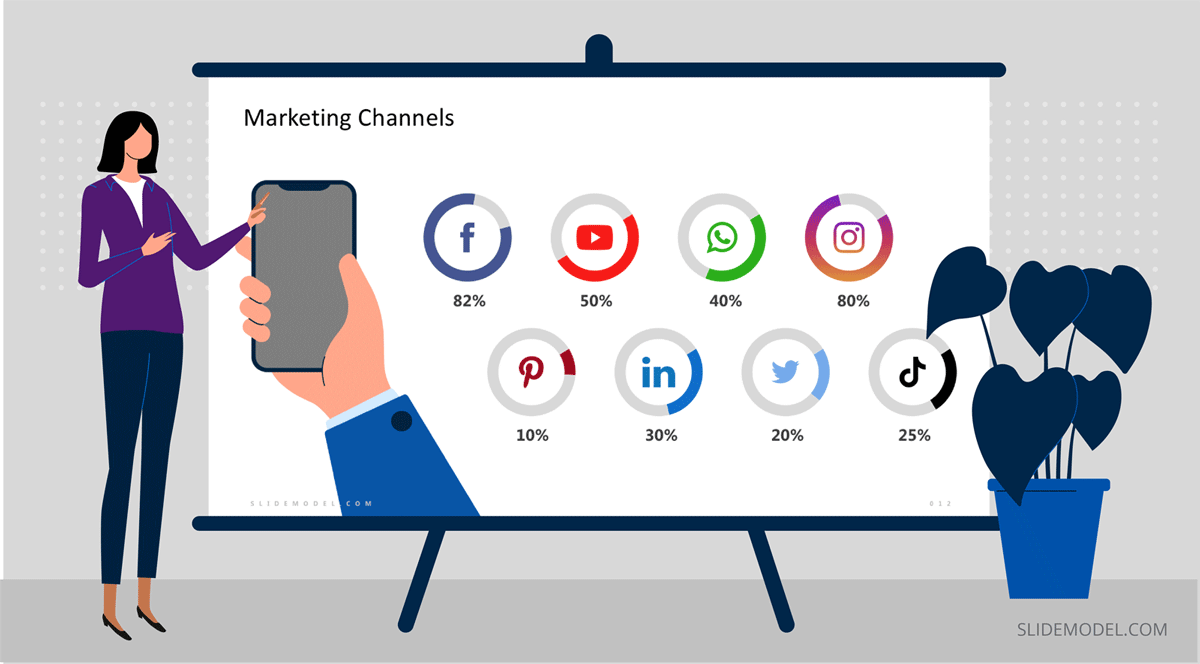
Here are different methods of marketing:
Outbound Marketing
Outbound marketing is a sort of marketing that includes pursuing clients rather than allowing them to approach you naturally. This strategy, which entails employing cold calls, Television ads, and print ads as the significant way of recruiting clients before digital marketing became a regular practice, was prevalent before digital marketing became a common practice.
Outbound marketing includes social ads, search engine marketing (SEM), native advertising, and traditional commercials, among other forms of paid advertising. It is still a popular digital marketing strategy today. For example, email blasts, which are bulk email campaigns delivered to an extensive list of subscribers, are still a popular advertising strategy.
Inbound Marketing
Inbound marketing is a general term that includes almost all forms of marketing, from social media to content. Inbound marketing tries to lure clients by leveraging various forms of content, such as blogs, videos, podcasts, social media, and newsletters. As for the podcasts, they are easy to start. Besides, people love to listen to podcasts , as they can do it anytime and anywhere. The content engages your clients, making them happy and building lifetime trust in your brand.
Content marketing is one of the most common inbound marketing strategies you can learn more about further down.
Inbound marketing is gaining popularity because it draws them to you rather than interrupting people with intrusive advertisements. Because consumers are actively looking for your material, inbound marketing is effective. With the help of an Inbound Marketing PowerPoint template , digital marketing professionals can save hours of effort and time and prepare presentations with the conclusions of a marketing analysis campaign.
Digital Marketing
Digital marketing isn’t a specific strategy by itself; instead, it’s a direct reference to any digital technology marketing. Digital marketing has taken the marketing world by storm. Almost every sales and marketing expert widely uses it. With digital marketing, marketing has grown to reach clients in new and more intriguing ways due to advanced technologies. This marketing channel focuses on business growth, which is crucial for the growth strategy.
As you read, you’ll know that most of the marketing types we will discuss are a form of digital marketing. Some of them are:
Content marketing
Email marketing, social media marketing, advertising.
Each type of marketing is vital to the whole, and they all work together to create a comprehensive digital marketing strategy.
While so many digital marketing platforms are available, selecting them in a way that works for the company’s goals and, especially budget, can be challenging. Paid, owned, and earned media classifies various channels into segments that make creating and enhancing effective marketing strategies easier.
Paid media is content you pay to be placed before your viewers as an advertisement, such as ads on social media, whereas owned and earned media is free. Owned media refers to the content you make and maintain, such as your website, blog posts, or Facebook page. In contrast, earned media refers to content created about you by others, such as influencers or reviews of your product.
When drawing readers to your website, content still comes out on top. Users are drawn to your website by relevant content, keywords, and offerings. A well-developed content marketing strategy can help you customize content for your client’s needs and gain genuine traffic.
With Google’s MUM algorithm update , websites with well-written content created in natural language are expected to rank higher. Create a well-thought-out strategy for delivering high-quality content regularly, allowing your company to gain genuine traffic and reduce bounce rates. Good solid content should have concise headlines, relevant data sources, and answers to any readers’ issues.
According to recent statistics, more than 85% of marketers utilize email as their primary lead-generation medium. In the case of email marketing campaigns , you must send the correct kind of message to your target demographic to remain effective. Email marketing is done correctly, establishes a relationship with your clients, and earns their confidence. Include exciting information like blog articles, user-generated content, and videos in your emails. Customize emails by including information like first names and tailoring material to the client’s interaction with your site.
Social media has made a lot of progress since its beginning, and it is now one of the most widely used marketing channels. YouTube and Facebook remain the most popular social media platforms, with Instagram and Pinterest coming in second and third, respectively.
A social media marketing strategy that emphasizes brand recognition, customer interactions, and captivating posts can help you establish a solid social media profile and attract consumers to your products and services. To enhance interaction with your target market, focus on generating effective communication strategies across all social media channels and creating video content.
There are various advertising options to consider for your company—the alternatives for advertising range from social media to television and print. One thing is sure online advertising is a practical approach to getting the attention of your target audience. It enables you to more precisely target, monitor, and assess the effectiveness of your paid marketing campaign more.
To grow in the digital advertising industry, learn how to advertise on Google. Because Google is the world’s most popular search engine, you’ll want to keep ahead of the competition by appearing for essential keywords relating to your services.
Influencer marketing
Influencer marketing is partnering with influencers (people who already have a large following) to use the potential of Instagram and other social media. These persons are considered experts in their fields, and their followers will listen to their advice. Influencer marketing can put your brand and an e-commerce business on the map. When an influencer endorses your product, it immediately earns credibility in the eyes of their followers. As a result, your brand will acquire more visibility and attract new clients. Influencer content is a marketing technique that will continue to grow in the coming years.
Because many influencers rely on paid advertising for income, they typically demand payment in exchange for endorsing your company. You’ll effectively be sponsoring one of their social media postings in this situation. Evaluate which collaborations will be most beneficial to your market and budget.
Affiliate marketing
You might wonder, what is affiliate marketing? It is similar to sponsored collaborations in which others market your business on your behalf. By establishing an affiliate marketing program, you’ll eventually partner with another affiliate who will promote your products on their social media sites, blogs, and other platforms. Their sales are recorded using special links known as affiliate links, which allow the individual to be paid for their efforts.
This type of marketing is becoming increasingly popular, and more businesses are launching their affiliate networks. As a result of this increase, many companies now use affiliate marketing as part of their entire marketing plan.
Landing pages
A landing page is a best friend for the marketer. Conversions are the sole objective of this standalone page. Regardless of how good your various online marketing techniques are, your landing pages and website must convert at a reasonable rate to justify your efforts. A one-second delay in page loading time causes a likely decline in conversions. Landing pages should have a powerful message, optimized headers, and helpful content to be the most effective. Stay updated on landing page best practices to improve your website conversion rate.
As we know, this process can be taxing, especially if the deadline is around the corner; please check our suggestion for marketing plan templates . These products were designed by professionals, and are intended for visual impact, clear data presentation , and reusable purposes.
1. Marketing Plan PowerPoint Template

Building a marketing plan from scratch with this slide deck is a stress-free experience. You can find a welcome message slide, followed by an introduction slide in which you can present the reasons behind a new marketing plan. The table of contents for this presentation template is shown as a horizontal timeline, so the audience can transit through each element.
Key slides such as About Us, Mission, Team, and USP are listed, with icons and placeholder text areas that are quick to edit. TAM, SAM, and SOM model are also included in one slide. If all this isn’t enough, reinforce your message with a demographic slide to introduce your ICPs and analyze competitors with the Market Competition slide arranged in a bar format.
Use This Template
2. General Marketing Plan PowerPoint Templates
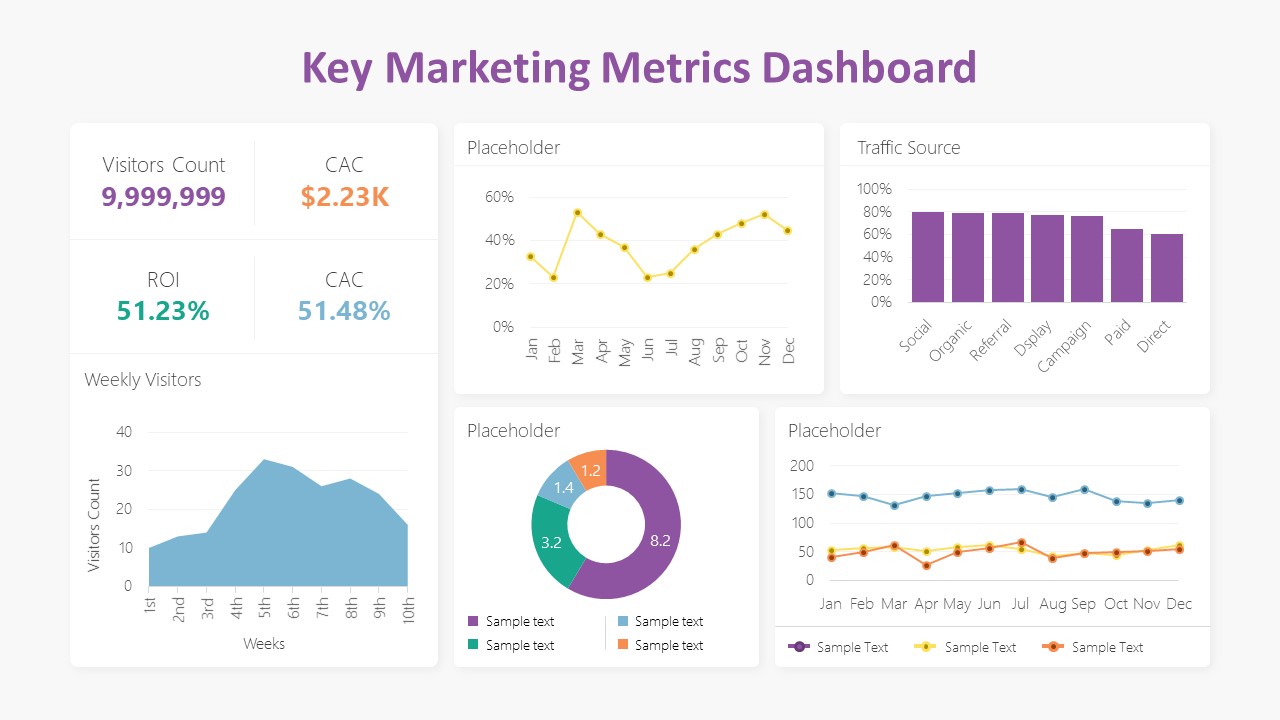
Some of the slides shown in this article belong to this presentation template design. Vibrant, with a clear design for showcasing data in multiple marketing formats: TAM, SAM, and SOM; KPI Dashboard; USP; Pricing strategy; 7Ps of Marketing Model Mix; Segments; Budget; Product Life Cycle, etc.
Create a powerful marketing plan presentation by editing this professional marketing plan presentation template in just minutes.
3. Marketing Plan PowerPoint Presentation Template
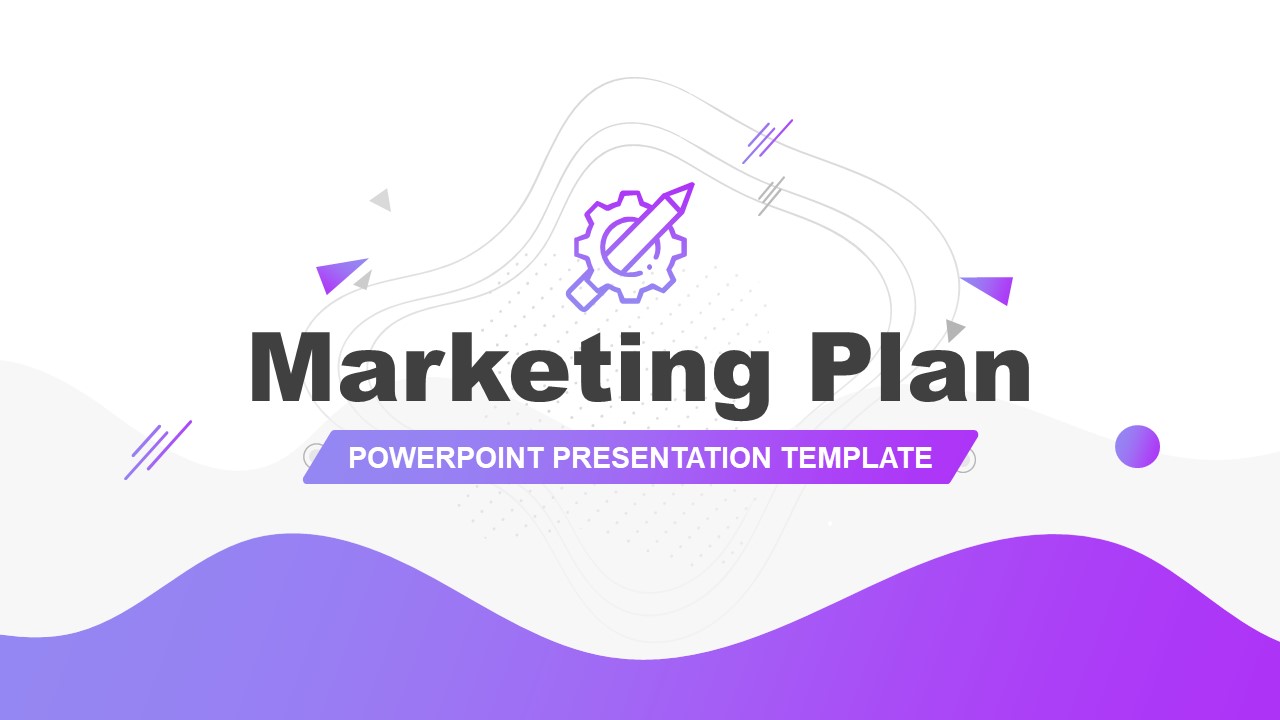
This fresh marketing plan presentation template is a slide deck featuring various graphics to showcase data. The strong contrast of the tones used helps to introduce multiple topics with a clear understanding from the audience. On top of that, the template is entirely editable, so you can select a custom theme with your preferred color scheme.
Find catchy graphics to discuss Market Segmentation; Target Market; Growth Strategy; Plans & Pricing, etc. 13 slides containing everything you need for a stellar marketing plan presentation.
4. Blue Marketing Plan Template for PowerPoint

Ideal for corporate environments, this classic-styled marketing plan template brings every tool available for building a marketing plan. With blue & white tones in the main areas, you can find 2D & 3D graphics in 4 different colors that complement the palette.
Access funnel analysis diagrams, world maps for demographic representations, cycle process flow diagrams, 4P Marketing Mix, 3D cubes, roadmaps, and more.
Since we understand it can be challenging to mix and match template slides for a custom presentation layout, we created a tool intended for presenters using our years of expertise in the field for the best user experience. Try our AI Presentation Maker and create an entire marketing plan presentation slide deck in seconds.
Marketing Tactics
What are marketing tactics.
Marketing Tactics are the strategic measures that drive the advertising of your company’s products and services to achieve the defined marketing goals. Your marketing strategy and your company goals and objectives will determine the basis of marketing tactics. The purpose of some marketing tactics might be to promote your content to reach your target audience, while for others, it might be to maximize sales yet maintain a competitive product or service. As a matter of fact, you can leverage a variety of marketing tactics. Especially if you have a well rounded idea of the strategy from a digital marketing course .
Content Marketing Tactics
Focus on content transparency and authenticity Your consumers may want to know your new product ideas, how you create your product, or even your revenue numbers. If you reveal to your audience what they want and meet their demands, you may directly connect to your audience. For this, your content must be transparent and authentic.
Dynamic CTAs Dynamic CTAs are elements of personalization that create a unique call-to-action based on the viewer. It makes the content more personalized therefore generating more traffic to your site.
Search Engine Optimization (SEO) Create content and improve your online services to make it easier for those seeking specific information.
Use Emotional Keywords in Headlines The most effective technique to write compelling headlines is to use emotional keywords. This will give your content a boost. People will be prompted not only to read it but also to forward it on social media. Also, you can add headlines showing data. Create high-quality content to grow your search traffic and rankings.
Email Marketing Tactics
Personalization In the email subject line, you can add the name of the person you are interacting with. It gives a personal touch.
Automate Referral Campaigns Set up automated referral campaigns via email via your CRM or another technology that allows you to automate your email marketing CRM .
Set up automated referral campaigns via email via your CRM or another technology that allows you to automate your email marketing CRM. Make sure you use a quality email finding tool . This way you will get more clients. Deployment of email authentication protocols like DMARC can have a lasting positive impact on your email deliverability rates, making your marketing campaigns more of a success by reducing spam.
Social Media Marketing Tactics
Use social media platforms to generate traffic Social media platforms like Instagram , YouTube are the most used platforms to connect and engage potential consumers.
Live streaming To engage your audience, you need to communicate with them directly. Live streaming allows you to reach more people and thus maximize your social media presence.
Customer Testimonials Testimonials directly from your customers’ words express appreciation for and faith in your service and products, providing a positive review of your company.
Influencer Marketing Tactics
Influencer-driven product launches Influencers are considered experienced in their niches, so their followers happen to trust the products promoted to them.
Influencer Endorsements/Sponsorships One of the most effective ways to encourage consumers to trust your products is through influencer sponsorships .
Marketing Budget
You’ll need a comprehensive and practical marketing budget to implement a marketing strategy successfully. Your budget should be suited to your company’s unique qualities. Your business stage also determines your marketing budget. Once you decide which marketing channels you will use, you can define your marketing budget.

You must recognize the role of marketing in assisting your company. Specific methods can be defined from there. Then, to correctly and fairly measure marketing success, you must define KPIs to connect the budget with your goals. Choosing how much money to invest in marketing is a big step, but deciding when, where, and how to spend that money is far more complicated – and has a considerably more significant impact on your company’s performance.
What is the difference between a marketing strategy and a marketing plan?
A marketing strategy is reaching out to potential customers and converting them into paying customers. A marketing strategy is different from a marketing plan in its approach. It is a larger picture of how you intend to remain ahead of your competitors.
On the other hand, the marketing plan systematically lays out the specifics of how you’ll put your strategies into action. Your marketing plan is the framework of strategic marketing actions that help you reach your marketing goals and is driven by your marketing strategy.
Your marketing strategy is an essential aspect of your overall business plan. This outline is intended to assist you in thinking through areas of your proposed business plans and the market channels you will use to reach your target market. A strong marketing plan involves everything from identifying your target clients to how you will reach them to how you will create repeat purchasers, whether you are just starting your firm or thinking about expanding your operations.
Your marketing strategy is the roadmap you’ll follow to gain customer loyalty and boost your company’s success. Use the following slides outline to create an engaging marketing plan presentation:
- Executive Summary Slide : A brief overview of your marketing plan
- Business Goals Slide : Represent precisely what your business depicts
- A. Identify your target customer.
- B. Identify your direct and indirect competition and state how your business will differ?
- Market Objective Slide : Define the economic and market-psychological objectives of your business.
- Market Strategies Slide : Identify how you will achieve the set targets in the market.
- Marketing Channels Slide : Identify the methods via which your potential clients communicate with your competition.
- Marketing Strategies Slide : Present a clear and coherent image of how you intend to market/sell your product/service and how these techniques will result in profit.
- Marketing Budget Slide : Identify the amount of money you will require to sustain in the market.
- Marketing Implementation Slide : Set and apply realistic and tangible goals to evaluate your marketing success
Why do you need a marketing strategy?
The marketing strategy should come prior to the marketing plan, as it is the grounds on which the marketing plan should be arranged.
The main reasons why you need a marketing strategy are:
- Defines the goals to be measured in the marketing plan
- Helps to define vision and long-term objectives
- Helps to decide which marketing channels the efforts should be focused on
- Allows companies to address where the money should be spent
- It becomes the guidance to build a marketing plan, and your reference point when questions arise
Establishing your marketing strategies beforehand has numerous advantages. You are on the path to success when you define your goals and KPIs and integrate marketing techniques to attain those goals.
Marketing Implementation
Marketing implementation is bringing your marketing strategy into action to generate favorable results. A marketing implementation plan ensures the appropriate execution of your marketing strategy. It breaks down your marketing strategy into manageable activities, responsibilities, and objectives that are easy to grasp and follow.
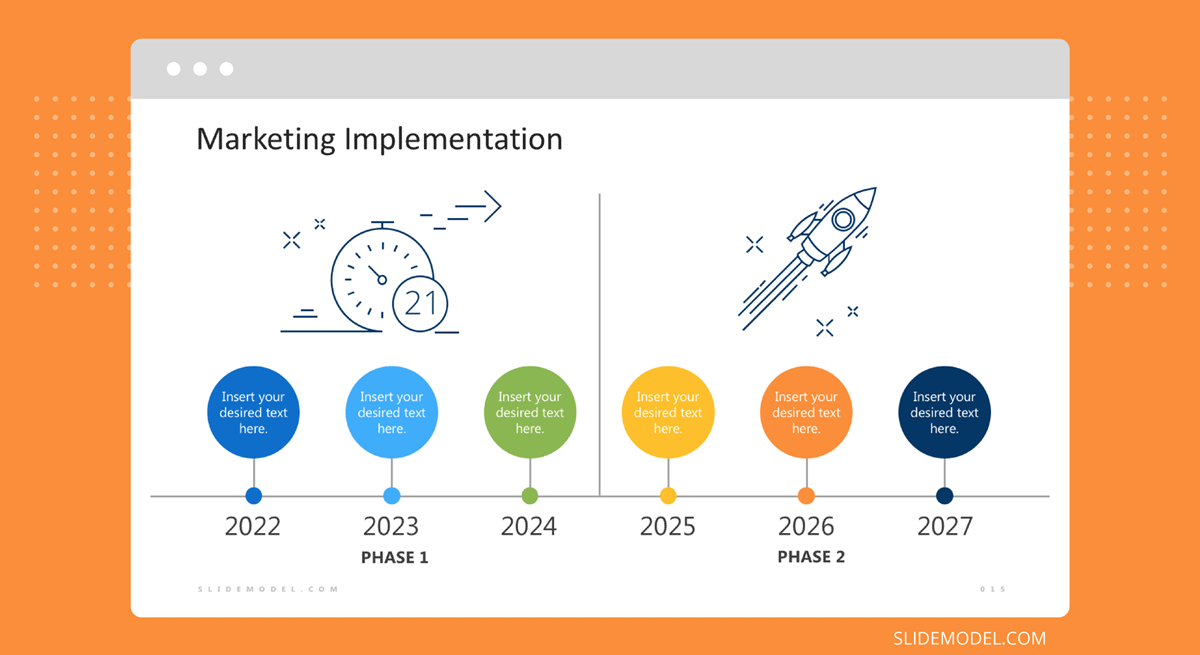
This part of the marketing plan explains how the company will conduct its marketing strategies, including how it will be structured by operations, products, areas, and target audience categories. You can take various steps to build an effective marketing implementation plan. Some of them are as follows:
Create realistic scenarios
Firstly, in a marketing implementation plan, you should set reasonable expectations for how quickly you can meet marketing goals and objectives. When you decide on a timeline from the beginning, it assures that everyone involved is informed of and capable of meeting each deadline.
Review your marketing strategy
Re-examine your marketing strategy to ensure it is well-developed, efficient, and results-oriented. You may include any other aspects you come across when creating your implementation plan. While reviewing your marketing strategy, make sure you have focused on every essential element.
Create workflows for all of your content and tasks
You may make a simple list of tasks and promotional procedures for your members to perform. Try creating the steps in procedures as straightforwardly as possible and linking aspects that make sense. Allocate assignments to groups of people, and give each one a time limit or deadline. Before sharing the finished version, review the workflow with all parties concerned and seek input and suggestions. For maximum output, facilitate cooperation throughout the implementation plan.
Communicate with your team
After defining your marketing strategy, workflows, and KPIs (Key performance indicators) , ensure everyone is on board. Creativity, efficiency, and performance can all improve from open communication and collaborative ownership. Communicate your plan with partners and other company units to secure commitment and acceptance for the team’s actions.
To create an effective marketing plan:
- Analyze the various needs of client groups and focus on the market.
- Determine if you can sell more to your current clients or how you can improve meaningful client engagement.
- Set out necessary aims and create an efficient action plan to implement your marketing strategies.
- Set clear, realistic, and measurable targets using the SMART Marketing Goals approach (Specific, Measurable, Attainable, Realistic, and Timely).
- Apply the RACE Framework , which will help to streamline marketing objectives.
Some Pitfalls of the marketing plan can be:
- Making assumptions about a client’s needs can lead to the inefficiency of your marketing plan.
- Do not rely on a smaller number of consumers.
- Underestimating the competition can have considerable consequences on your business.
Final words
A marketing plan’s ultimate purpose is to ensure that marketing operations are relevant and timely to meet your business’s goals. An ideal marketing plan encompasses the strategies for identifying a long-term competitive position and the resources required to attain it. Your capability to anticipate the appropriate marketing strategies distinctly and update and improve your activities regularly is essential for the growth of your business.
What is the main purpose of a marketing plan?
A marketing plan’s primary purpose is to outline the strategies and tactics a business will use to promote its products or services, reach its target audience, and achieve its marketing goals.
Why is it essential to have a marketing plan for a business?
Having a marketing plan is essential because it provides direction for advertising, sales, customer support, and other aspects of the business. It helps establish measurable goals, ensures consistency in business strategy, and provides a framework for allocating resources effectively.
How far into the future does a business plan typically project?
A business plan typically projects three to five years into the future, outlining the company’s goals and strategies for that period.
Who is the primary audience for a marketing plan?
The primary audience for a marketing plan includes marketing teams, sales teams, and other departments involved in implementing marketing strategies.
What are the KPIs in a marketing plan?
KPIs, or Key Performance Indicators, are quantitative measurements used to assess or compare performance in achieving marketing objectives. They provide a way to track progress and evaluate the effectiveness of marketing strategies.
Is a digital marketing plan different from a traditional marketing plan?
Yes, a digital marketing plan focuses on online channels, global reach, interactivity, and precise analytics, while a traditional marketing plan includes offline channels, may have a regional focus, and offers limited interactivity and measurement.
What is the best way to present a budget in a marketing plan presentation?
Present the budget visually with charts and tables, provide a detailed cost breakdown for each activity, and compare budgeted figures to actual spending for accountability.
What should I include in a marketing plan presentation?
Include sections on goals, target audience, strategies, tactics, budget, key performance indicators (KPIs), and a timeline.
How do you present a marketing presentation?
Present a marketing presentation by using engaging visuals, clear communication, storytelling, data-backed insights, and a well-structured narrative that flows from problem to solution. Practice and engage with your audience for effective communication.
Like this article? Please share
Business Presentations, Presentation Approaches Filed under Business
Related Articles

Filed under Design • August 14th, 2024
Creating Custom Themes for PowerPoint and Google Slides
Do you want your slides to go beyond the average result from a template? If so, learn how to create custom themes for presentations with this guide.

Filed under Business • August 8th, 2024
How to Create Engaging and Persuasive Proposal Presentations
Secure your business deals and build your brand’s reputation by mastering the art of proposal presentations. Tips and recommended PPT templates included.

Filed under Business • July 24th, 2024
How to Create a Demo Presentation
Discover the secrets behind successful demo presentations and what they should contain with this article. Recommended PPT templates included.
Leave a Reply
How to Make a Marketing Plan Presentation in PowerPoint

Whether you’re a marketing specialist or your personal project is near completion, it’s time to focus on marketing. Before you embark on advertising your business, you’re going to need a blueprint that outlines all your efforts. It should also state clear objectives and goals for your future. If this sounds complicated, it’s really not. We’ve prepared a few tips on how to make a marketing plan presentation that will make it all come together.
What is a marketing plan?
A marketing plan is basically the overview of all the marketing and advertising efforts your business has made and will make in the future. It contains all the details on the target market and strategy, as well as objectives to be reached in the future. Your marketing plan should always have clear objectives, and steps that are needed to reach those objectives.
Why should you make your marketing plan presentation in PowerPoint?
PowerPoint is a great tool for making your marketing plan presentation for more reasons than one. Apart from having comprehensive templates and slides that are perfectly fit to outline your specific marketing plan, it’s also ready to be presented to your audience at any moment. This is unlike with a Word processing document, which is neat for hosting your plan but not really presentable.
Once you’ve picked the organization and you yourself know and see all the data, the entire strategy starts making sense. If you’ve achieved this, you can be sure you’re ready to present it to others. And as your business grows, you can easily update the plan by adding new information or introducing another template for it.
Key Elements of Your PowerPoint Marketing Plan
Now you know what a marketing plan is and why PowerPoint is a great tool to host it. While you know everything that should go into a marketing plan, there are a few key elements that if you omit, you risk looking like a complete amateur. But don’t worry – below is the list of all the key elements of a PowerPoint marketing plan that will ensure you avoid it.
Knowing how to make a marketing plan presentation isn’t only about know all the essential elements. Be mindful that it’s also important where you place them.
A summary of your business marketing plan should always be the first element of your presentation. It should consist of a brief overview of your entire organization and the team. This, naturally, means that your summary slide should state the name of your company, where it’s situated, as well as a short mission statement that illustrates your higher objectives.
Another important thing is to be really honest with yourself in the summary. A SWOT analysis (strengths, weaknesses, opportunities, threats) is the best way to showcase your realistic view of the situation. Introducing with this is a great way to imply you’re aware of the risks. This gives the correct impression that you’ll work on resolving those issues later on in the presentation. This makes the audience trust you from the very beginning because you validate their doubts and give a promise that you’ll clear them all away.
While developing your business, you’re going to have to deal with a lot of calculations. Budget is an essential element of your marketing plan presentation, but you need to know exactly what it means.
Your business is going to have a lot of costs and, hopefully, more return, but this isn’t really the main interest of your audience when presenting an advertising effort. What you and your audience really want to know about is how much money has your business saved for marketing efforts specifically.
So what you’ll want to do is decide which part of the budget is for marketing efforts. Then, segment those elements even further, and outline exactly where the money will go towards those efforts. What is your marketing strategy? Which approach is the best for it? What are the individual processes that need to happen (e.g. content creation, marketing agency consulting, paid promotions etc.)? How much does it cost?
Once you’re done with that, what you have is a clear picture of all your costs relating to marketing efforts. This will make it easier for both you and your audience to work out the budget and see how you can fit it all in.
Every marketing plan presentation absolutely needs to have a decent list of marketing channels. This includes all the possible platforms your business uses and will use to generate leads and spread awareness. Don’t worry if you don’t have a rich list of successful marketing channels. Investigate a little more to find out about your target market and competition, and invest in the right channels. You don’t have to have a high-ranking website in order to be able to let least list some of your channel efforts, or ideas as to possible potential channels that are a perfect fit for your business.
If you don’t have a significant social media presence, you can still have plans. Talk about which platforms you want to use, why, how it will raise engagement and generate leads. You might also like these surprising product presentation ideas if you’re also working on a pitch.
Target market
Target market overview and analysis are also crucial parts of your marketing plan presentation. This is something no serious marketer climbs the podium without. You want to know all about your competitors and their strategy, as well as a clear picture and deep understanding of the industry you’re advertising to. So before you present your plan to others, make sure you’ve done a thorough target market analysis and come up with the buyer persona.
When it comes to marketing presentations, your buyer persona is really the protagonist of the whole story. It’s a concept of your ideal consumer, created from all the facts you’ve collected about your target audience. You should know the average age, location, professional aspirations, and personal life. Find out where they spend their time online, what they’re buying and dreaming about. Once you do that, you have a convincing character to present to your audience. And once you have that, it means you have convincing prospect options as well.
Market Strategy
Once you’ve made heads and tails of your buyer persona and know what your competition is doing, it’s time to figure out how you’re unique. Market strategy section of your PowerPoint marketing plan is all about that.
Think about everything you have that your competition doesn’t. This could be a product feature, a free trial, awesome content or underlying philosophy. It doesn’t really matter in what shape or form your individuality comes from, as long as you manage to connect to your target market. The key is to resonate more than the competition. This can only be done by carefully examining the core values and objectives of your business, and finding the way in which those values and objectives resonate with and inform your ideal buyer.
How to Format your Marketing plan presentation
If you have good templates , you won’t have too many problems with formatting your marketing plan presentation in PowerPoint. However, there are certain rules that might help you avoid jarring design and inappropriate fonts. Adhering to these rules can save you a lot of trouble and embarrassment in the long run, so it can’t hurt to stick to them.
In order to make your slides professional and easy to read, you can’t go wrong sticking to standard fonts. Use Times New Roman or Arial, and keep your lettering big. But don’t overdo it. If you keep your font size for the regular text at maximum 34, it won’t be too jarring and should be enough for everyone to see. You shouldn’t be using too much text on any of your slides anyway, so it should fit right in.
The next thing you’ll want to do is create a separate slide or set of slides for each important section of your marketing plan. This includes all of the mentioned elements (summary, target market, situational analysis, etc.). Don’t refrain from using charts, graphics or any kind of smart art to showcase all these elements visually, with fewer slides. And don’t forget to include a source for every citation you have in your presentation. Use smaller text in order to cite the source somewhere on the slide, and have a detailed and more comprehensive list of sources and references at the end of your marketing plan presentation. For more on this, see: Business presentation design pointers to increase audience retention rate .
Marketing Plan Presentation Templates
A marketing plan presentation template is an easy way to organize your efforts. There are different factors that will determine which templates are optimal for you. This will largely depend on your industry, audience, and target market.
However, there are some general elements every marketing plan template should consist of. Apart from the aforementioned ones, like market strategy and summary, your template should also have some space for info like further programs and initiatives, some key statistics, and some freedom to let your brand shine, like in this SlideShare example.
If you want an incredible resource of free PowerPoint templates, head over to Templates by 24Slides . We have hundreds of high-quality templates that are always 100% free!
Now you know how to make your marketing plan presentation in PowerPoint. Hopefully, you don’t find it too difficult. Once you’ve done all your research and determined the objectives of your business, it should be pretty easy to do. Be clear and honest with your goals and possibilities. Don’t use flashy fonts and colors, but do make sure to implement charts and graphics for data visualization. Be equally aware of your strengths and weaknesses, and don’t shy away from talking about them. If you don’t mention your possible drawbacks, someone else will. And that doesn’t give you the upper hand. And remember: In your marketing plan presentation, the protagonist isn’t you. It’s your consumer. As long as you have that in mind, the audience is sure to follow the plot.
Create professional presentations online
Other people also read

6 Presentation Styles of Famous Presenters

How to create and deliver a powerful presentation introducti...

The seven worst presentations of all time and why they went ...

30 Free Marketing Presentation Templates with Modern Design
- Share on Facebook
- Share on Twitter
By Al Boicheva
in Freebies
3 years ago
Viewed 74,025 times
Spread the word about this article:

Updated: July 14, 2022
Today, we decided to take a deep dive and handpick presentation resources for your marketing projects . If you are a marketer or you need to design and prepare a presentation for your marketing team, look no further. Below we’ve listed 30 free marketing presentation template resources so you won’t need to start from scratch. Some are multipurpose business templates with designated marketing sections, while others are directly designed for marketing plans. There’s something for every marketer.
In the meanwhile, you can take a look at our collection of inspiring marketing web designs that can help you find ideas for your new website.
1. Free Social Media Marketing PowerPoint Template

The template offers slides for presenting social media data. It includes slides for buyer persona, a timeline to explain the evolution of your company, and graphs and tables to analyze your competitors and growth.
- 100% editable and easy to modify
- 38 different slides to impress your audience
- Contains easy-to-edit graphics such as graphs, maps, tables, timelines, and mockups
- Compatible with PowerPoint and Google Slides
2. Free Drinks Campaign Presentation Template

A beer day campaign free template that allows you to grab a beer and start preparing a great marketing presentation that will appeal to everyone. Cheers!
- 32 different slides
- Contains easy-to-edit graphics such as graphs, maps, tables, timelines and mockups
- Includes 500+ icons and Flaticon’s extension for customizing your slides
- Designed to be used in Google Slides and Microsoft PowerPoint
3. Free Virtual Campaign Presentation Template

Designed to look kawaii and colorful, this marketing presentation template has sections about your company, content plan, market analysis, budget, or KPI overview.
- A creative design that looks like browser windows
- 30 different slides to impress your audience
- Available in five colors: pink, orange, blue, purple, and green
- Contains easy-to-edit graphics, maps and mockups
4. Free Cyber Monday Presentation Template

The theme of this marketing template revolves around Cyber Monday. Plus, the contrast between the black backgrounds and the light blue and pink tones is pure eye candy.
- 33 different slides to impress your audience
- Available in five colors: blue, green, yellow, pink, and orange
- Contains easy-to-edit graphics and maps
5. Free Ethical Marketing Presentation Template

If the topic of ethics is what you want to discuss with your company’s managers, this template is ideal for the purpose.
- 35 different slides to impress your audience
6. Free Spark Business PowerPoint Template

This free template includes 20 semi-transparent illustrations of different concepts: security, social networks, bitcoin, and more.
- Fully editable. Add your own content, change colors and pictures
- 25 slides with tips for better presentations
- Design with a dark background and transparent illustrations
- With lots of free resources included: graphs, maps, tables, and diagrams
7. Free Stylish Pitch Deck Presentation Template

Emilia is a multi-purpose business and marketing template with a clean and formal design, with several variations for each slide layout.
- Fully editable. Easy to change colors, text, and photos
- 25 different slides with tips to improve your presentation
- Professional design in yellow and navy blue
- Feature-rich theme with examples of styles for graphs, charts, and tables
8. Free AI Tech Agency Presentation Template

This presentation design focuses on technology with its high-tech abstract backgrounds. The template gives a futuristic vibe and plays around with neural networks and the depth of field. To present your services, the evolution of your digital marketing agency, and your clients, there are many different layouts just for you to choose from.
- A futuristic template with abstract backgrounds
- 23 different slides to impress your audience
9. Healthy Fruits Marketing PowerPoint Template

This free marketing template for your next health foods campaign has a fresh style with a fruity design.
- 25 different slides to impress your audience
- Available in five colors: Orange, purple, blue, pink, and green
10. Food Campaign Presentation Template

Food is the main element of the design, with watercolor drawings of fruit and vegetables.
- A marketing campaign presentation with watercolor illustrations of food
- 27 different slides to impress your audience
- Available in five colors
11. Free Summer Campaign Presentation Template

A summer vibes template for creating presentations about your marketing plan.
- 24 different slides
- Contains editable graphics and maps
- Includes 1000+ icons divided into 11 different themes for customizing your slides
- Designed to be used in Google Slides and PowerPoint
12. Aqua Marketing Plan Presentation Template
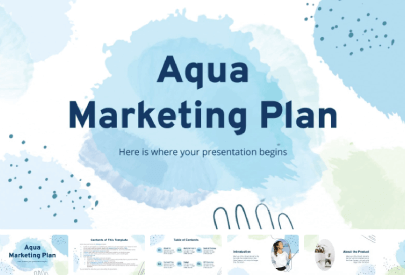
The free Aqua watercolor marketing plan template is a good choice if your message has to do with water or the environment.
13. Lettering for Marketing Presentation Template

Nothing like catching your audience’s attention with designer lettering that makes them associate it with your brand.
14. Free Online Marketing Plan PowerPoint Template

This is an editable online marketing plan template, with Free PDF & PPT download , that addresses these questions:
- Who is your target?
- How do you plan to reach them?
- How will you retain them after?
- Who are your competitors?
- How can you make your business stand out?
15. Free Colorful Statistics Presentation Template

This free template is specifically designed for presenting data results or statistics.
- 25 different slides
16. Free Food Marketing Campaign Presentation

A modern marketing template for presentations of companies in the food industry.
17. Connections – PowerPoint Presentation Template

The theme of this template fits social media, science, or connection topics.
- Professional and corporate design with a connected dots background
18. Free Multi-Purpose Presentation Template

A free multi-purpose Powerpoint template, designed in a modern minimalist style. Perfect for presenting your brand, company, or startup with this fresh-looking template.
19. Free Business Planning PPT Presentation Template

Business presentation template with SWOT analysis, social media analysys, grant charts and other marketing slides.
- Compatible with PowerPoint
20. Company Profile Presentation Template

Company Profile is a free multi-purpose PowerPoint template and is free for personal and commercial use it is a great option to present your marketing agency to your potential clients.
- Compatible with PowerPoint and Keynote
21. Dark Multipurpose Presentation Template

Another rich multi-purpose template with marketing slides. The free sample version offers 10 slides.
22. Free Multipurpose Presentation Marketing Template

A very rich multi-purpose template with marketing and social media analysis slides. The free sample consists of 10 slides.
23. Free Blue Marketing Presentation

Marketing presentation with isometric illustrations on business, marketing, and technology topics. Offers 25 fully-editable slides.
- Fully editable
- Clean design with isometric illustrations
24. Free SEO Strategy PPT Template

This neon purple gradient presentation has slides to explain your SEO strategy thanks to graphs, diagrams, diagrams, maps, and lists.
- 35 different slides
- Includes 500+ icons and Flaticon’s extension
25. Free Corporate Presentation Template

A free Corporate Powerpoint template with 6 premade slides. This corporate presentation theme is perfect for any business presentation. This PPT template is designed in a modern style, with fresh color combinations, giving the feeling of a more professional presentation.
26. Free Official Protocol Campaign Presentation Template

A corporate template with geometric shapes, dark backgrounds, and subtle gradients. It features layouts for explaining things such as budget, promotion, or distribution, as well as images that will reinforce your points.
27. Free Wedding Planner PPT Template
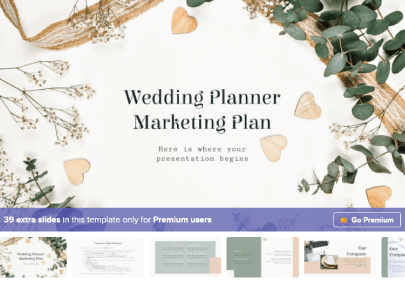
This is a free presentational template to adapt to wedding marketing plans if you’re in an event planning services field. It has an effective classy design and a beautiful choice of unconventional fonts and pastel colors.
- 27 different slides
28. Free Real Estate Marketing Presentation

The template is pretty useful for real estate agents. Its design is neat, clear and offers great-looking flat illustrations of houses to boost your sales and make your presentation attractive and appealing.
- 23 different slides
29. Free Business PowerPoint Template

A free multi-purpose Powerpoint template with 6 business slides. Perfect for reports, business plans, analysis, or product introduction. This PPT template is designed in a modern style, giving the feeling of a more professional presentation.
30. Free Hand-Drawn Presentation

An attractive free multi-purpose Powerpoint template for presenting your agency and brand in a memorable way. The design shows off with hand-drawn illustrations, giving the feeling of a more personalized custom-made presentation.
Final Words
We hope you enjoyed these 30 free marketing presentation templates and got inspired to create an amazing presentation of your own that will make your audience remember it for a long time.
In search of more PowerPoint resources? Why not check out the best free PowerPoint templates for 2022 ? Or you can narrow your search down to some of our previous articles on the topic here:
- Digital Marketing Trends 2022
- Infographics for Marketing: How to Grab and Hold the Attention
- Instagram Marketing: Tips & Tricks to Boost Your Visual Content

Add some character to your visuals
Cartoon Characters, Design Bundles, Illustrations, Backgrounds and more...
Like us on Facebook
Subscribe to our newsletter
Be the first to know what’s new in the world of graphic design and illustrations.
- [email protected]
Browse High Quality Vector Graphics
E.g.: businessman, lion, girl…
Related Articles
13 free business plan powerpoint templates to get now, 30 free cute powerpoint templates: collection for a sweet presentation, 120+ free food illustrations for personal and commercial garnishing, 120+ free animal vector characters to perk up your projects, the best free powerpoint templates to download in 2022, check out our infographics bundle with 500+ infographic templates:, enjoyed this article.
Don’t forget to share!
- Comments (1)

Al Boicheva
Al is an illustrator at GraphicMama with out-of-the-box thinking and a passion for anything creative. In her free time, you will see her drooling over tattoo art, Manga, and horror movies.

Thousands of vector graphics for your projects.
Hey! You made it all the way to the bottom!
Here are some other articles we think you may like:
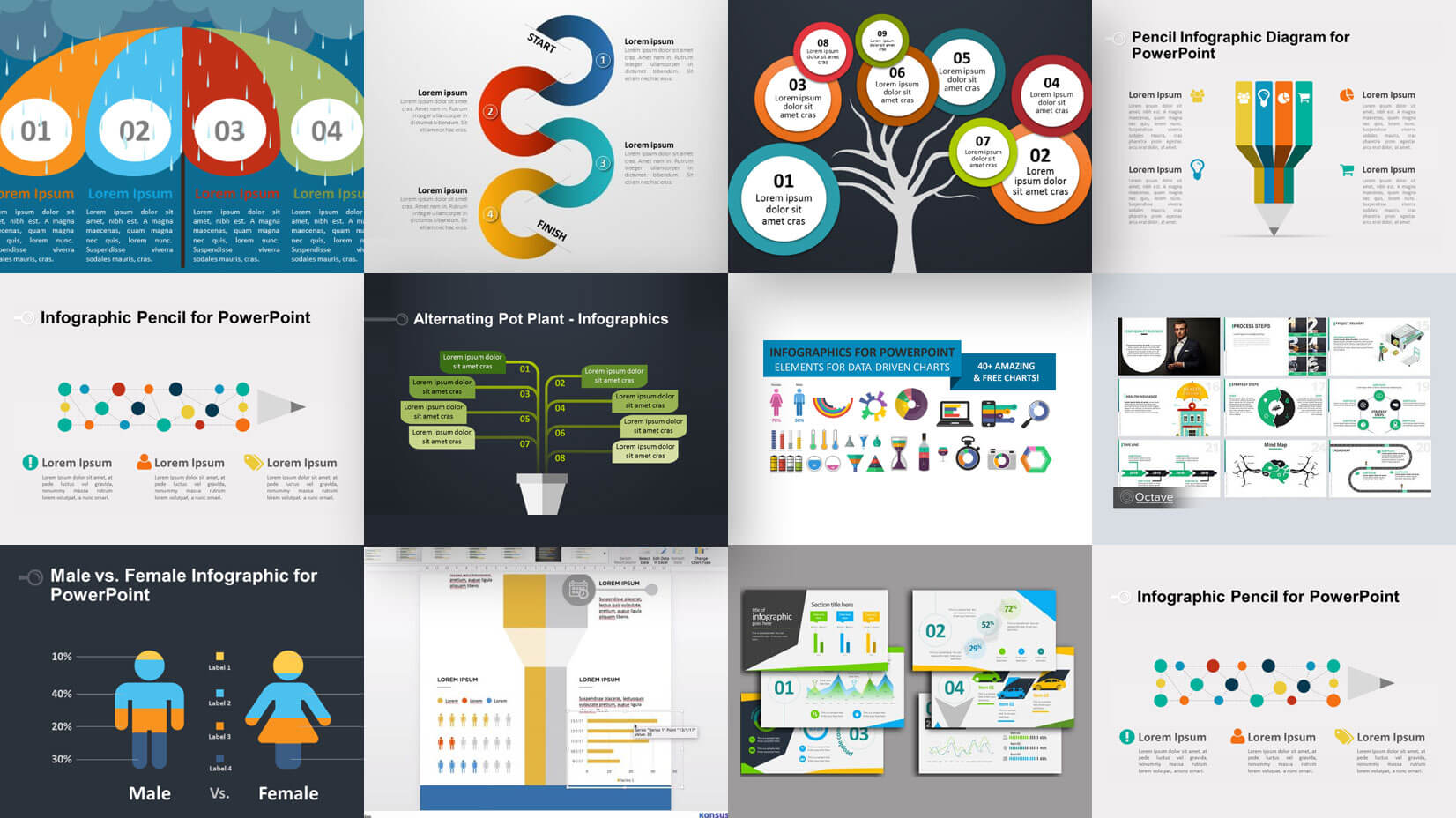
35+ Free Infographic PowerPoint Templates to Power Your Presentations
by Iveta Pavlova

Adobe Character Animator Puppets by GraphicMama (+Freebies)

The Top 63 Most Awesome and Free Character Animator Puppets for 2021
by Al Boicheva
Looking for Design Bundles or Cartoon Characters?
A source of high-quality vector graphics offering a huge variety of premade character designs, graphic design bundles, Adobe Character Animator puppets, and more.

One Time Code
< Go back to Login
Forgot Password
Please enter your registered email ID. You will receive an email message with instructions on how to reset your password.

How to Make a Marketing Plan Presentation? Guide & Marketing Presentation Examples
The days of reading your target audience word-for-word from slides are long gone. These days, it all comes down to turning your data into an enduring visual narrative. It was formerly assumed that marketing experts would naturally excel in developing and delivering compelling marketing plan presentations.
However, with the rise of digital marketing, the value of traditional presenting techniques is sometimes disregarded or undervalued in a marketer’s skill set. Nevertheless, the capacity to produce a compelling presentation is still highly valued in today’s digital marketing world.
It is essential to understand how to make a marketing plan presentation. This is because a badly done marketing plan presentation in high-stakes business can quickly lead to your audience losing interest. You lose more than simply attention; you also forfeit sales chances, prospective clients, expansion prospects, and eventually money. The unpleasant reality is that there is very little probability of you sticking out in a crowded area. But don’t worry!
Your brand will never be disregarded if you strategically approach your marketing plan presentation. As difficult as it may sound, it is indeed possible. Hence, this blog will teach you all the ins and outs of a successful marketing plan presentation. You will also learn how to do a marketing presentation effectively.
What is a Marketing Presentation?
A marketing presentation walks you through a representation of how you will market your product or service to the target population that you have in mind.
Although it may appear straightforward, a marketing presentation needs to contain information on the product, the features that set it apart from the competition, the channels you intend to use to advertise it, etc.

Why is a marketing presentation important?
When it comes to effectively communicating team goals and updates in marketing, marketing presentations are essential. They are an important asset for several reasons:
1. Information Sharing: Marketing presentations are useful for informing the team about important updates and objectives. A common understanding is promoted among team members, and misunderstandings are reduced when information is presented in an organized manner, which guarantees that everyone is aware of the same information at the same time.
2. Visual Aid Enhancement: Adding visual aids to marketing presentations helps the audience better understand the presented information. Graphs, charts, and other visual components help make complex material easier to understand, more interesting to read, and easier to remember. This helps to reinforce important ideas and messages.
3. Content Generation and Promotion: Marketing presentations are useful tools in content generation. They can be transformed into slideshows, work reports, educational films, or materials that can be downloaded, among other types of content. This establishes the organization’s competence and provides useful content for audiences outside the company.
4. Product and Service Launches : Marketing presentations provide an extensive framework for effectively outlining plans to launch new products and services. They promote awareness of departmental activities and overarching goals and ensure the entire marketing team is in sync with the marketing strategies.
5. Idea Pitching: Marketing presentations are essential when presenting brand-new marketing concepts. A strong presentation helps marketers clearly communicate their vision, win over team members, and unite behind creative endeavors—whether recommending fresh approaches or tweaking already-running campaigns.
7. Training and Onboarding: Training new team members can be effectively accomplished using presentations. Their capacity to impart knowledge to many people simultaneously simplifies the onboarding process. It guarantees that new hires will quickly pick up the most important facts about the company, its marketing plans, and its overall objectives.
How to make a marketing presentation?
Here are some top points to consider when making a marketing presentation:
- Consider your audience
- Decide on a presentation method
- Gather information and material
- Plan your marketing presentation
- Tell a story
- Create captivating visuals
- Interactive components
- Think about logistics
Consider Your Audience:
Spend some time getting to know your audience before crafting your marketing presentation. Determine their demographics, areas of interest, and degree of expertise with your subject. Make your communication more relatable by adjusting the content, tone, and style to suit their tastes.
Decide on a Presentation Method:
Select a format for your presentation that aligns with your objectives and target audience. Think of the best medium: a PowerPoint deck , a live demonstration, a video, or a webinar. Consider the platform and technology you’ll also employ to guarantee a flawless delivery.
Gather Information and Material:
Get relevant information, figures, case studies , and illustrations to support your main points. Ensure the data is precise, current, and related to your marketing goals.
Plan Your Marketing Presentation:
Clearly state your presentation’s goal and list its main points. Provide a clear introduction, a captivating conclusion, and essential points for your presentation. Use the AIDA model to lead your audience through Attention, Interest, Desire, and Action.

Tell a Story:
Write a gripping story that your audience can relate to emotionally. Use narrative strategies to create material that is both captivating and memorable. To add authenticity, including case studies or customer success stories.
Create Captivating Visuals:
Provide aesthetically pleasing slides or images that enhance your content. To successfully communicate information, use charts , infographics, and high-quality photographs. Keep the presentation’s visual theme constant, and use your branding throughout.
Interactive Components:
To increase audience participation, use interactive elements like surveys, Q&A sessions, or live demos. To make the experience more exciting and unforgettable, invite audience participation.
Think About Logistics:
Verify technical factors, such as internet connectivity, audio, and images. Make sure that every presentation resource is available and prepared for usage. Take care of any logistical concerns ahead of time to prevent interruptions during your presentation.
Marketing Presentation Examples
Here are a few top marketing presentation examples for you to check out:
- Marketing Objectives
- Market Research
- Executive Summary
- Mission Statement
- Marketing SWOT Analysis
- Marketing Strategy
- Marketing Budget

1. Marketing Objectives
The Marketing objectives of a company are usually a blend of its defined goals, which are specified in a marketing plan. These provide the marketers with the targets they need to meet and what time frame they have. Tools like objective key results (OKRs) and key performance indicators (KPIs) can structure an organization’s marketing objectives.
Make polished OKRs and KPIs with these pre-designed templates.
2. Market Research
As the name suggests, Market research is the process of gathering information and researching about the market before formulating a plan. It involved studying the target market and consumers to ensure that a new product will be successful. It assists the team in working on an existing product while maintaining and putting forward the company’s value effectively.
3. Executive Summary Marketing Plan
An executive summary marketing plan, also called an executive brief, describes a company’s marketing strategy. The document is usually one or two pages long, summarizing important strategies and a series of actions emphasizing the most important aspects. These aspects intend to increase brand recognition and work on the company’s competitive edge. The executive summary marketing plan outlines short and long-term marketing objectives and summarizes various related industry studies.
Explore templates related to executive summary here.
4. Mission Statement Marketing Plan
A Mission Statement in a Marketing Plan guides corporate strategy. It steers the marketing planning process and strategies. Although the strategies and tactics tend to shift, the company’s mission statement always remains the same after its implementation and evaluation. Hence, the mission statement explains an organization’s marketing content. It highlights the primary goal of a marketing plan.
5. SWOT Analysis in Marketing Plan
A Marketing SWOT Analysis is a method to find, analyze, and document a company’s internal strengths and weaknesses. SWOT is an acronym for Strengths, Weaknesses, Opportunities, and Threats. These four factors are assessed as they affect the formulation of the marketing objective. Hence, Marketing SWOT analysis is an important part of the marketing process.
6. Marketing Strategy
Marketing strategy is a crucial part of the marketing plan. It is a document detailing the types of activities an organization conducts. It also contains timetables, helping push different marketing initiatives. Marketing strategies contain the company’s value prepositions and other key elements.
7. Marketing Budget
The marketing budget is a part of the marketing plan, which highlights the sum of money the company assigns for specific projects. These projects intend to market and promote the product. So, the budget aids organizations in handling resources, leading them to achieve business goals. The marketing budget helps the company stay competitive in the market, which grows the revenue.
How to end a marketing presentation?
Here are a few ways you can effectively end your marketing presentation:

1. Add a compelling call to action (CTA)
In case you are a business owner, motivating the audience to take action is the main goal of your presentation. Move them to it instead of assuming they would accept it. Make use of strong, instructive, and definitive language. “Join the fight” and “Begin the journey” are two concise calls to action that inform the audience of what to do.
2. Skip the Q&A at the end
After captivating your audience for twenty to thirty minutes, will you end your presentation with a Q&A session? Q&As are not memorable, other than the fact that you never have complete control over the questions you will be asked. So, how can a presentation be concluded effectively? It is preferable to field questions all during the talk.
This allows you to ensure your audience follows along and the questions you ask are pertinent to the specific topic. Make sure to give yourself a minute or two following the Q&A if you have been compelled to arrange your presentation such that questions are answered at the conclusion. This is the moment to wrap up the presentation with inspirational quotes and the last takeaways.
3. Conclude with a Story
There’s a strong likelihood that if you start with a captivating story, you’ll also end with one. A narrative at the conclusion can effectively summarise the information you have presented, just as a tale at the beginning was an effective lead-in to your message.
One thing to keep in mind is don’t wrap up with a case study. This is something that many business owners do. Using case studies in the middle of your presentation is a terrific idea. In the end, you want a poignant tale that stays with your audience and helps them remember your point of view for a very long time.
Make your conclusion memorable with professionally designed conclusion slides .
4. Make your Points Clear
At the conclusion, your audience will value a summary that provides a clear, concise summary of what they have just heard. Many experienced presenters utilize this straightforward summary formula on the last slide.
5. Inform Them of What you Plan to Share With Them
Saying something as simple as “Let me briefly restate my main takeaways before I leave you with my final thoughts about XYZ” will suffice. Show the audience how each of your main ideas relates to the others rather than merely listing them. Delivering an effective presentation requires a great deal of effort and dedication. Your message will be properly understood and have an impact if you craft a strong introduction and conclusion.
6. Appreciate and Recognize
Expressing gratitude to your audience can be a terrific method to let them know when your presentation is finished. It’s time for them to applause. It can be simpler to include a thank-you or end slide. You can thank any businesses or individuals, such as a website you used as a data source, after your presentation for their assistance in putting it together.
What is a marketing plan?
Before we move on to learning how to make a marketing plan presentation, it’s important to understand what a marketing plan is. A marketing plan is a strategic roadmap companies use to plan, carry out, and monitor their marketing strategy over a predetermined time.
As different marketing teams within the organization strive towards the same corporate objectives, marketing plans can incorporate a variety of marketing tactics. Strategies should be documented in a marketing plan in an orderly fashion. Using this to gauge the effectiveness of your campaigns can help you stay on course.
The goal, buyer personas, budget, strategies, and deliverables of each campaign can all be considered while creating a marketing plan. Keeping a campaign on track will be simpler if you have all this information in one spot. The marketing plan will also reveal what functions well and what doesn’t. Assessing your strategy’s effectiveness as a result.

Why do you need a marketing plan & marketing plan presentations?
Whether you’re growing a small or large firm, you still need a marketing plan and marketing plan presentations to visualize your plan. After all, it has many advantages, including the following:
1. It can assist you in setting quantifiable company objectives
Setting clear objectives for your organization is crucial. It shouldn’t be as easy as “meeting annual sales KPIs” or “not going broke.” If not, all you’re doing is positioning yourself for marketing failure. You can’t use marketing initiatives to assist you in attaining your goals if you don’t have a defined target. A marketing plan can help you increase sales and enhance your company’s performance all year by focusing on measurable goals.
2. A plan provides consistency
A marketing plan ensures that everyone on your team is on the same page, whether big or small. Everyone receives detailed instructions on how to accomplish the organization’s business objectives. If your plan doesn’t have a marketing strategy, it will become disjointed and ineffectual. For instance, half of your staff may work on print and radio advertisements, while the other half may handle social media, internet content, or email marketing.
3. It forces you to adhere to your spending plan
Even large companies are subject to budgetary constraints. You can prioritize activities using a marketing plan based on which produces the best results. It can spare you the trouble of coming up with unprofitable strategies.
4. It enables you to give your clients greater service
Beyond the procedure, a marketing plan is quite essential. It also serves as a guide on how to interact with your clientele. You can better address your audience after you know what has to be done.
5. It provides your business with the necessary dose of reality
Businesses frequently have several goals and need a marketing plan to direct them. It is a yardstick to help you remember whether you’re meeting your marketing objectives. You can ensure that your strategies align and are consistent with the initial business objectives.
6. Your marketing team may find it a great source of motivation
Let’s say you wish to launch your company by advertising ten products per day. Employees will spend less time in brainstorming sessions and follow-up meetings if they know the precise marketing tactics to accomplish that aim. They must only adhere to your marketing strategy, and everything else will work out.
7. Getting new investors requires a plan
It’s a fact that creating and maintaining a firm requires a substantial financial outlay. More capital must be invested if you want your business to expand in terms of people, goods, and revenue. Getting several organizations to invest in the product you’re marketing is one approach to achieve this. However, you cannot secure the necessary funds if you cannot provide a marketing plan explaining your company’s path. It’s crucial if you want to advance your business.
8. Rather than forcing you to react, it might encourage proactive thinking
Planning enables you to comprehend your target market and offerings and how you can connect the two to meet your company’s objectives. Moreover, teams with marketing strategies are more proactive. Thus, you plan rather than just respond to situations as they arise. You can anticipate problems and find quick solutions.
What is a marketing plan presentation & Why Is It Important?
A formal presentation outlining a marketing plan’s main elements is called a marketing plan presentation. It is a communication tool to tell executives, team members, stakeholders, and possible investors about the marketing strategy, objectives, techniques, and other pertinent information. Slides are frequently used in presentations to convey important points succinctly and successfully.
Here’s why a marketing plan presentation is important:
- The company’s marketing goals must be defined in a manner consistent with its corporate mission and vision, and a marketing plan presentation can help with that.
- By outlining suitable marketing strategies, like plans to expand the customer base, the marketing plan typically aids in the company’s expansion.
- The marketing plan presentation presents and discusses the marketing mix: products, prices, places, promotions, people, processes, tangible evidence, and performances.
- The marketing plan also includes strategies to expand into new specialized markets, gain market share, and raise brand awareness.
- A thorough budget for the money and materials needed to complete the tasks is also outlined in the marketing plan.
- The marketing plan clearly lays out who is responsible for what when it comes to marketing initiatives.
Difference between a marketing presentation & marketing plan presentation
| Definition | It is a broad term. It includes various topics. | It is a topic that comes under the Marketing Presentation head. It outlines a comprehensive marketing presentation. |
| Scope | Focuses on specific campaigns, product launches, sales pitches, etc. | Specifically addresses the overall marketing strategy, objectives, and tactics. |
| Content | Variable content based on the specific marketing topic | Comprehensive content covering marketing goals, strategies, target audience, budget, and other plan elements |
| Purpose | Addresses specific marketing initiatives or topics | Outlines the strategic approach and detailed actions for achieving overall marketing objectives |
| Depth of Detail | It can vary depending on the specific focus of the presentation | It covers various aspects of marketing in detail. |
How to make a marketing plan presentation? Tutorial
- Describe the goal of your company
- Establish the mission’s KPIs
- Determine your personas for buyers
- Outline your strategies and content initiatives
- Clearly state what is left out of your strategy
- Establish a marketing spending plan
- Recognize your competitors
- List the contributors to your plan and what their roles are
1. Describe the goal of your company
Defining your goal is the first stage in creating a marketing plan. Despite being unique to your marketing division, the aim should be to support your company’s overall goal. You should be precise without going into detail.
It is important to know who you are presenting to and what they anticipate from you before you begin working on your marketing strategy. Understanding your target will enable you to eliminate superfluous language, technical details, or assumptions while customizing your marketing strategy to its unique context and aims.
The first stage is to comprehend corporate objectives and high-level marketing. These ought to serve as the cornerstone of your plan. Grouping the job based on its goals can help your teammates understand the strategy behind your operations. Establishing your company’s objectives can help you assess if the initiatives and campaigns you start are on track.
2. Establish the mission’s KPIs
A strong marketing plan outlines the department’s process for monitoring the achievement of its goals. You must choose your key performance indicators (KPIs) before proceeding. Key Performance Indicators, or KPIs for short, are a set of numerical metrics that a business or industry uses to evaluate or compare how well it is performing in achieving its operational and strategic goals.
KPIs are specific measurements used to assess different aspects of a marketing effort. You can create a sense of accountability and ownership for your company’s goals using measurable KPIs. They are required to finish all company plan tasks. These modules assist you in setting short-term objectives within your purpose and informing corporate executives of your progress.

3. Determine your personas for buyers
A buyer persona outlines the target audience you wish to reach. This can include work title, family size, location, age, and sex. Every buyer persona needs to represent both present and future clients. Thus, your buyer personas need to be approved by all company leaders.
4. Outline your strategies and content initiatives
The key components of your marketing and content plan should be included here. You have many options for content types and channels available to you nowadays, so make an informed decision and explain how you’ll use each in this portion of your marketing plan.
5. Clearly state what is left out of your strategy
The marketing team’s priorities are described in a marketing plan. It clarifies what the marketing team will not concentrate on as well. Include any additional facets of your company that aren’t covered by this specific plan in this section. These omissions support the logic of your content, KPIs, buyer personas, and mission.
6. Establish a marketing spending plan
Use these funds to create a marketing budget and list all your expenses in this portion of your marketing plan, including freelance fees, sponsorships, and new full-time marketing hires. The distinctive features of your business should be reflected in your budget. Your business stage also determines your marketing budget. You can specify your marketing budget after determining which marketing channels to use.
The dates and milestones associated with your marketing initiatives, such as the start of a campaign, the publication of a blog post, or the sending of an email, should be included in your timeline. Realistic and adaptable, your budget and schedule should consider any risks or obstacles that can impact your marketing strategy.
7. Recognize your competitors
Understanding your competition is a necessary component of marketing. Examine the major participants in your sector and think about writing a profile of each. Remember that not every rival will present your company with the same difficulties. For instance, one rival may dominate search results for terms you would like your website to rank for. But another may be well-established on a social network you intend to join.
8. List the contributors to your plan and what their roles are
Now that your marketing strategy is well developed, it’s time to outline who will execute what. Although you prefer not to get too involved in your staff members’ daily work, be aware of which teams and team leaders are in charge of what kinds of content, channels, KPIs, etc.
Types of Marketing Plans
Here are some common marketing plans that are generally used in the business:

Annual Marketing Plan: An organization’s marketing strategy for the following year can be demonstrated by its annual marketing plan. You can outline specific goals, analyze the target audience, and plan the distribution of resources over the year. The marketing team can stay focused, track their success, and make sure their efforts align with the overall business plan by using this plan, which divides goals into quarterly or monthly chunks.
Digital Marketing Plan: Any organization looking to build a strong online presence must have a digital marketing plan in the current digital era. The digital marketing plan is dynamic and flexible, acknowledging the always-changing digital landscape and successfully providing a systematic approach to connect and interact with the target audience.
Content Marketing Plan: A content marketing plan focuses on producing and sharing excellent information to draw in and hold on to a target audience. Key performance indicators (KPIs), distribution methods, and comprehensive content creation plans are all included. By creating insightful and timely content, this strategy helps establish the company as a thought leader in the field, establish brand authority, and cultivate enduring relationships with clients.
Social Media Marketing Plan: A marketing plan focuses on social media platforms and includes tactics for audience interaction and brand development. This plan leverages social media to improve brand visibility and fortify relationships with the intended audience. It acknowledges the importance of various channels in modern marketing plans.
Product Launch Marketing Plan: Designed to introduce new goods or services, a successful market entry depends on having a product launch marketing plan. This plan includes all the preparations before, during, and after the launch, along with information on promotional efforts, target audience identification, and channel selection for communication.
Event Marketing Plan: An event marketing plan is crucial for businesses looking to increase brand awareness through events. This plan guarantees a smooth and powerful event implementation, optimizing its influence on brand perception and cultivating deep relationships with the intended audience.
Best marketing plan templates by SlideUpLift
SlideUplift is a utility to help business professionals create powerful presentations. Users can benefit from ready-to-use impactful PowerPoint tools and templates. In its wide library of presentation templates, SlideUpLift also has multiple options related to marketing plans. Here are some of them:
30-Day, 60-Day, 90-Day Marketing Plan:
Businesses can methodically plan their marketing efforts over three months by using the PowerPoint template, which acts as an organized guide. Market analysis, target audience, goals and objectives, marketing strategies, etc, are all commonly included in this template.
With the help of the phased method, marketers may execute strategic objectives in the first 60 days, progressively increase understanding in the first 30, and assess and improve strategies in the last 30 days. This PowerPoint template’s graphic structure makes it easier to convey this roadmap to stakeholders and guarantees that the marketing plan is communicated in an orderly and clear manner.

Brand Marketing Plan PowerPoint Template
The PowerPoint template for a brand marketing plan is a strategic framework that includes essential elements for success. It outlines a roadmap with pivotal elements such as product launches, packaging innovation, increased distribution, focused messaging, and a comprehensive retail program.
With this graphic aid, marketing teams may provide a coherent strategy for building and advancing their brand. Each template component is methodically defined, making it possible to communicate plans for enhancing the brand’s visibility in the market clearly and succinctly. This template gives marketers an organized way to present their projects and get stakeholders’ support because it has parts specifically for each.

Animated Marketing Plan Executive Summary PowerPoint Template
The marketing plan presentation can be efficiently visualized with the help of this dynamic and captivating PowerPoint template. It features animated elements that enhance the visual appeal of the content. Important details like market analysis, drivers and challenges, current trends, and the competitive landscape are given special attention in the template’s executive summary section. This template aims to provide a gripping overview of the marketing strategy by utilizing eye-catching animations and transitions to highlight important facts effectively.

Marketing Plan Roadmap PowerPoint template
The Marketing Plan Roadmap PowerPoint template features a visually engaging road-like structure with strategic waypoints. These waypoints highlight critical components tailored to the organization’s needs. The journey begins with pinpointing marketing problems and addressing challenges that hinder progress. The next waypoint is dedicated to Social Media Marketing objectives, incorporating elements such as a thorough social media audit and analysis.
Moving along the roadmap, the focus shifts to developing or refining the social brand, emphasizing creating a compelling and consistent brand presence across social platforms. The subsequent waypoint involves content creation, emphasizing generating high-quality and relevant content to engage the target audience effectively. This adaptable template is designed to be customized according to the specific needs and goals of the organization.

Marketing Plan Roadmap 01 PowerPoint template
The Marketing Plan Roadmap 01 PowerPoint template is a strategic blueprint that delineates the customer journey across five crucial stages. In the Awareness column, the focus is on generating traffic through channels like newsletters, email marketing, and blog posts. Moving to Consideration, efforts center around obtaining leads using engaging content such as case studies, videos, and webinars.
The Decision column targets converting leads into sales through strategies like sales conversions and demos. The Retention stage aims to keep customers engaged and encourages referrals, utilizing tactics like social media updates and ongoing email campaigns. Lastly, satisfied customers are transformed into advocates in the Advocacy column through initiatives like warm introductions and social media engagement. This visually organized template provides a holistic view of the marketing plan, ensuring a coordinated approach across each phase of the customer lifecycle.

Marketing Plan Roadmap 02 PowerPoint template
The Marketing Plan Roadmap 02 PowerPoint template is a strategic visual aid that clearly outlines key elements of a marketing plan. This template of marketing plan presentation features a roadmap structure with vertical columns highlighting conversions, budget, channels, redesign/migration, product launches, events and conferences, annual themes, integrated campaigns, and marketing headcount.
Each column is divided into four segments with cross or tick marks indicating each element’s progress or completion status. This template facilitates a clear and comprehensive overview of the marketing plan’s progress and implementation across various facets.

Marketing Plan Roadmap 03 PowerPoint template
The Marketing Plan Roadmap 03 PowerPoint template offers a detailed organizational chart outlining the specific responsibilities of individuals across four key domains: content, digital marketing, branding, events, and PR. The first column designates each department head, with identified personnel responsible for managing content, digital marketing, branding, events, and PR under their respective domains. The subsequent four columns correspond to different quarters (Q3, Q4, Q1, and Q2), representing specific time frames throughout the year.
Within this chart, the duties and tasks of each individual are listed beneath the corresponding quarter headers. This structure enables a clear and comprehensive view of each team member’s planned activities, projects, and responsibilities over the four quarters.

Marketing Plan Summary PowerPoint template
The Marketing Plan Summary PowerPoint template is a concise and organized visual tool that encapsulates key aspects of a marketing strategy. It systematically presents crucial information, starting with the mission and vision statements, establishing the overarching purpose and direction of the marketing efforts. The template includes dedicated sections for marketing strategic objectives, clearly outlining the goals and strategies that will guide the marketing team.
Furthermore, it incorporates essential financial components, such as budget allocation and headcount requirements, offering a transparent view of the resources needed to execute the marketing plan effectively. The template also addresses the evolving landscape of marketing channels, specifically focusing on digital marketing levels. This encompasses various online strategies and tactics to reach target audiences effectively.

Marketing Plan PowerPoint template
This template follows a grid structure with months listed horizontally and three distinct rows for Web Development, Mobile Development, and Digital Marketing vertically. The marketing plan presentation PPT template serves as a visual representation of the marketing plan, allowing for a month-by-month breakdown of activities across the specified areas. Each month, the Web Development row highlights tasks and initiatives related to the organization’s online presence and website.
The Mobile Development row outlines monthly activities related to mobile applications or platforms. The Digital Marketing row outlines strategies and tactics across various digital channels. Monthly activities might cover social media campaigns, email marketing, search engine optimization (SEO), and other digital marketing initiatives.

Digital Marketing Plan 01 PowerPoint template
This marketing plan presentation template features a clear and concise layout with four columns representing key digital marketing channels: Blogs/Content, Paid/Organic Search, Email Marketing, and Social Media. The template has three rows dedicated to a specific product or service. In the Blogs/Content column, each row under the respective product headers outlines the content strategy, blogging schedule, etc.
The Paid/Organic Search column details each product’s search engine optimization (SEO) and paid search strategies. The template provides space under each product for email marketing to specify targeted email campaigns, audience segmentation, etc. The Social Media column outlines the tailored social media strategies, posting schedules, and engagement tactics across various platforms.

What Is The Difference Between A Marketing Strategy And A Marketing Plan?
A marketing plan outlines the precise actions you’ll take to carry out a campaign or the business’s overall strategy to meet the set marketing goals. Marketing plans center on specific techniques and duties related to strategy implementation that will assist an organization in achieving its objectives. Creating a marketing strategy is the first stage in creating a plan.
Next, you’ll draft a thorough plan outlining your implementation’s where, when, how, and what and how you’ll gauge its eventual success. On the other hand, a marketing strategy is the cornerstone of what a firm requires to accomplish its goals and engage with its target audience. It is interconnected with your business strategy.
Marketing plans and strategies are different, even though marketing experts frequently use them synonymously. Remembering that both are required for the company’s success, it’s also critical to understand how they differ. Most importantly, you start by establishing a marketing strategy. Next, your marketing plan describes how you will implement all of the recommendations made in the marketing strategy.
Additional distinctions between a marketing strategy and a plan are as follows:
Your marketing efforts are motivated by your marketing strategy. This may result from the company needing to generate more revenue to fund its expansion or the requirement for more brand awareness to attract and retain loyal clients. A marketing plan, on the other hand, outlines how you’ll carry out your approach. A marketing plan presentation aims to outline the precise actions you’ll take to carry out your marketing goals. Still, a marketing strategy is to match your marketing objectives with the organization’s overall objectives.
Focus: The areas of emphasis that separate a marketing strategy from a plan are another distinction. Your marketing plan will include your target audience, communication channels, goals, campaign objectives, and competitive analysis. In contrast, the implementation strategy and more specific measures you intend to take to fulfill the objectives outlined in the strategy should be the main emphasis of your marketing plan.
Marketing Strategy: Aid to Your Marketing Plan Presentation
In crafting an effective marketing plan presentation, it is imperative to begin with a compelling Executive Summary that briefly outlines the plan’s key components and overarching objectives. Then, the market analysis section thoroughly examines the industry, target market segmentation, and a comprehensive competitor analysis. A SWOT analysis follows, dissecting internal strengths and weaknesses alongside external opportunities and threats.
Clear and measurable marketing objectives are then articulated, aligning seamlessly with broader business goals. The presentation must then define the ideal target audience, construct a unique selling proposition (USP) to differentiate the product or service, and strategically elaborate on the marketing mix (4Ps). A well-defined marketing budget, an Implementation plan with detailed action steps, and a robust monitoring and measurement strategy ensure the plan’s success.
It is crucial to incorporate a contingency plan to address potential challenges, delineate team roles and responsibilities, and present a realistic timeline for implementation. The marketing plan presentation concludes with a concise summary, an open invitation for questions and discussion, and optional appendices for supplementary data. This comprehensive outline aims to provide a structured and engaging framework for presenting a robust marketing strategy.

Points to Avoid When Making a Marketing Plan Presentation
Below are a few points to avoid while making a marketing plan presentation:
1. Poor Research
Understanding your target audience is essential before developing a marketing strategy or campaign. The audience must find your campaign intriguing, regardless of its goal – building brand awareness and image, driving sales, producing interesting content for the audience, or producing video storytelling.
Take out some research from your marketing plan presentation. Before investing time and resources in a full-time campaign, try to use your money to test some messages and offers across various marketing channels, such as a weekly blog, direct email, and email newsletter, to see how much response you receive from the clients. We call this strategy A/B testing.
2. No Performance Tracking
Today’s technology has made monitoring client behavior and response simpler than ever, which can be highly beneficial to you. Several companies utilize this data to develop advertisements that they think would be successful. They do not, however, monitor the performance to identify the areas that need improvement.
In light of this technical innovation, monitoring campaign results in real time before making any investments is advised. You may hold little camping events and observe how well the patrons react. Large-scale investments can be made in the campaign if it performs well.
3. Broad Focus
High goals are possible with new tools and technologies. It’s now simpler than ever to pinpoint the target audience. With the luxury of data and social media information, brands may gain a thorough understanding of their target market. It gives you demographic data on the age range, gender, and regions most of your clients are from. You may also focus your targeting on social media platforms for your promotion.
A great marketing effort starts with identifying and connecting with the correct audience. Marketing is not just about logically presenting facts. It’s also about informing customers about your products, why they should buy them, and all the benefits your brand has to offer—all of which ultimately lead to increased sales. While argument may be necessary to sell, emotions are needed to captivate those who need more than just reason.
4. Not Outlining Your Objectives
While making a marketing plan presentation, make sure to outline your objectives. It sounds easy to make a plan and put it in writing. Surprisingly, nevertheless, a lot of people are aware of their objectives and coping mechanisms but never formally record them or only list a few key aspects for their own comprehension.
You should have enough knowledge of your marketing strategy to handle it with someone else and know what has to be done. Everything from your marketing initiatives to your target demographic to your strategy must be documented.
5. Not Following Through on the Plan
The next stage is to implement the marketing plan after it is complete, right? The plan is now being executed, and everything is finished. You commit the most frequent errors if you follow the method of creating the plan and then not carrying it out.
It is impossible to perform marketing once and then forget about it. It needs to be continuously examined. Monitor your data from all the products and platforms you use. Concentrate on KPI to understand the effect on your company. Investigate the underlying reasons why traffic is declining.
The ultimate goal of a marketing plan is to make sure that marketing initiatives are current and relevant in order to achieve your company’s objectives. A perfect marketing plan includes the methods for determining a sustained competitive advantage and the means by which it can be achieved. Your company’s success depends on your ability to clearly predict the right marketing tactics and to continuously update and enhance your operations. A marketing plan presentation is thus essential to visualize your plan.
How to make a marketing plan presentation?
Start by outlining your goals, target audience, key strategies, and tactics; use visual elements, charts, and graphs for clarity.
How to do a marketing presentation?
The best way to do or perform a marketing presentation is by understanding your audience, structuring your content logically, using engaging visuals, and rehearsing to ensure a confident delivery.
What to include in a marketing presentation?
Key elements to include in a marketing presentation are market analysis, goals, target audience, strategies, tactics, budget, timeline, and measurable metrics for success.
The best to end a marketing presentation is by summarizing key points, restating the main message, and ending with a call to action or a thought-provoking statement.
Where to find the best marketing plan presentation templates?
Platforms like SlideUpLift, Canva, and Microsoft Office offer a variety of customizable marketing plan templates.
Which are the best marketing presentation templates on SlideUpLift?
Popular templates on SlideUpLift for creating comprehensive marketing presentations include “Marketing Plan Outline,” “Digital Marketing Strategy,” and “Market Analysis template.”
Table Of Content
Related presentations.

Marketing Plan Deck PowerPoint Template

Social Media Marketing Deck PowerPoint Template

Marketing Plan Summary PowerPoint Template
- Marketing plan
Related posts from the same category

9 Nov, 2022 | SlideUpLift
Best Marketing Plan Templates To Build A Winning Marketing Presentation
@media(max-width:767px){ .row.blog-background{ display: block !important; height: auto !important;} .blog-post-text {line-height: 21px !important; font-size: 14px !important;} .blog-post-text-1 {font-size: 12px !important;} .col-sm-3.click-btn{justify-content: center !important; margin: 12px 0;}a.blog-post-link {height: 38px !important; width: 120px

24 Jan, 2024 | SlideUpLift
How to Make a Business Plan Presentation? Guide & Examples
An innovative way to display your ideas and convince your team or clients is to present an idea with a business plan presentation. An effective presentation can showcase your mind

20 Mar, 2020 | SlideUpLift
How To Create A Winning Marketing Plan In 2023
Creating a marketing plan can be a tricky proposition. If you try to market your goods and services on how you want them to be viewed, rather than basing it
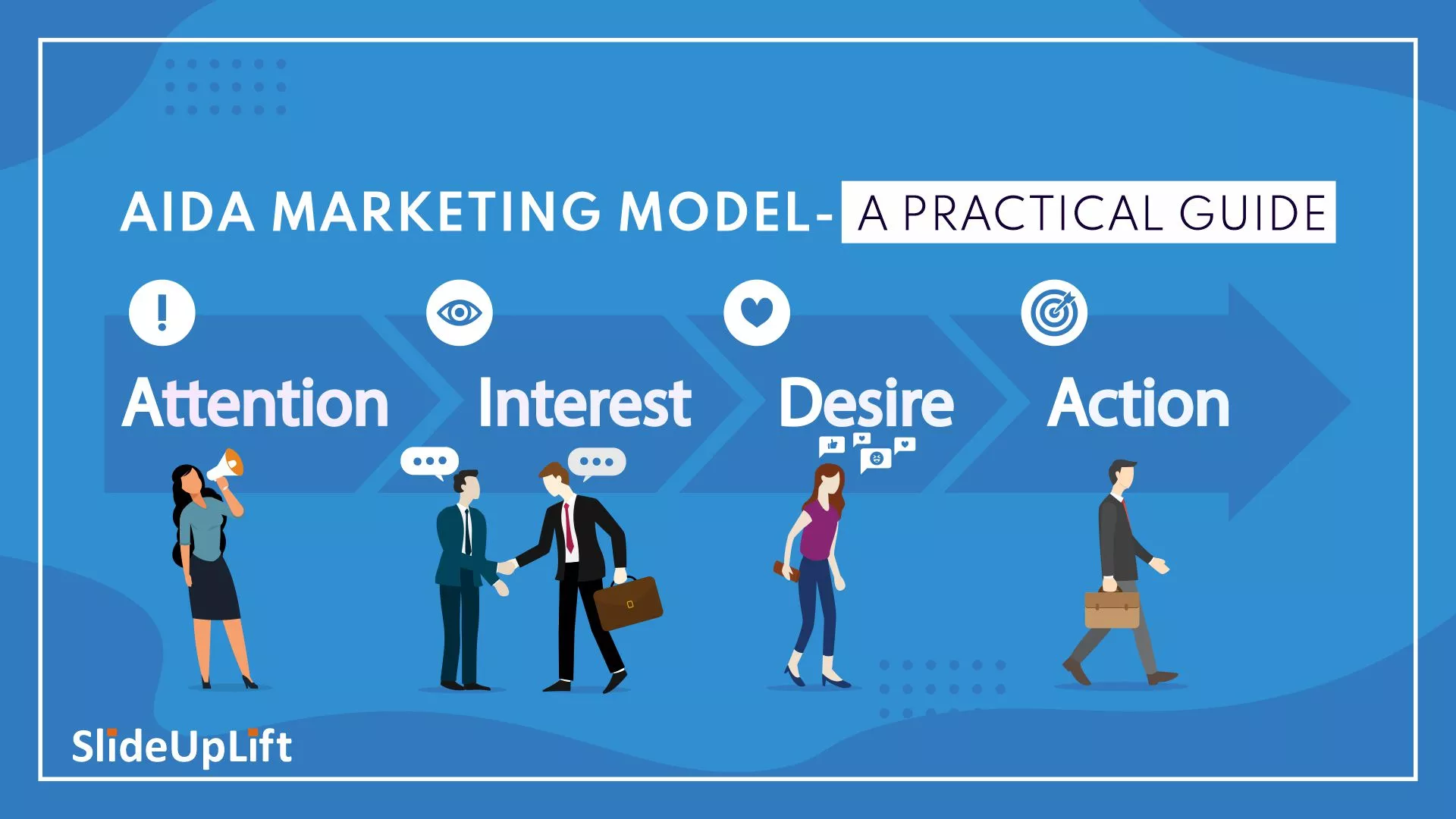
1 Dec, 2021 | SlideUpLift

The AIDA Marketing Model- A Practical Guide
Advertising's purpose is to persuade customers to buy. The AIDA marketing approach is perhaps the most well-known method for accomplishing this. The AIDA marketing model, which follows the customer's journey

21 Sep, 2022 | SlideUpLift
How To Create A Go To Market Strategy Presentation In Just An Afternoon
Are you creating an action plan outlining the measures required to succeed in the market? If you want to convince the management team, investors, or other stakeholders, to support your

29 Jun, 2021 | SlideUpLift
Go To Market Strategy: The missing link between your business aspirations and real success
To bring a product to market, you must go beyond understanding your industry and your market and start to understand your customers. Define the target market for your product by

15 Dec, 2023 | SlideUpLift
How to Create a Successful Project Presentation?
In any business, project managers need to be able to communicate a project strategy to clients effectively. It can bring in new, long-term clients to your agency if done correctly.

18 Dec, 2023 | SlideUpLift
How To Write A Project Proposal Presentation?
Presenting your ideas well is essential to gaining quick approval for projects, whether internal or external. Even the strongest elevator pitch is not going to work by itself. Writing a

20 Dec, 2023 | SlideUpLift
How to Introduce Project Members In a Team Presentation?
The introduction of a project team in a team presentation is not only a formality but a deliberate undertaking with significant consequences in the ever-changing field of project management. It

21 Dec, 2023 | SlideUpLift
Top 10 Project Management Presentation Topics
Project Management Presentation Topics are a range of subjects related to efficiently managing projects. The topics cover different aspects. These include planning methods, team collaboration, risk management, leadership, and emerging
Related Tags And Categories
Forgot Password?
Privacy Overview
Necessary cookies are absolutely essential for the website to function properly. This category only includes cookies that ensures basic functionalities and security features of the website. These cookies do not store any personal information
Any cookies that may not be particularly necessary for the website to function and is used specifically to collect user personal data via ads, other embedded contents are termed as non-necessary cookies. It is mandatory to procure user consent prior to running these cookies on your website.
- Marketing Plans
Strategize to grow your business with the ultimate marketing plan template
Create Your Marketing Plan

- Choose a stunning plan template.
- Customize your plan to fit your goals and strategy.
- Showcase KPIs & targets with 40+ chart options.

Chosen by brands large and small
Our marketing plan maker is used by over 27,500,000 marketers, communicators, executives and educators from over 133 countries that include:
Powerful Presentation Features That Help You Shine
Access a free library of design assets.
Visme offers free access to millions of photos and videos, as well as thousands of icons and shapes. Turn your marketing plan interactive by adding links, buttons, hover effects, pop-ups, animated characters and illustrations, and more. Simply drag and drop graphics onto your marketing plan, and then resize, rotate or change colors as you see fit.

Data visualization made easy
Tell stories with data using Visme’s easy-to-customize data visualization tools. Select from 40+ charts and graphs, as well as exclusive data widgets like radials and thermometers. Upload data manually, import from an Excel file or connect to a Google sheet for live data.

Use our professional marketing plan template to give you a head start

Table of Contents

Evolution Timeline

New Section

Value Proposition

Market Share

Buyer Persona

SWOT Analysis

Competitor Analysis

Marketing Mix

Proposed Strategy

Budget Allocation

Share Your Marketing Plan
Ready to share your marketing plan with your team? Visme makes it easy to publish, download and get feedback on your marketing plan design. Simply download as a high-resolution image, PDF or PowerPoint file, or generate a shareable link to access it online.

LEARN ABOUT MARKETING PLANS
What is a Marketing Plan ?
A marketing plan is a written document or presentation that outlines marketing goals and strategy for the upcoming month, quarter or year. A good marketing plan clearly communicates KPIs and targets, key action items, information about the target market and budget considerations.
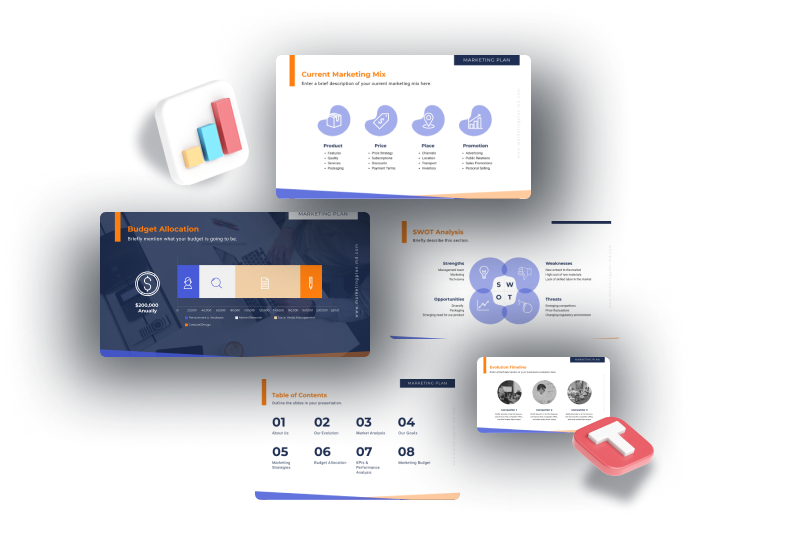
Why do I need a marketing plan?
A strong marketing plan that aligns with your business goals is key to generating leads and growing your business. It acts as a strategic roadmap that helps marketing teams organize, execute and track their marketing strategy throughout the specified period of time.
EVERYTHING YOU NEED + MORE
More Than A Marketing Plan Maker
Scale your marketing tactics and strategies with a well-defined marketing plan. Use Visme’s visual communication tools to organize, execute, and track your marketing strategy.

MAKE IT YOURS
Customize your marketing plan by seamlessly adding your brand. Upload your brand’s fonts, colors, images and logos, or have our AI-based Brand Wizard do it for you.
MAKE IT ENGAGING
Interactivity
Bring your marketing plan to life with interactive content and animation. Make your marketing plan dynamic with a flipbook effect and interactive hotspots.
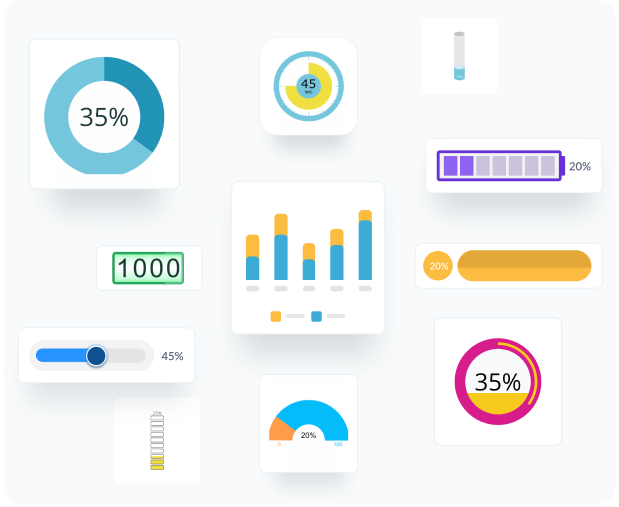
VISUALIZE YOUR DATA
Data Widgets & Tables
Get a bird’s eye view of your marketing strategy with tables, charts and graphs. Add infographics and data widgets to visualize your marketing budget, buyer personas and other key marketing information.
HOW IT WORKS
How to Make a Marketing Plan in 5 Steps
If you are wondering how to write a marketing plan, you’ve come to the right place. Instead of creating your marketing plan from scratch, use our marketing plan templates to quickly get started with pre-designed layouts.
- Log into Visme and choose your favorite marketing plan template.
- Replace placeholder content with your own, and customize colors and fonts.
- Insert free images, icons and charts, or upload your own brand assets.
- Add, remove and rearrange pages or slides to match your content.
- Download your marketing plan in high-quality or share online with a link.
Questions About the Marketing Plan Template
How much does it cost to create a marketing plan with a marketing plan template, what types of charts and graphs are available in visme, can i use my brand kit to create my marketing plan with visme, are the marketing plan templates completely customizable, are the photos and icons in the library free to use, your marketing plans deserve to be beautiful and so does the rest of your content.
Sign Up Free

Create Killer Marketing Presentations (Examples & Templates)
Learn from the best marketing presentation examples how to engage your audience, persuade & reach marketing strategy goals for your business or product.
6 minute read

helped business professionals at:

Short answer
What does a marketing presentation include.
The key elements that every marketing presentation should include are:
- Introduction
- Market overview
- Product/service overview
- Marketing strategy
- Competitor analysis
- Performance metrics
- Action plan
- Projections
- Conclusion and next steps
Why most marketing presentations don't work
No one has patience for marketing presentations . And what’s the point of making a marketing presentation if no one will listen or bother to read it?
Whatever marketing presentation you’re making at the moment it’s likely full of attention-killing legacy “best practices”. Even worse, it’s drowning in a sea of noise by other presentations competing for your audience's attention.
Let me show you some marketing presentation examples that manage to avoid common presentation mistakes, and manage to stand out, grab attention, and make a persuasive case.
How to create an effective marketing presentation
Each presentation has its unique recipe for success. Whether it's a strategy, a plan, a branding project, a product pitch, or a performance analysis, they all have little details to look out for.
STRATEGY & PLAN
BRANDING & PRODUCT
PERFORMANCE ANALYSIS
Strategy & plan marketing presentation
To breathe life into your strategy and plan presentation, paint a vision of the future.
Start with a robust situational analysis, highlighting key findings about your market, competition, and audience.
Define SMART (Specific, Measurable, Achievable, Relevant, and Time-bound) marketing objectives that directly link to your strategies.
Present clear and concise strategies, directly aligned with the objectives.
Wrap up with detailed tactics and action plans, using compelling visuals to engage your audience and simplify complex information.
Branding & product presentation
When presenting on branding and product, you're essentially telling a story.
Showcase the personality, values, and unique selling proposition (USP) of your brand.
Introduce your product or service, making it tangible and valuable to your audience.
Utilize customer testimonials, case studies, or live demos to demonstrate the benefits and solve problems.
Make your audience fall in love with your brand and product to create strong brand ambassadors.
Performance analysis presentation
Performance analysis presentations are all about the numbers — but don't let that intimidate you.
Begin with an overview of campaign objectives and strategies used.
Dive into the data, highlighting key metrics and KPIs to analyze performance.
Use clean and clear charts and graphs to visually present the story of the campaign.
Showcase wins and successes, but also discuss areas for improvement as valuable learning opportunities.
Conclude with key takeaways and next steps, demonstrating transparency and setting the stage for ongoing success.
Marketing presentation examples that work
It’s time to see some examples of how marketing presentations are made in practice.
All the examples I bring you here are 100% customizable and you can use them as templates to create your own content.
These examples are modeled after engaging presentations based on our extensive data. They apply content structure and best practices we’ve seen work for high-stakes presentations.
Marketing plan & strategy
This example of a marketing plan presentation gives you a lean and effective structure to present the essence of your plan to your team members and higher-ups.
It cover everything from challenges, target audience, goals, KPIs, game plan, and budget, to milestones.
As Head of Marketing at Storydoc I use this format to launch our activity every new quarter and get everyone onboard.
Marketing plan one-pager
This example is a shorter version of the marketing plan example above. It can be used as a useful recap after presenting the plan in full face-to-face.
It can also be very effective to give decision-makers (internal or external) a quick overview of your plan without overloading them with details.
Marketing agency pitch deck
This marketing presentation example is the go-to for any creative agency or marketing services provider.
It’s a kind of company intro with the essential information about the services you provide, your strategic approach to marketing, and what makes you different.
What makes this marketing presentation so effective is the attention grabing video cover, its commitment to measured results, the case studies it presents to back up the claims, and the clear pricing offer that enables buyers to make an easy educated decision.
Marketing one-pager
We’ve seen this marketing one-pager format work well for agencies and marketing service providers. It’s the minimalistic version of the agency pitch deck I showed earlier.
It works because it gives context fast and communicates value very simply.
It tells your prospect who you are, outlines a major problem they need to address, and explains briefly how you can solve it for them and what the process is going to look like.
It finishes with the benefit the prospect can expect to gain and ends with a strong CTA last slide with a calendar app that lets prospects easily book a meeting.
Early stage marketing proposal
This marketing proposal presentation is used by many of our clients instead of the marketing agency pitch decks. It’s a more baked version, more serious if you like.
This approach works better for big clients that need a more personalized, and detailed pitch.
This example includes concrete data about the prospect’s market, and addresses specifics like the goals you propose, your marketing strategy, tracking and measurement, timeline, and budget.
Late stage marketing proposal
This marketing proposal presentation is used by many of our clients in the later stages of their sales cascade.
Notice that it is personalized to a specific prospect, and addresses them by name.
This example uses dynamic variables from your CRM to pull contact info directly into your presentation, such as the contact’s name, job title, brand colors, personal message, pricing offer, and more.
It includes all the talking items you’ve covered with your prospect which are critical for them to make their buying decision.
And most importantly, the presentation includes an e-signature box that lets the prospect seal the deal then and there.
If you want to have a cozy relationship with media and news outlets then having an attractive and well-organized media kit is pretty important.
It’s used by our clients to take control of how their company is presented in the media.
It’s a basic marketing tool that comes in handy whenever you’re working with other publishers from from newspapers, magazines, or TV, to social media or blogging influencers.
Marketing case study
This marketing case study presentation is a great addition to your prospecting and sales process.
It follows the Challenge-Solution-Results framework that proved to be the most engaging content structure based on our data.
The interactive format grabs the attention of prospects and helps keep them engaged throughout.
Storydoc lets you easily generate an animated GIF you can drop in your prospecting email to catch prospects’ eye and compel them to click the case study link.
Marketing presentation templates
Now that you’ve seen examples of great marketing presentations it’s time to dive a bit into the theory behind the reasons they work. That’s what the rest of this post will be about…
But if you’re too busy managing your marketing team or writing your marketing plan , you’re welcome to skip the theory, just grab a template, and get to work.
Trust that all the marketing presentation templates here apply every insight and tactic I cover in this guide
These templates were built based on what we’ve seen work for our clients again and again, and based on our analysis of over 100,000 reading sessions.
You don’t have to know why they work. They just do. Grab one!
Types of marketing presentations
PRODUCT MARKETING
MARKETING STRATEGY
MARKETING PLAN
MARKETING PITCH DECK
MARKETING PROPOSAL
MARKET ANALYSIS
MARKETING CAMPAIGN
Product marketing presentation
This is your stage to spotlight your product or service. Dive into unique features, benefits, and the problem it solves for your customers. Remember, it's not just about what your product is, but why it matters.
Marketing strategy presentation
The beating heart of your brand's direction, this presentation outlines your game plan to reach your audience. It covers your unique selling proposition, target market, distribution channels, and more. Think of it as your strategic compass guiding you to your business goals.
Marketing plan presentation
Detailing your tactical roadmap, this presentation is where strategy meets execution. It includes your specific marketing activities, timeline, budget, and key performance indicators. Your plan is your strategy's vehicle - fasten your seatbelts and let it drive you to success!
Marketing pitch deck
The marketing deck is a presentation used by marketing agencies, consultants, and service providers for prospecting new clients. It touches on a known problem faced by the prospects and features their services as the solution.
You can grab a customizable marketing pitch deck template here .
Marketing proposal
The marketing proposal is a presentation used at the later stage of the sales process by marketing agencies, consultants, and service providers. It includes the specifics of the services on offer, their cost, deliverables, measurement, milestones, and timelines.
Market analysis presentation
In this presentation, you dissect your market to unearth valuable insights. Understand your customer demographics, identify trends, and evaluate market size. It's your secret weapon to stay one step ahead of the competition.
Marketing campaign presentation
This presentation highlights your creative initiatives aimed at promoting your product or service. It showcases your campaign theme, messaging, promotional channels, and projected outcomes. It's your marketing storybook – captivate your audience with every page.
Marketing presentation best practices
A winning marketing presentation can make all the difference between a yawn and a standing ovation. But, how do you actually do it?
Craft that perfect blend of content, storytelling, brand message, personalization, and relevancy.. Let’s break it down.
The first 3 slides determine whether people will bounce or read on - make them count.
- Think deeply about your hook
- Use the person's name and company logo in the title
- Prioritize the information that matters most to your audience
- Be very short and to the point
Our data shows that 32% of people bounce from your deck in the first 15 seconds. But more importantly 80% of readers who cross the 3rd slide threshold will read the deck in full.
Imagine you were giving a speech and after 3 minutes a 3rd of the audience just stood up and left the hall. That would feel horrible, wouldn’t it? So why do this to your decks?
What you can do is write a relevant, personalized, and intriguing hook, and place it on slides 1-3 of your deck.
- Make the audience understand that you’re writing FOR THEM , about THEIR NEEDS, but also that you have something amazing up your sleeve.
- A little known trick to get attention is to tell them how long reading your deck will take. Time is their currency, you wouldn’t ask a client for “money” without tellig them how much, would you?
- You should also have a strong visual hook . Use a video, animate d, or interactive cover slide. Make it so they can’t look away.
Here's an example of a video cover that acts as a visual hook:

2. Storytelling
Every great marketing presentation is a story with a beginning, middle, and end.
Hook your audience with a compelling introduction, then build intrigue as you progress, and finish with a memorable conclusion. Ensure your story has a human element — this emotional connection can turn listeners into advocates.
Here’s our recommended storyline structure:

3. Brand messaging
Consistency is key in brand messaging. Your presentation should reflect your brand's voice, values, and visual identity at every turn.
This not only enhances recognition but also builds trust. Remember, a strong brand doesn't just sell a product or service, it sells an experience.
You can do this by pulling your brand colors from the brandbook:

4. Personalization
Make your audience feel special with personalization. Address them by name, incorporate their company logo, or include a heartfelt personal message. Tailor your call-to-action to resonate with them on a personal level.
Our data shows that presentations with personalized notes are 68% more likely to be read in full compared to general presentations.
More impressively, personalized content led to a 41% increase in average reading time , and presentations customized for a specific prospect were shared internally 2.3x more often.
So, sprinkle in that personal touch, and watch engagement explode!
5. Relevancy
Address your target audience's pain points in your value proposition and content. Show them you understand their challenges and you have the solution they've been looking for.
When your audience sees themselves in your presentation, they're more likely to see the value in what you're offering.
6. Interactivity
Including interactive slides in your presentation increases engagement.
Our data shows that presentations with tabs to click through, live data calculators, sliders with case studies, or customer testimonials were scrolled to the bottom 41% more often, leading to a 21% longer average reading time.
- Integrate interactive features like videos, tabs, live graphs and charts, calculators, or sliders
- Use video and animations to illustrate complex ideas
- Avoid text-heavy slides
- Test user interactivity to ensure all the features work

I lead Storydoc's team of marketing gentlemen and women dedicated to eradicating Death-by-PowerPoint wherever it lurks. Our mission is to enable decision-making by removing the affliction of bad content from the inboxes of businesses and individuals worldwide.
Found this post useful?
Subscribe to our monthly newsletter.
Get notified as more awesome content goes live.
(No spam, no ads, opt-out whenever)
You've just joined an elite group of people that make the top performing 1% of sales and marketing collateral.

Create your best marketing presentation to date.
Try Storydoc interactive presentation maker for 14 days free (keep any presentation you make forever!)
We use essential cookies to make Venngage work. By clicking “Accept All Cookies”, you agree to the storing of cookies on your device to enhance site navigation, analyze site usage, and assist in our marketing efforts.
Manage Cookies
Cookies and similar technologies collect certain information about how you’re using our website. Some of them are essential, and without them you wouldn’t be able to use Venngage. But others are optional, and you get to choose whether we use them or not.
Strictly Necessary Cookies
These cookies are always on, as they’re essential for making Venngage work, and making it safe. Without these cookies, services you’ve asked for can’t be provided.
Show cookie providers
- Google Login
Functionality Cookies
These cookies help us provide enhanced functionality and personalisation, and remember your settings. They may be set by us or by third party providers.
Performance Cookies
These cookies help us analyze how many people are using Venngage, where they come from and how they're using it. If you opt out of these cookies, we can’t get feedback to make Venngage better for you and all our users.
- Google Analytics
Targeting Cookies
These cookies are set by our advertising partners to track your activity and show you relevant Venngage ads on other sites as you browse the internet.
- Google Tag Manager
- Infographics
- Daily Infographics
- Popular Templates
- Accessibility
- Graphic Design
- Graphs and Charts
- Data Visualization
- Human Resources
- Beginner Guides
Blog Business 12 Marketing Presentation Examples for You
12 Marketing Presentation Examples for You
Written by: Danesh Ramuthi Nov 29, 2023

Crafting an effective marketing presentation is essential in today’s competitive business landscape. A marketing presentation, fundamentally, is a dynamic communication tool utilized by businesses to present their marketing ideas, strategies, goals and achievements to a specific target audience.
Typically, this involves presenting a marketing plan, showcasing marketing campaign initiatives, or highlighting the success of a marketing strategy through engaging stories and compelling data.
Well, if you are wondering how you can create your own marketing presentation then worry not.
With Venngage presentation maker and their customizable marketing presentation templates , you can take these ideas and mold them into your own successful business narrative. These professionally designed presentation templates are visually appealing and easy to use, ensuring that your marketing presentations not only inform but also engage your audience.
Click to jump ahead:
12 marketing presentation example
How to create an effective marketing presentation.
- How to present a marketing plan
- Wrapping up
In business communication, marketing presentations stand out as a pivotal means of sharing ideas and strategies. A prime example of a marketing presentation vividly demonstrates how to effectively communicate a company’s marketing strategy, objectives and achievements.
Let’s look at a few examples of marketing presentations and how they can cater to different scenarios.
Marketing strategy presentation example
A stellar marketing strategy presentation example showcases the intricate planning and execution of a company’s marketing efforts. It begins by defining the target market and the unique challenges it presents. The presentation then outlines the key marketing objectives and the strategies devised to meet them.

Emphasizing on the unique selling point of the product or service, it weaves an engaging story that resonates with the potential customers. The use of real-life examples and data-driven results adds credibility and helps in presenting a compelling case.
They also highlight how to effectively use marketing channels and digital tools to maximize reach and impact.
The key takeaway from such a presentation is not just the strategy itself, but how it is communicated to ensure the audience understands and remembers the key messages, aligning with the overall business goals.

Marketing plan presentation example
A marketing plan presentation example is a comprehensive deck that outlines a company’s roadmap for marketing success.
It starts with an analysis of the current market conditions, identifying potential customers, and discussing contemporary trends.

The presentation then delves into the specifics of the marketing plan, detailing the marketing channels to be used, the marketing budget and the timeline for implementation. It provides insights into the unique value proposition of the product or service and how it will be communicated to the target audience.
The use of powerful visual elements and bullet points helps in presenting complex information in an easily digestible format. This type of presentation also often includes a timeline slide to give the audience a clear sense of the plan’s progression.

The objective is to present a clear, actionable plan that aligns with the company’s overall business goals and to persuade the audience of its potential success.
Digital marketing presentation example
In a digital marketing presentation example, the focus shifts to how digital channels can be leveraged to achieve marketing objectives.
This presentation type is visually appealing and uses design elements that resonate with digital trends. It begins by outlining the digital marketing strategy, including SEO, social media, email marketing and content marketing.

The presentation shows how these digital channels can be utilized to reach a broader audience, create awareness and drive engagement. It includes real-life examples of successful digital marketing campaigns, highlighting key takeaways and the impact on business growth. The presentation also discusses the importance of analyzing data to refine marketing efforts continually.
A digital marketing presentation is an engaging and informative tool, providing key insights into how digital channels can be effectively utilized for a successful marketing campaign.

It leaves the audience with a clear understanding of the digital marketing landscape and the company’s approach to harnessing its potential.
Social media marketing presentation example
A social media marketing presentation example focuses on illustrating a company’s strategy for leveraging social media platforms to enhance its marketing efforts. Usually, this type of presentation begins by highlighting the importance of social media in contemporary marketing and how it can be a powerful tool to reach potential customers and create engagement.

It showcases the specific social media channels the company plans to use, tailored to the target audience and the unique selling points of the product or service. The presentation further delves into content strategy, including the types of posts, frequency and engagement tactics.
Real-life examples of successful social media campaigns are often included to provide inspiration and demonstrate practical applications.

Key performance indicators and methods for measuring the success of social media efforts are also discussed, emphasizing the need for data-driven strategies.
Marketing campaign presentation example
A marketing campaign presentation example is a detailed display of a company’s planned or executed marketing campaign. It starts by setting the scene with the campaign’s background, objectives and target market.

The presentation then unfolds the campaign’s key message and the unique value proposition it offers to the target audience. It outlines the various marketing channels and tactics used, such as digital advertising, press releases or influencer collaborations, providing a comprehensive view of the campaign’s approach.
The use of engaging stories and visual elements , like graphics and videos, makes the presentation both captivating and memorable. This example also includes a section on the budget and resources allocated for the campaign, offering a realistic view of the campaign’s scope.
Key takeaways and predicted outcomes, based on market analysis or previous campaigns, are highlighted to give the audience an understanding of the expected impact and success metrics of the campaign.

Creating an effective marketing presentation involves a series of well-thought-out steps to ensure that your message resonates with your audience. Here’s a step-by-step guide:
- Seize your audience’s attention : Begin your presentation by addressing the audience’s main concerns or pain points. Ask dramatic, thought-provoking questions to ignite emotions and engage your audience from the start.
- Promise something and deliver it : Make clear promises about what your presentation will deliver. This could be solutions to problems, new insights or actionable strategies. Ensure that you fulfill these promises throughout your presentation.
- Tell an engaging story backed by data : Use storytelling to make your content relatable and personal. Introduce real-life examples or scenarios and support them with solid data to add credibility.
- Have less slide content rather than more : Avoid overloading your slides with text. Keep content concise and support your speech with key points, visuals and high-quality images. Using multiple slides with relevant images can help maintain audience attention.
- Use humor wisely : Lighten the mood by incorporating appropriate humor through witty wordplay, GIFs or memes, ensuring it’s relevant and not distracting.
- Conclude with a clear call to action (CTA) : At the end of your presentation, reiterate the key points and instruct your audience on the next steps or actions they should take. This could involve asking questions, applying the information provided, or engaging in further discussion.

Read Also: 12 Best Presentation Software for 2023
How to present a marketing plan?
Presenting a marketing plan effectively is a key step in communicating your strategies and aligning your team towards common goals. Here’s a comprehensive guide to crafting an effective marketing plan presentation:
- Executive summary : Begin with a concise overview of the marketing plan, highlighting key objectives, target market and strategies.
- Market analysis : Present detailed market analysis including size, trends, customer segments and competitive landscape, supported by data and research.
- Marketing objectives : State clear, SMART marketing objectives, aligning them with overall business goals.
- Target market and buyer persona : Describe target market segments and buyer personas, detailing demographic, psychographic and behavioral characteristics.
- Competitive analysis : Analyze main competitors, their strengths, weaknesses, market share and key differentiators.
- Marketing strategies : Outline key marketing strategies for product positioning, pricing, distribution, promotion and branding.
- Action plan and timeline : Present a detailed action plan with specific tactics, activities and timelines.
- Budget and resource allocation : Provide an overview of the marketing budget and its allocation across various activities.
- Performance measurement and KPI : Highlight key performance indicators to measure the success of the marketing plan.
- Conclusion and next steps : Summarize main points, key takeaways and outline next steps in the implementation process

Related: 8 Types of Presentations You Should Know [+Examples & Tips]
Wrapping up
I hope you’ve gained valuable insights and inspiration from this article to elevate your own marketing efforts. From the intricacies of a marketing strategy presentation to the creative approaches in digital and social media marketing, each example serves not just as a guide, but as a springboard for your own innovative ideas.
The steps to creating an effective marketing presentation and presenting a marketing plan underscore the importance of structure, storytelling and audience engagement. These are your tools to transform data and strategies into compelling narratives that resonate with your audience.
Use these examples, tips and tools to create presentations that effectively showcase your marketing ideas and strategies. Let your presentations be the window through which stakeholders view your vision and commitment to excellence.
As you step forward to apply these learnings, remember the power of professional and visually appealing presentations.
Venngage presentation maker and their customizable marketing presentation templates offer a variety of options to suit your unique marketing needs. These tools are designed to help you craft presentations that are not only informative but also aesthetically engaging, ensuring your message is both seen and remembered.
Discover popular designs

Infographic maker

Brochure maker

White paper online

Newsletter creator

Flyer maker

Timeline maker

Letterhead maker

Mind map maker

Ebook maker
6 Simple Steps for a Successful Personal Marketing Plan
Your personal marketing strategy plan is used to showcase your goals and uniqueness. Use these 6 awesome tips to dominate your industry or niche!
Subscribe to our weekly newsletter
Personal marketing plans are the perfect go-to resource if you’re looking to be ahead of the game in your career.
Helping with this article is CEO of Bright Ideas Only, Kim Kaupe . She was previously named as Forbes 30 Under 30 and is the perfect person for a personal marketing plan!
Personal Marketing Plan (Definition)
A personal marketing plan, or PMP, is a document that communicates ideas and goals related to a job search, marketing strategy, or new career path. A personal marketing plan is a future-oriented document that highlights your personality, professionalism, and what makes you or your brand stand out.
Brand (n.) – A concept that helps people identify a company, product, or individual.

Why Are Personal Marketing Plans Important?
Among a few key reasons why personal marketing plans should top your to-do list is that they showcase your skills, pump up your productivity, and help you get organized.
Let’s take a look, starting with…
Personal Marketing Plans Showcase Your Skills
Instead of having a plain old portfolio like everyone else, personal marketing plans are like the Rolex of portfolios.
They show that you’ve not only gathered all your resources in one place and know yourself but also that you’re highly diligent and have done your research.
So, if you show your PMP to other professionals, businesses, and potential clients, they’ll get to know your successes and unique work style that much better.
Personal marketing plans are like an elevator pitch – but in paper form.
Personal Marketing Plans Pump Up Productivity
A marketing plan keeps productivity flowing like a river because it contains step-by-step instructions about how you’re going to achieve and execute your career and professional goals.
No more “I’ll just wing it” plans—PMPs are detailed and give confidence just by creating them, since you’ll have your own step-by-step plan.
And who doesn’t like a well-structured plan?
Science proves that they work. A 2016 study revealed that having a functional system increases productivity.
Systems like planners or project management software help by ensuring consistency, which, in turn, makes your efforts repeatable to obtain the same or even greater level of productivity in the future.
In other words personal marketing plans are like having your own J.A.R.V.I.S. to keep you on track.
Personal Marketing Plans Keep You Organized
As we can relate, organization is key to having a well-oiled business. You can think of marketing plans as seeds—they make the products and profits grow!
Without a PMP, how do you know which factors drive your business or personal growth? And more importantly, how are you going to showcase that to others?
With a personal plan, all the stresses dissolve, leaving the seeds you planted to take root.
6 Easy Tips for Making a Personal Marketing Plan
Now, you may be wondering… What goes into creating a personal marketing plan?
In short, you need a brand identity, a summary of your values, target audience, industry, experience, and relevant skills.
Here’s how to do that.
Develop A Personality

Think of Red Bull, Tesla, and Harley Davidson, and you’re going to find people who either love the brand or hate it with a passion.
Because these brands have a strong personality – and they’ve amassed fans who love them for that.
Using a brand strategy plan, you too can create the characteristics of your own professional personality that make people love you or hate you (it’s a part of business!).
A brand strategy plan outlines three major factors:
- Heart: Purpose, vision, values
- Message: Personality/tagline
- Identity: logo/colors
Try this fun brand strategy exercise called “The Comparison Game.” Ask yourself, “If your brand was an animal, which would it be?”
You might think of your business as a tiger, for example. Tigers are courageous, bold, and smart.
Now, you probably don’t want to go proclaiming your business is like a tiger, but let’s break it down:
- Take the main characteristics of what makes your chosen animal so special. If it’s a tiger, they may be bold and courageous. Or if it’s a raven, it might be clever and knowledgeable. This is your heart factor that covers your purpose and/or values!
- Use these traits to envision how your brand would look if it had these characteristics. This is your message factor and the personality of your brand. You can even add a snazzy tagline that includes animal elements (see mine below).
- Finally, you’ll want to get the design aspect down as part of your identity. What logo and colors does your personal brand represent? Can you tie it in with your chosen animal to get the message across? Take a look at Science of People’s front page for an example on how we use colors to our advantage!
In the end, you’ll have a personal message that goes something like this:
“My purpose is to spread courage in the world. My motto is ‘Be brave and roar.’” (with yellow/black colors throughout the plan)
Now write down your own personal message! Once you have your personality in check, the next steps become much easier.
Let’s move on to…
Identify Your Target Market

Once you’ve got your personality down, it’s time to cater towards your target market.
And you might be wondering what the difference is between a market and audience.
The target market is the whole group that you’re attempting to persuade, while the target audience is a particular type of individual from the market.
Imagine this… your goal is to be the best shirt salesperson out there, and you’re selling blue shirts through the phone and on the computer.
Your target market would be “online clothes shoppers,” while your target audience would be “individuals searching for blue shirts.”
In other words, your market is a broad, general category or group, and your audience is the actual customer or individual you’re targeting.
Markets are simply used to define your customer (aka how you’re going to make money).
Yours can be singular or multiple markets.
Target markets can be based on several factors including:
- Location. Are you primarily targeting audiences in London or America? Typically, your location is the same location you’re located in. For our blue shirt example, lets say we are primarily targeting US-based online shoppers.
- Distribution channels. Even if you’re based in one location, you can be online or set up shop in a brick-and-mortar store. In our example, we might be distributing through Amazon.
- Type of product. What are you actually trying to sell or provide? Is it a physical product or a service? Informational, educational, or entertainment?
If you’re stuck trying to find your target market, here are a couple techniques you can try:
- The Network Effect. Of course, asking your friends and close ones might be the way to go! But better yet, actually having them buy your product or service is an even better bet. After all, your friends and family might not want to hurt your feelings, or they might be just a little biased… Like those American Idol contestants whose friends say they’re “amazing.”
- Survey it Up! The next technique is to ask people on the internet! You can do this by going to Amazon Mechanical Turk or SurveyMonkey and creating a survey for others to take. This does require some money up-front though , so you’ve got to have a good idea of what you’re going to ask.
For a list of questions to ask, check out these questions by Alexa :
- How likely are you to recommend our brand to a friend?
- How long have you been a customer?
- What problem does [product/service] solve for you?
- How does the [product/service] fit into your daily workflow?
- How well does [product/service] meet your needs?
- What do you wish the [product/service] had that it currently does not?
- What do you like [most/least] about [product/service]?
- What made you choose us over a competitor?
- How would you rate your last experience with us?
Find (or Create) Your Niche

A niche is a focused area within a broader market.
If it helps you visualize, imagine the market could be broad like “meat” while a niche of that market would be “vegan meat.”
Carving out a niche in the larger market, according to Business and Branding expert Dr. Charlene Walters , “ differentiates your business from the competition and allows you to excel in your sector .”
And it makes sense – if you were looking for a blue shirt yourself, would you look in the general store or shop at a store that sells exclusively blue shirts?
Exclusivity is the goal here, so you can thrive with nothing in the world to stop you!
Oh, except for your competition, of course.
Which is why determining what makes you different from your market adversaries is vital to your personal marketing plan—and your business—becoming a huge success!
From the most practical to the silliest ideas you’ve ever heard of, there are niche markets with untapped business potential that could assist you in developing a specialized marketing plan worthy of applause.
Check out this video to help you pinpoint your niche:
Locate Your Target Audience

Now that you know your target market, let’s get down to the nitty-gritty.
Here are 3 helpful tips I’ve used to create a target audience for a personal marketing plan.
- Determine ideal client demographics . Unlike the target market, you’re going to break it down to the individual level. Include traits like:
- Age. Is there a specific age your product would be effective? Our target age for individuals looking to buy blue shirts would be between 25-50.
- Gender. What gender does your target product attract the most? We could say we are targeting primarily men with some women.
- Economic status . Are they low, moderate, or high income? We’d mark moderate for this one.
- Industry . Is there a specific industry your target audience is in? We could market our product to be any professional, or niche down to IT professionals.
- Educational status. Did they graduate school? Get an advanced degree? Our target audience has graduated with a bachelor’s degree or higher.
- Family. Are they married or single? We could say our target demographic is married.
…And any other attributes that take them from an ideal to a real-life client.
This will give you a clearer and more exciting perspective on the audience that you’ll be serving and solid ideas on how to attract your personalized level of clientele.
- Identify the needs of your target clientele.
- How does what you’re servicing heal their “pain points”?
- Are your prices within their budget?
- What concerns might they have that might prevent them from buying your service?
- Locate your clientele. In the game of marketing, cordially stalking your customer IS necessary! So, ask yourself easy questions like:
- “ Which social media platforms do customers hang around the most? ”
- “ Are there any blogs or groups that my clients frequent? ”
- “ Which piece of content really caught their eye ?
You can even go all “digital ninja” and do a keyword search or two to find startup and small business leads looking for your service.
Remember, the goal is to find them and reel them in!
And once you do that, you’re one step closer to bringing your audience to life…
Create a Plan of Action

Create your marketing plan of action with implementation strategies!
An implementation strategy consists of techniques used to employ information for a social or clinical outcome.
A 2013 Washington University at St. Louis’ study reported how specifying, defining, and operating within a structured system significantly improved outcomes, especially in the clinical setting.
In other words, the more you can structure your plan, the better the outcome will be.
Luckily, the concept applies in both the clinical and business setting.
Sounds simple enough, but how do you create a marketing implementation plan ?
Here’s the how-to:
Set realistic expectations and time frames. Like I said before, find that sweet spot between being too relaxed and overly stressed.
- Collect your necessary resources. Before sitting down to do business, what exactly do you need for your business? Write down what you have before listing what you need.
- Write down your marketing strategies and goals. OK, now we’re getting there. What do you want to achieve out of your plan of action? Write that down, too! For example, I might want to get 10% more sales from my efforts.
- Create activities for completing each goal. For my above example, if I want 10% more sales, I might try implementing Facebook ads or promoting more on my website.
- Measure your results. This is key. At what level did you achieve your goal? Did you blow your expectations out of the water, or are you barely floating?
Check out this cool example about how “Mark” used his implementation plan.
Mark wants to sell his designer cupcakes to children and families.
- Mark gives himself one month to find his target audience.
- He collects the locations of where children and families can be found and buys the ingredients for his cupcakes.
- Mark creates a plan to sell his cupcakes at birthday parties & school functions and to create a website for his bakery.
- Mark speaks to school administrators four times a week and adds special keywords to his website, and he gives free samples to the neighborhood children to build his brand awareness.
- At the end of the month, Mark tallies how many schools and parties agreed to his service and finalizes his sales.
“ Marketing activities ” are your action stages and play a major role in accomplishing your micro goal. They can also be measured by small objectives that lead to success of the larger goal .
The best way to implement this is to break down each goal into 2 to 4 smaller goals that can be achieved within a fair amount of time. In due time, you’ll realize that your marketing message is being received by the public bit by bit.
Wise words were once said: “How do you eat an elephant? One bite at a time.”
Get Fancy and Professional

One of the best things about being an entrepreneur is buying the “business stuff” like:
- Business cards
- Accessories (mugs, pens, and other knick-knacks!)
While these items make us ready on the outside, do you know the one thing most people miss out on when making their personal marketing plan?
Creating a unique design for yourself to stand out!
Whether you’re on a job search, an independent contractor, LLC or S Corp, developing a fully designed brand identity will make your ideal clientele feel safer about working with you and present you in a more established, professional light.
But if you’re still an entrepreneur struggling to get by… feel free to skip this step!
On the other hand, if your business is taking off and you’re ready to take a leap:
- Determine a business structure type (sole proprietor, partnership, corporation, LLC).
- Create a corporate design (logo).
- Set up your company mission and objectives.
- Decide on the corporate communication you want to use to get the word out (press releases, social media, search engines).
Don’t forget! Re-evaluating your company on a monthly or quarterly basis is important at this stage.
Can I See an Example of a Personal Marketing Plan?

One of the leading online job-hunting curators, Career Sherpa , has devised an effective personal marketing plan to show how our independent contractors or entrepreneurial friends can make it all fit on one page.
Entering out on his own, our buddy Franco Rinaldo highlights his brand identity with his almost two decades of services and millions of dollars that he’s brought in. He recruits his clients by illustrating his competencies and specifies his target market and companies.
Small business personal marketing plans are more detailed and specific.
There are different types of marketing plans to choose from, like:
- Advertising plan
- Content marketing plan
- Direct marketing plan
- Social media marketing plan
- Branding plan
The plan that you use is based on the outcome that you desire.
If you want people to know your company exists, a branding plan may be your best fit. Or perhaps you want people to check out the latest edition to your gallery? That’s where a content marketing plan comes in.
Any Personal Marketing Templates Out There?
But of course! You weren’t expecting to do all that work and not actually put it somewhere , were you?
I highly recommend creating your own personal marketing plan. After all, your goal is to be unique here, right?
However, you can still take inspiration from these personal marketing plan templates to help you execute your marketing goals:
- Template.net’s Personal Marketing Plan Templates
- Visme’s Marketing Plan Templates
Keep these valuable tips in mind while developing your personal marketing plan and you’ll have more success sooner than later.
Bonus Tip: Prioritize Your Strategies
There are plenty of marketing strategies to fuel your business growth and you’re probably already using some of them.
Advertising on Facebook or Linktree? Or perhaps you’re blogging and making resource videos?
Whatever method you’re using, you’re going to need to prioritize.
Here are some ways you can prioritize your work and marketing strategies:
- Create a list of all your tasks. For example, I like to keep a handy journal next to my work station at all times. Whenever I have a new task that pops up, it goes straight into my planner to complete for the day (or later in the week!). The goal of my journal is so I don’t lose track of all the tasks coming my way—which is easy when you’re an extremely busy business person!
- Identify and highlight your important goals. Of course, not all goals are equal. What are your A tasks? These are the tasks that need to be completed soon so bad things don’t happen. Complete your A tasks first before moving onto less urgent ones. You might want to create a system like starring or creating letters to identify your top-priority tasks.
- Set realistic dates of completion for each task. Trying to squeeze your brain to write a 10-page blog post in one night might not cut it. However, give yourself too much time and you might not be optimizing your productivity .
- Structure your workload. This might mean planning your day ahead of time. Keep in mind your optimum energy levels throughout the day and plan to tackle your hardest tasks during this time.
- Focus and complete one goal at a time. I get it; multitasking can be fun and you might “feel” great doing it. But several studies show the dangers of multitasking and how it can really hamper your productivity. Go the old Brian Tracy method and eat that frog instead.
- Keep a log of your completed tasks. OK, this one’s kind of personal, but I love reviewing all the things I’ve done at the end of the week. It really helps to visualize all that I’ve done and feel like those grind times were well worth it!
Try out these helpful tips and let us know if concentrating on the tasks you set for yourself worked. With each completed goal, you’ll be a lean, mean, marketing machine!
Bonus Tip #2: Start With LinkedIn
There’s a reason LinkedIn is regarded as the most trusted social media platform in the US. If you haven’t started yet, capitalize on these easy tips to stand out:
- Have an updated profile picture. Get rid of that old embarrassing highschool profile picture and replace it with a professional one—you can even take one using your phone with the right setup!
- Write a (simple) description. Ideally, you’ll want to use the same lingo as your target companies. If they use words like “leverage” or “synergizing,” you might benefit from adding these words in. Keep in mind you’ll probably want to write in an easy-to-read format and keep it under college-level writing (writing more technically does not equal writing better). Use the Hemingway App and check for readability levels.
- Connect with 5 people. If you’re introverted or just getting started networking, you might want to start small. Aim to connect with 5 individuals—that’s it! These people can even be high school friends, relatives, former colleagues, and other people you already know.
Personal Marketing Plan Takeaway
There you have it! Follow these key steps to create your very own personal marketing plan:
- Develop a personality . Every personal marketing plan should include your own unique purpose, vision, values, and personality. Brainstorm a list of what you want to convey through your brand.
- Identify your target market . Ask people you know, or create and distribute surveys to find your ideal customer. These are the individuals you will be marketing your products/services to.
- Create your unique factor . Find the niche you belong to and gear your personal marketing plan to cater towards your chosen niche.
- Think like your customer . Who is your ideal customer? Create a list of what your ideal customer is like and how you can heal their pain points with what you have to offer.
- Get actionable ! Create an action-packed strategy that includes your marketing goals and aplan to measure those goals. Break down your larger goals into 2-4 smaller goals.
- Get fancy . Top it off with logos, web design, business cards, and accessories to make your ultimate personal brand stand out.
And if you really want to step up your branding, learn about your unique personality first by heading over to our free personality test: Big 5 (OCEAN) Personality Test
Popular Guides
How to deal with difficult people at work.
Do you have a difficult boss? Colleague? Client? Learn how to transform your difficult relationship. I’ll show you my science-based approach to building a strong, productive relationship with even the most difficult people.
Related Articles
Science of People offers over 1000+ articles on people skills and nonverbal behavior.
Get our latest insights and advice delivered to your inbox.
It’s a privilege to be in your inbox. We promise only to send the good stuff.
How to Make a Personal Marketing Plan (With Examples)
You probably understand that everything you do online – and in-person – contributes to your personal brand. But did you know that having a personal marketing plan to establish, maintain, and promote that brand can be equally important?
Particularly for freelancers and anyone working in the gig economy, both full-time or part-part, having a distinct personal brand can impact your design work. Your brand will attract a certain type of potential client and work. Do you have a plan to draw in projects that are most appealing to you?
It can start with a personal marketing plan. Here’s how you do it.
19 Million+ Digital Assets, With Unlimited Downloads
Get unlimited downloads of 19+ million design resources, themes, templates, photos, graphics and more. An Envato subscription starts at $16 per month, and is the best unlimited creative subscription we've ever seen.

CMS Templates
Shopify, tumblr & more.

Graphic Templates
Logos, print & mockups.

Presentation Templates
Powerpoint & keynote.
Explore Design Resources
Figure Out What You Want to Be Known For

A solid personal marketing plan connects your brand, your goals, and what you do in a way that’s public facing. It’s a guiding document or outline that you can use to promote yourself, your work, or recruit new design clients.
It starts with what you want to achieve. (Sometimes that can take a little soul searching to figure out.)
You can start with a mission statement of who you are and what you want to be. Or you can break it into smaller parts.
Are you looking for a new job or new clients? Do you want to maintain your position or grow it? What type of work do you want to be known for? Is your personal brand locked in to your professional self or is it a mix of work and personal glimpses?
There’s a lot to think about, so this first step might take the longest to figure out. That’s OK. And what you might find is this step is repeated every year or so as your life changes. That’s OK, too.
Set Goals That You Can Measure

Once you work through the what of your personal brand and marketing plan you can think about the how. Set a few goals for how it will come together.
When it comes to goal-setting, SMART goals can help provide focus. SMART goals are specific, measurable, attainable, relevant, and timely. Use those guidelines when you set each goal to determine if they are a good fit for your marketing plan.
Pay close attention to measurable and attainable. You should set goals that you can measure (so you’ll understand success) and that you can accomplish. If your goal is to go from $0 to $1 million in revenue for your freelance business in six months, that’s probably not attainable and therefore not a SMART (or smart) goal.
Setting realistic goals can help you create a more valuable personal marketing plan that you’ll actually use.
Visualize It
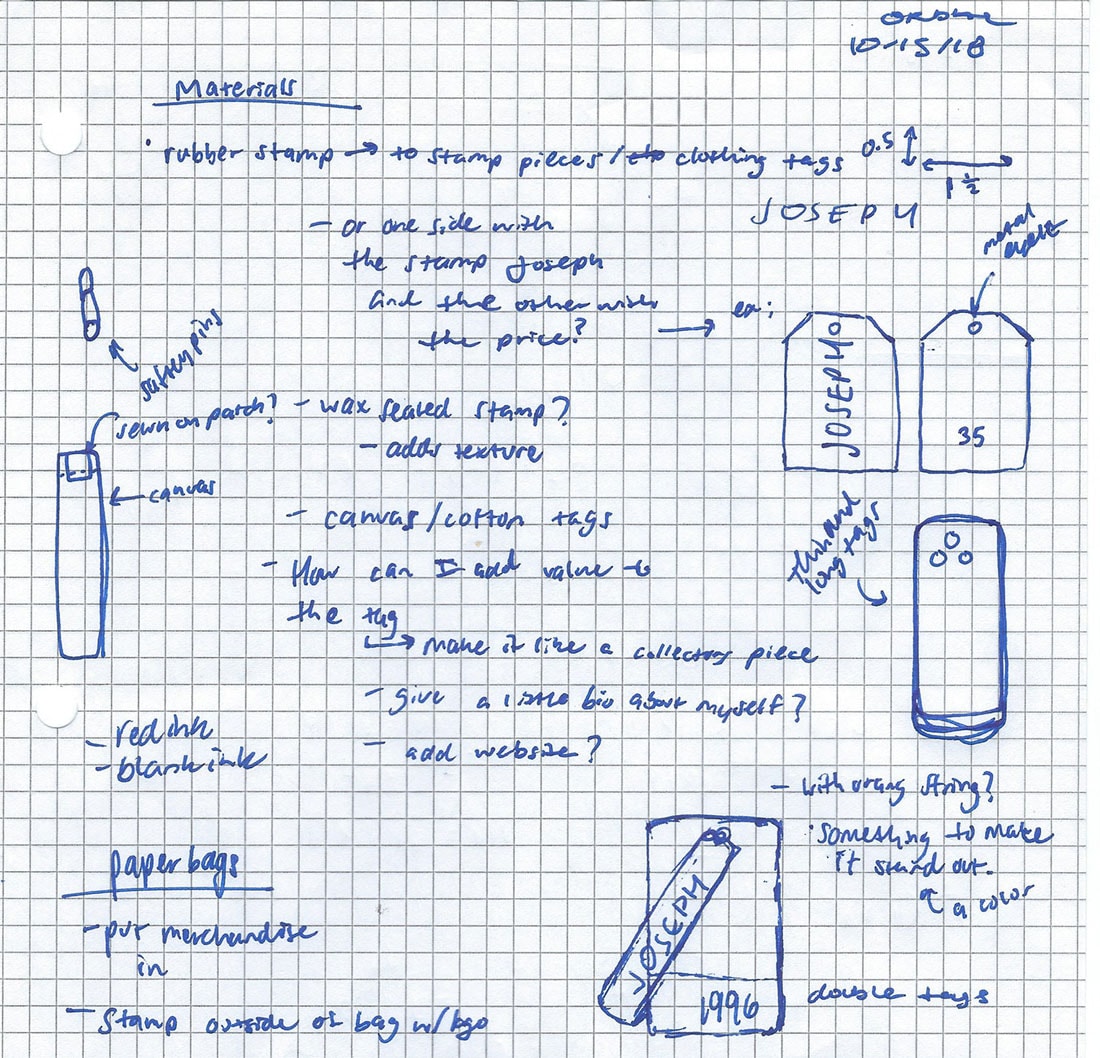
As a designer, it might make the most sense to visualize your marketing plan, rather than write it down.
Sketch it out. Hang it on the wall next to your desk. Create something that you can create from to make it the most useful and valuable for you.
All of the design elements you create and distribute are part of your marketing plan. And as a designer, aesthetics matter.
Develop Actionable Tactics

Turn your goals into actionable tactics. How will you actually market and promote yourself and your personal brand?
Think about the following common tactics as a personal marketing plan primer for designers:
- Portfolio website with projects and contact information
- Social media channel – post projects and work to – that you actually use
- Printed elements such as business cards or a brochure
- Personal style and communication when you meet clients or engage in networking
- Speaking engagements or conference talks or whitepapers
- Guest blogging, online tutorials, or podcast “appearances”
- Advertising or paid promotion
You may use some or all of these tactics as part of your personal marketing plan. Don’t force an idea into your plan just because it sounds interesting; remember to connect each tactic to a goal. You’ll find more success and have a better plan for what you realistically can and can’t do.
Design and Share Content
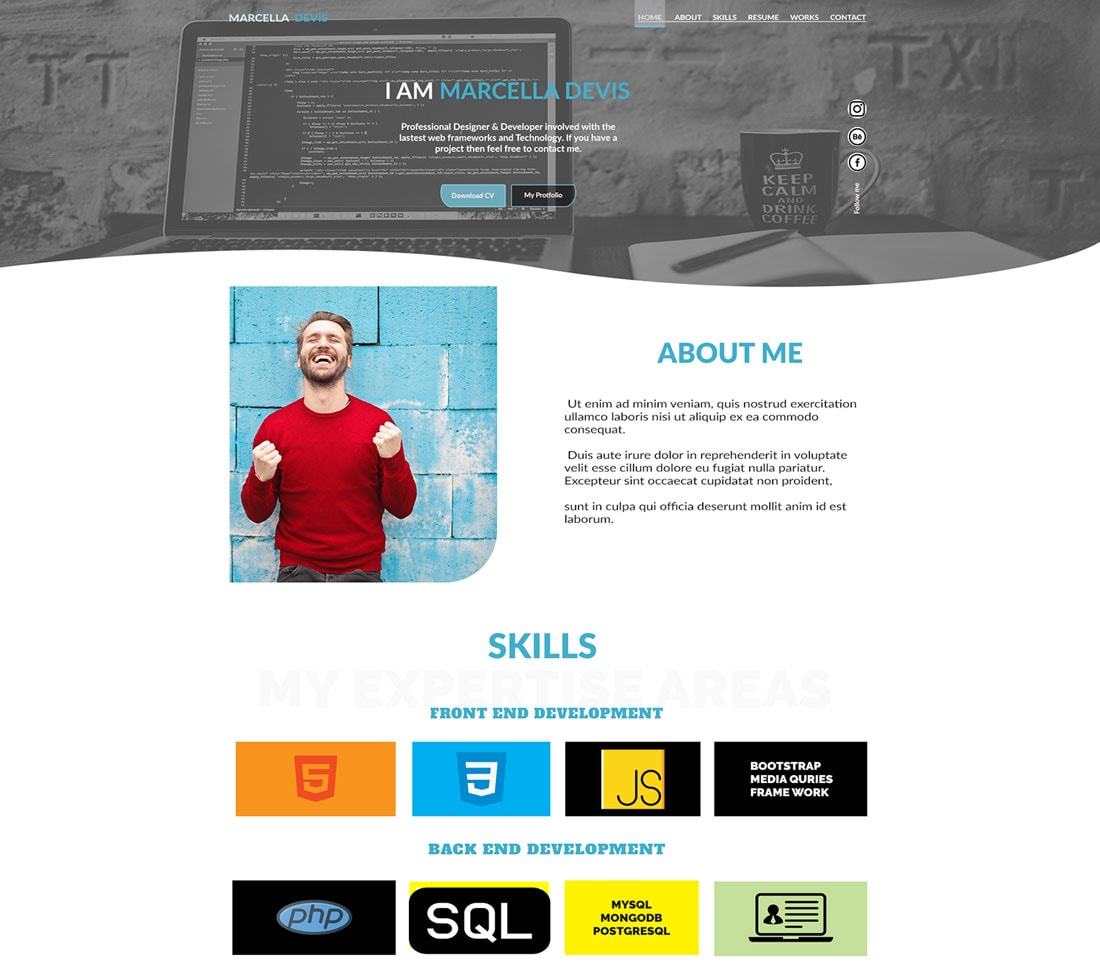
Now it’s time to put your plan in action. Create a timeline or calendar to share content you are creating as part of your personal marketing plan.
Think of content as anything that’s part of one of the tactics above. (Even placing the order to get business cards printed is part of your content-sharing plan.)
When you are designing as part of the marketing plan, consider how all of the elements in the plan work together. They should have a consistent visual aesthetic but also create a unified vibe that extends to personal appearances as well. (The more you attend conferences and networking events, the more important this becomes. You want people to associate the online you with the physical one, creating consistent personal brand and marketing.)
Try to maintain somewhat of a regular schedule for distribution of branded content. The right mix feels organic and unforced but isn’t sporadic and random.
Evaluate and Review

A personal marketing plan will change over time. You’ll find that some of your goals may not be relevant anymore and it’s time to set new ones. You might change life or career stages and need to refocus your mission.
Build a time into the plan to evaluate where you are with goals every three to six months, with a full review annually. Take inventory of what’s working and what’s not so you can continue to evolve your marketing plan moving forward.
It’s just as important to consider goals that you meet as ones you do not. Don’t be discouraged by setbacks or unmet goals; they can present great learning opportunities that help shape your marketing efforts going forward.
When it comes down to it, a personal marketing plan isn’t all that different from marketing plans that’s you’ve probably seen for your company or another brand. The key element is that it is personal and probably a much more streamlined marketing tool.
What’s great about going through the process of creating a personal marketing plan is that it will help you focus and target your efforts, which can save a lot of time in the long run. (And we could all use a little more time for creative projects.) If you are looking to promote your work, change jobs, or even just get more involved in the design community, working from a marketing plan can help.

The Complete Guide to Building a Personal Marketing Plan
McDonald’s, Pepsi, Netflix, and You.
What’s the common thread?
You’re all brands.
Yes, you read that right. Even if you don’t think of yourself that way—
You are a brand . Here’s why:
- You’re selling something (but not in the way you think).
- You make an impression on people.
- You need fans.
- You stand for something.
Because you’re a brand, it’s important you know how to market yourself.
The major brands you know and love have carefully detailed marketing plans they use to get more customers and develop brand awareness.
In a moment, I’ll show you exactly how you can create your own unique personal marketing plan to increase your chances of success in your career.
But first, I want to clarify this whole “you are a brand” thing.
Need help building your personal brand? Click here to get a copy of our ultimate guide that reveals secrets we’ve used to grow the brands of New York Times Bestsellers.
What is a personal brand.
Okay, there’s something I didn’t tell you…
You ARE a brand, just like McDonald’s, Pepsi, and Netflix, but you’re a different kind of brand.
You’re a personal brand.
Your personal brand is essentially the outward appearance you show to the world. It’s what you bring to the table. It’s the value you can give to others.
Think of people like Tony Robbins or Oprah Winfrey.
These people are MASSIVE personal brands . They provide a TON of value to people’s lives and they have built a business around their personalities.
But you might be wondering:
What’s the difference between a personal brand and the person themselves?
Think about it like this:
Tony Robbins probably doesn’t act the same way at home as he does on-stage.
“On-Stage Tony Robbins” is a personal brand.
“At-Home Tony Robbins” is a person.
Your personal brand is the image you consciously (or unconsciously) project to get your name and message into the world.
Who you are as a person is just that. It’s the person you are when no one is looking.
Both are you — they just have different goals.
Qualifications of a Brand
Let’s break this down even a bit further.
When I say “you are a brand,” what does that even mean?
It’s possible you may have never thought of yourself in this way before, but if you want to achieve the next level of success in your career, it’s important to be aware of this.
I say “you are a brand” because you meet these four qualifications, whether you realize it or not:
Let’s break that down.
1. You’re selling something (but not in the way you think).
Applying for a job…
Going on a first date…
Negotiating a lower price at the car dealership…
Even just walking down the street…
You’re selling something.
Not a physical product, obviously, but an idea.
When you’re applying for that job — you’re selling the company on your ability to perform the job well and work effectively with the team.
When you’re on a first date — you’re selling the idea that you’re an attractive, desirable partner.
When you’re negotiating for a lower price at a car dealership — you’re selling the idea that you deserve a lower price than the one advertised.
And even when you’re walking down the street — you’re selling the idea that you’re a normal, productive member of society…not someone who deserves to be tackled by the police and put in handcuffs.
In fact, your success in your career, or even your life, can depend on your ability to sell these things—
Much like a brand’s success depends on its ability to sell its products or services .
2. You make an impression on people.
Let’s get one thing straight:
Most people are not paying attention to you.
They’re too busy paying attention to themselves.
But sometimes, people do pay attention to you, whether it’s because you voiced your opinion at a meeting, or because you’re interviewing for a new job—
Whatever the cause, when people pay attention to you, you make an impression on them.
They’re (often unconsciously) making a decision about the type of person you are.
In other words:
They’re using your outward projection of yourself to determine if they’re going to “buy what you’re selling,” figuratively or literally.
3. You need fans.
People like to say “it’s not what you know, it’s who you know.”
I’d change that to:
“It’s not who you know, it’s who likes you.”
The truth is—
It doesn’t matter if you know every person in the world, if you’re a jerk to them — or if they don’t like you — they’re not going to help you out.
Does this mean you should turn into a people-pleasing maniac?
Absolutely not.
Not everyone is going to like you. Not everyone likes me. And that’s okay. It’s a fact of life.
So, instead of trying to project a false outward appearance to get people to like you, your mission is instead to be authentic and honest.
Think about it:
The brands we appreciate most are those who are able to be honest. Those who are able to admit their mistakes. And those who are able to show us there are humans behind that big, bold logo of theirs.
The best salesmanship is born of authenticity and a sincere, honest-to-God belief in what you’re selling.
So, yes, as a personal brand, you do need fans. But you get them by being confident in your identity.
4. You stand for something.
Speaking of identity, this is an important point:
A good brand stands for something — even if it means losing fans.
A present-day example of this is Nike’s decision to feature Colin Kaepernick in their ads .
Your personal brand is strengthened by those things that cause you to plant your flag in the ground and stand strong —
Even when everything is on the line.
How to Develop An Effective Personal Marketing Plan

So, since you are indeed a brand —
It would be smart to learn how to market yourself as effectively as possible to increase your chances at success.
So, here’s how you can create your own unique personal marketing plan to do just that.
1. Define your goal.
What do you want?
No, really. What is it you’re going after right now?
Is it a new job, a raise, a speaking gig?
It’s important you know exactly where you’re trying to go before you start down the path.
When you’re defining your goal, consider these things:
Why do you want this new job, this raise, or this speaking gig?
Change is hardly ever easy, and developing and working through a personal marketing plan might sound fun in theory — but it’s hard, uncomfortable work, especially if you’ve never done it before.
So, before you start, write down exactly why you want to do this, and what you’ll do to stay disciplined when it gets hard or uncomfortable.
Based on your goal — what’s a realistic timeline for achieving it? If you’re angling for a new job in a new industry — you might be able to accomplish that in a few months or a year’s time. But if you want to build an entire business around your own personal brand , give yourself plenty of runway.
2. Discover Your USP.
Remember that time McDonald’s started selling gourmet pasta?
Right. Me neither.
McDonald’s wouldn’t do that — because it’s not who they are.
Their goal isn’t to give you the best pasta you’ve ever had or the healthiest meal you’ve ever eaten.
Instead, their goal is to give you consistent quality and quick service with an affordable price tag at convenient locations.
And they’ve built a $100-billion-dollar business on it.
That means if you want to build a successful brand — you must know who you are…and who you are NOT.
You have to do the soul searching.
You have to identify your USP —
Your unique selling proposition.
This is the thing that makes you different from everyone else going after the same goal as you.
Many major brands have multiple USPs. But for now, focus on finding your one single USP and highlighting it whenever possible.
You can add others later if necessary. One should be plenty for now, though. If you try to highlight too many USPs, you’ll dilute your brand.
Here’s what I mean:
If you have too many USPs, you’re like a buffet.
No one goes to a buffet when they want to have a great steak, or great pasta, or great anything, for that matter.
A buffet caters to everyone.
Your brand should not.
Instead, your brand should cater to a very specific audience with a very specific problem that you can solve.
You want to be more like a gourmet steakhouse known for its filet mignon—
Not a buffet where you can get spaghetti and tacos in the same meal.
Here are some examples of USPs from personal brands:
(Keep in mind — these brands have multiple USPs, but these are some of their biggest ones.)
Jerry Jenkins has written 21 New York Times bestsellers. It’s hard to beat that kind of credibility.
Ramit Sethi is not afraid to give financial advice that goes against-the-grain of what’s typical.
Gary Vaynerchuk is going to give you blunt, straightforward motivation to take action and work toward your dreams.
So, what makes you unique? How do you want to differentiate yourself from everyone out there going after the same goal as you?
For example:
If your goal is to get a new job—
What makes you different from all the other applicants?
It’s okay if you don’t identify anything immediately, but sit with it. Think on it.
And if nothing comes—
What can you do to differentiate yourself from all the other applicants?
Maybe it’s creating a “shock-and-awe” package and sending it to the hiring manager…
Maybe it’s doing a creative project on your own, free of charge, that showcases the skills needed for the job position…
Whatever you choose — make sure there’s something that makes you different from everyone else out there.
3. Define Your Audience.
Who should care about what you’re saying?
This is easily overlooked, because we often think we know.
If your goal is to get a new job, our audience is the people in charge of hiring at our target companies.
And that’s a great start, but you can get a lot further by digging deeper.
Who are those managers? What do they do in their spare time? Who have they hired so far?
What kind of TV shows do they watch? What books do they read? Who do they follow on social media?
What problem can you solve for them?
Your success in marketing yourself is determined by whether or not your message resonates with your audience.
So, the more you know about them, the better able you will be to craft an effective message.
If you’re vying for a new job at a fun, exciting company, you are still solving a problem for your audience.
Management at the company wants to hire skilled, likeable, qualified employees who are easy to work with.
Those people are harder to find than you might think.
So, if you meet those qualifications and can effectively communicate that, you are indeed solving a problem for management.
Effectively marketing yourself just means you have identified how you can solve a problem for other people and clearly communicating that to them.
4. Identify Your Plan of Attack.
At this point, you know your goal, you know what makes you unique, and you know your audience—
Now it’s time to make your move.
How can you get in contact with your audience?
Where do they hang out?
If you’re building a speaking business, this might include reaching out to local organizations that could benefit from hearing your message.
If you’re applying for a job, it might mean reaching out directly to the person in charge of hiring. Or it might mean publishing content on LinkedIn regularly to demonstrate your expertise.
Your goal here is three-fold:
First , find out where your audience is.
Second , determine how you can communicate with that audience. Is it social media? Email ? YouTube videos?
There’s no right or wrong answer, but your goal is to meet your audience where they’re at.
So, if your audience is hiring managers who spend a lot of time on LinkedIn —
Focus your efforts on LinkedIn, not Instagram.
Third , communicate with that audience regularly.
Disclaimer: This might be discouraging at first.
When you start communicating with your audience, whether it’s through cold emails , LinkedIn content, or YouTube videos—
People probably won’t pay attention at first.
This is where perseverance is key.
Anyone can write one blog post or create one video.
But not anyone can do that month-after-month, year-after-year.
Obviously, your ultimate goal (getting a job, building a business, etc.) will determine the frequency and long-term time commitment to publishing content, but focus on consistency.
You’ve identified who you can help. Now it’s time to show them you can actually provide that help.
Get specific. What type of content will you create, if any?
If you’re trying to get a new job, your marketing plan might consist of making contacts through networking events or reaching out through LinkedIn.
But if you’re trying to build a speaking business, you may benefit more from consistently writing blog posts or publishing YouTube videos .
Beyond that — how often will you communicate with your audience?
Will you go to three networking events per week?
Write 4 blog posts per month?
Get crystal clear here. This is the framework that will turn your marketing plan into action.
5. Get Help Early and Often.
Whatever you want to accomplish, odds are someone has done it already.
Find out who those people are.
If your goal is to get hired at a specific company, see if you can get in touch with some current employees there.
What is the company looking for? How can you provide the most value to the company?
Or — if you’re looking to build a business around your personal brand , your path might be a little longer.
Find someone who has done what you want to do. See if they’d be willing to coach you or help you reach your goal.
Success generally doesn’t happen in a vacuum. That means you’ll need to surround yourself with the right people to get the results you want.
6. Re-Evaluate Regularly.
The marketing plan you create today might not make sense in 6 months or a year.
When you create your plan, be realistic about how long it will carry you.
You want to get into the “Goldilocks Zone” here.
Meaning, avoid creating a plan that you can only follow for a month.
But don’t doggedly stick with a plan to publish content on LinkedIn if you find out your audience actually spends more time on YouTube.
Beyond that, if you find yourself wanting to adjust your plan, be honest about your reasons.
Boredom, lack of motivation, or “it’s too hard” are generally not legitimate reasons to alter course.
Even lack of results isn’t a reason to alter your course when starting out.
Remember, anyone can write one blog post or create one video.
Pick your lane and stay in it until you run out of road.
And when you do run out of road, pick a different lane, and get going again.
Personal Marketing Plan Example
So, now that we’ve covered the “big picture” of developing a personal marketing plan, you may be wondering —
“What does an actual personal marketing plan look like?”
Here’s a quick example of a personal marketing plan that incorporates all the elements we’ve discussed so far.
This personal marketing plan example is for a fictional character named Jack Brown.
Jack is happy with his current job, but his ultimate goal is to become a professional speaker .
Jack’s Marketing Plan
Replace my current income with income from speaking engagements.
Timeline: Within the next 5 years.
Motivation: I’ve learned a lot over the course of my career, and I’ve been told that I have a great personality for the stage. I just want a platform to help people create better lives.
Middle-aged men who are generally satisfied with their jobs, but feel they’ve lost the fire they once had.
Men who know something is missing in their lives, but aren’t sure what that “something” is.
They want a path to a happier, more fulfilling life, but they’ve been stuck in their routines for so long, they’re scared to venture outside their comfort zone.
They generally work white-collar jobs and play golf or go cycling most weekends.
I have been in these men’s shoes. I know what it’s like to be in their position. I changed my own life for the better and was able to reclaim happiness and fulfillment.
Since I have the same experience as them, I know the exact steps they can take to build better lives for themselves.
Where is my audience?
Locally, they are on golf courses. They’re members of cycling clubs. And they’re probably in the corner office with a view — or close to it.
Online, they’re on LinkedIn.
How can I communicate with them?
I know a few members of my target audience personally, so I could go golfing with them one day.
But if I want to reach the most people possible, LinkedIn is the way to do it.
So, I’ll block off Saturday mornings to run my ideas past the people I know personally, and I’ll use their feedback to determine what sort of content I should create.
I’m a decent writer, so I think publishing content regularly on LinkedIn will be most effective for me.
How frequently can I communicate with them?
Work has been busy lately, so for the next month, I can only write about one 1,000-word post per week.
I’ll write posts throughout the week and publish them by 9:00AM every Friday.
But things will lighten up during the summer, so I’ll plan to write three posts per week for the months of June through September.
I’ll publish them on Mondays, Wednesdays, and Fridays at 9:00AM.
If I want to become a professional speaker, I need to understand my audience.
Focusing on these blog posts for now will help me determine which messages resonate with my audience. And it will help me build a backlog of content I could use for speeches eventually.
People Who Can Help Me
I know a few people who have done something like this before, so I want to grab coffee with them to hear how they did it, and see if they’d be interested in helping me.
Those people are:
For the next six weeks, I’ll try to meet with one of them per week, at least.
Beyond that, I know there are some Facebook Groups for people who want to become professional speakers, so I’ll find a few of those and join them by next Friday.
I also know there’s a local Toastmasters group that might be able to help me improve my speaking skills, so I’ll look at their schedule today and attend my first meeting next week.
Re-Evaluation Date
This current plan should carry me at least for the next 4 months, but around that time, I think I’ll need to start trying to book some local speaking engagements.
I’ll re-evaluate this plan on September 31.
Personal Marketing Plan Template
As you can see from Jack’s example above, creating a personal marketing plan doesn’t have to be complicated.
It’s essentially a framework to point your personal marketing efforts in the right direction.
But your plan should be as specific as possible.
If there are people you want to reach out to, include their contact information in your plan as well as the date and time you will contact them.
If you plan to create content regularly, determine the time and day of the week you will publish that content.
Whatever the goal, be crystal clear in how you will accomplish it.
You can use the personal marketing template below to create your own personal marketing plan.
The goal you hope to achieve through your personal marketing plan (getting a new job, building a personal brand, etc.).
Timeline: Your expected timeline for this phase of your marketing plan.
Motivation: Your motivation for pursuing this goal.
The group of people who should care about what you have to say.
Don’t forget to dig deep here to find out what your audience is really like.
What makes you different than everyone else trying to achieve your same goal?
Where can you find members of your audience (both in-person and online)?
What’s the best way for you to get in contact with your audience?
Realistically, how often can you create content or get in touch with your audience?
What is the purpose of this strategy? Why is it the best path for you right now?
Who has already accomplished what you want to accomplish?
How will you get in contact with them?
What’s their contact information?
How long will your current plan carry you? When will you re-evaluate it?
Creating Your Personal Marketing Plan
Just like McDonald’s, Pepsi, and Netflix—
You are a brand.
Creating your very own marketing plan gives you the opportunity to increase your brand’s chances at success .
Use the strategies and templates in this guide to create your own personal marketing plan.
And comment below to let us know how it goes!
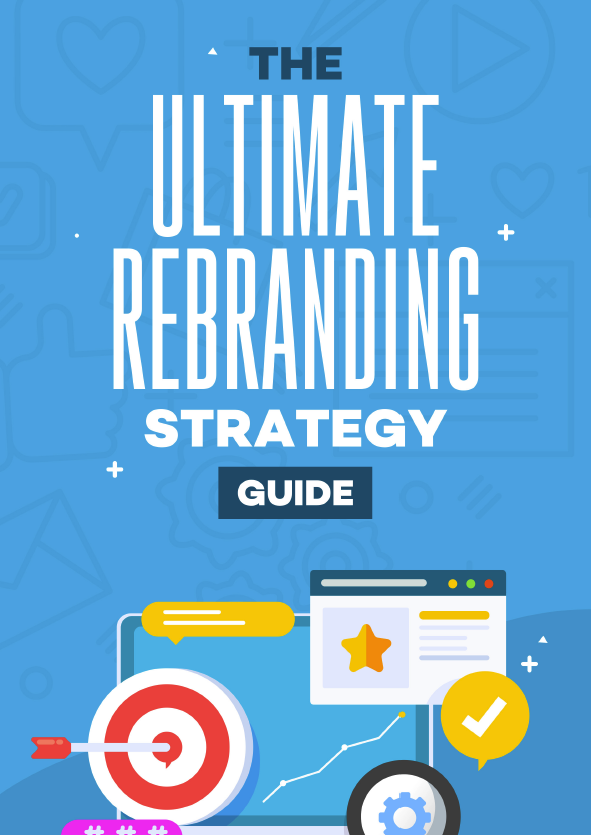
Wait! Before you go...
Be sure to grab a FREE copy of our ultimate rebranding strategy guide.
Just tell us where to send it:

Enter your first name and email below to get your PDF copy of The Ultimate Guide to Growing Your Personal Brand.
What is a Marketing Plan & How to Write One [+ Examples]
Published: August 07, 2024
One of my favorite ways to break through writer’s block, whether the assignment is a marketing plan or a short story, is simply reading more examples. (I also recommend taking a long walk; you’d be surprised.)

I can’t take you on a walk, but I can give you some examples, some inspiration, and some guidelines to get your creativity humming.
If you don’t know where to start, we’ve curated lists of marketing plans and marketing strategies to help you write a concrete plan that will produce results.
Let’s start by understanding the differences between the two.
Featured Resource: Free Marketing Plan Template

Looking to develop a marketing plan for your business? Click here to download HubSpot's free Marketing Plan Template to get started .
Table of Contents
Marketing Strategy Examples
What is a marketing plan, marketing plan vs. business plan, how to write a marketing plan, types of marketing plans, marketing plan examples, marketing plan faqs, sample marketing plan.

Free Marketing Plan Template
Outline your company's marketing strategy in one simple, coherent plan.
- Pre-Sectioned Template
- Completely Customizable
- Example Prompts
- Professionally Designed
Download Free
All fields are required.
You're all set!
Click this link to access this resource at any time.
A marketing plan is a strategic road map that businesses use to organize, execute, and track their marketing strategy over a given period. Marketing plans can include different marketing strategies for various marketing teams across the company, all working toward the same business goals.
The purpose of a marketing plan is to write down strategies in an organized manner. This will help keep you on track and measure the success of your campaigns.
Your marketing plan lays out each campaign‘s mission, buyer personas, budget, tactics, and deliverables. With all this information in one place, you’ll have an easier time staying on track with a campaign, and you can figure out what works and what doesn’t.
To learn more about creating your marketing plan, keep reading or jump to the relevant section:

A marketing plan is a strategic document that outlines marketing objectives, strategies, and tactics.
A business plan is also a strategic document. But this plan covers all aspects of a company's operations, including finance, operations, and more. It can also help your business decide how to distribute resources and make decisions as your business grows.
A marketing plan is a subset of a business plan; it shows how marketing strategies and objectives can support overall business goals. And if you need an assist executing a marketing plan, might I recommend HubSpot’s marketing hub ?
Marketing Strategy vs. Marketing Plan
A marketing strategy is the part of your marketing plan that describes how a business will accomplish a particular goal or mission.
This includes which campaigns, content, channels, and marketing software you’ll use to execute that mission and track its success.
A marketing plan contains one or more marketing strategies. It's the framework from which all your marketing strategies are created, and it helps you connect each strategy to a larger marketing operation and business goal.
For example, suppose your company is launching a new software product, and it wants customers to sign up. The marketing department needs to develop a marketing plan that'll help introduce this product to the industry and drive the desired sign-ups.
The department decides to launch a topical blog, debut a YouTube series to establish expertise, and create new X and Instagram accounts to join the conversation around this subject. All this serves to attract an audience and convert this audience into software users.
To summarize, a business' marketing plan is dedicated to introducing a new software product to the marketplace and driving sign-ups for that product. The business will execute that plan with three marketing strategies : a new industry blog, a YouTube video series, and an X account.
Of course, the business might consider these three things as one giant marketing strategy, each with its own specific content strategies. How granular you want your marketing plan to get is up to you. Nonetheless, every marketing plan goes through a particular set of steps in its creation.
- State your business' mission.
- Determine the KPIs for this mission.
- Identify your buyer personas.
- Describe your content initiatives and strategies.
- Clearly define your plan's omissions.
- Define your marketing budget.
- Identify your competition.
- Outline your plan's contributors and their responsibilities.
1. State your business' mission.
Your first step in writing a marketing plan is to state your mission. Although this mission is specific to your marketing department, it should serve as your business' main mission statement.
In my experience, you want to be specific, but not too specific. You have plenty of space left in this marketing plan to elaborate on how you'll acquire new customers and accomplish this mission.
For those of you running startups or small businesses, HubSpot’s starter bundle is a great all-in-one solution — it can help you find and win customers, execute content marketing plans, and more.
If your business' mission is “to make booking travel a delightful experience,” your marketing mission might be “to attract an audience of travelers, educate them on the tourism industry, and convert them into users of our bookings platform.”
Need help building your mission statement? Download this guide for examples and templates and write the ideal mission statement.
2. Determine the KPIs for this mission.
Every good marketing plan describes how the department will track its mission‘s progress. To do so, you need to decide on your key performance indicators (KPIs) .
KPIs are individual metrics that measure the various elements of a marketing campaign. These units help you establish short-term goals within your mission and communicate your progress to business leaders.
Let's take our example of a marketing mission from the above step. If part of our mission is “to attract an audience of travelers,” we might track website visits using organic page views. In this case, “organic page views” is one KPI, and we can see our number of page views grow over time.
Also, make sure to check whether your current reporting software facilitates the KPIs you need. Some reporting tools can only measure a set of pre-defined metrics, which can cause massive headaches in particular marketing campaigns.
However, other tools, like HubSpot’s analytics software , can offer full flexibility over the KPIs you wish to track.
You can generate custom reports that reveal average website engagement rates, page visits, email, social media traffic, and more.
These KPIs will come into the conversation again in step 4.
3. Identify your buyer personas.
A buyer persona is a description of who you want to attract. This can include age, sex, location, family size, and job title.
Each buyer persona should directly reflect your business' current and potential customers. All business leaders must agree on your buyer personas.
4. Describe your content initiatives and strategies.
Here‘s where you’ll include the main points of your marketing and content strategy.
Because there‘s a laundry list of content types and channels available today, you must choose wisely and explain how you’ll use your content and channels in this section of your marketing plan.
When I write this section, I like to stipulate:
- What types of content I'll create. These might include blog posts, YouTube videos, infographics, and ebooks.
- How much I'll create. I typically describe content volume in daily, weekly, monthly, or even quarterly intervals. It all depends on my workflow and the short-term goals for my content.
- The goals (and KPIs) I'll use to track each type. KPIs can include organic traffic, social media traffic, email traffic, and referral traffic. Your goals should also include which pages you want to drive that traffic to, such as product pages, blog pages, or landing pages.
- The channels on which I'll distribute my content. Popular channels include Facebook, X, LinkedIn, YouTube, Pinterest, and Instagram.
- Any paid advertising that will take place on these channels.
5. Clearly define your plan's omissions.
A marketing plan explains the marketing team's focus. It also explains what the marketing team will not focus on.
If there are other aspects of your business that you aren‘t serving in this particular plan, include them in this section. These omissions help to justify your mission, buyer personas, KPIs, and content.
You can’t please everyone in a single marketing campaign, and if your team isn’t on the hook for something, you need to make it known.
In my experience, this section is particularly important for stakeholders to help them understand why certain decisions were made.
6. Define your marketing budget.
Whether it's freelance fees, sponsorships, or a new full-time marketing hire, use these costs to develop a marketing budget and outline each expense in this section of your marketing plan.
You can establish your marketing budget with these 8 free marketing budget templates .
7. Identify your competition.
Part of marketing is knowing your competition. Research the key players in your industry and consider profiling each one.
Keep in mind that not every competitor will pose the same challenges to your business. For example, while one competitor might rank highly on search engines for keywords that you’re also chasing, another competitor might have a heavy footprint on a social network where you plan to launch an account.
Easily track and analyze your competitors with this collection of 10 free competitive analysis templates .
8. Outline your plan's contributors and their responsibilities.
With your marketing plan fully fleshed out, it‘s time to explain who’s doing what.
I don’t like to delve too deeply into my employees’ day-to-day projects, but I know which teams and team leaders are in charge of specific content types, channels, KPIs, and more.
Now that you know why you need to build an effective marketing plan, it’s time to get to work.
Starting a plan from scratch can be overwhelming if you haven't done it before.
That’s why there are many helpful resources that can support your first steps. We’ll share some of the best guides and templates to help you build effective results-driven plans for your marketing strategies.
Ready to make your own marketing plan? Get started with this free template.
The kind of marketing plan you create will depend on your company, your industry, and your business goals. We compiled different samples to suit your needs:
1. Quarterly or Annual Marketing Plans

This marketing plan by Visit Oxnard, a convention and visitors bureau, is packed with information: target markets, key performance indicators, selling points, personas, marketing tactics by channel, and much more.
It also articulates the organization’s strategic plans for the upcoming fiscal year, especially as it grapples with the aftereffects of the pandemic.
Lastly, it has impeccable visual appeal, with color-coded sections and strong branding elements.
- It states clear and actionable goals for the coming year.
- It includes data and other research that shows how the team made its decisions.
- It outlines how the team will measure the plan’s success.
4. Safe Haven Family Shelter

This marketing plan by a nonprofit organization is an excellent example to follow if your plan will be presented to internal stakeholders at all levels of your organization.
It includes SMART marketing goals , deadlines, action steps, long-term objectives, target audiences, core marketing messages , and metrics.
The plan is detailed yet scannable. By the end of it, one can walk away with a strong understanding of the organization’s strategic direction for its upcoming marketing efforts.
- It confirms ongoing marketing strategies and objectives while introducing new initiatives.
- It uses colors, fonts, and formatting to emphasize key parts.
- It closes with long-term goals, key themes, and other overarching topics to set the stage for the future.
5. Wright County Economic Development

- “Going viral” isn’t a goal; it’s an outcome.
- Be surprising. Subvert expectations.
- Be weird and niche if you want to be weird and niche, but establishing a shared cultural understanding might result in a bigger audience.
Pridemore Properties’ Instagram smash hit is unexpected, to say the least. You think you’re getting a home tour that takes your figurative breath away; you get a home tour that takes the agent’s literal breath away.

Verizon’s toe-tapping, hip-shaking Totalmente (aka Total by Verizon, a contractless phone plan) ad debuted during Univision’s Spanish-language broadcast of Super Bowl LVIII. The ad reinvents the 1998 Elvis Crespo song “Suavemente,” an earworm if I’ve ever heard one, replacing the lyrics with Total by Verizon features.
Verizon Value’s CMO and VP of Marketing, Cheryl Gresham, has admitted that she didn’t know much about marketing to a majority-Latinx audience.
In an interview with Campaign Live , she said she didn’t think the idea would have gotten off the ground “if it had just been me and a lot of other people that had a background like myself in that room.”
CampaignLive wrote, “Gresham says the team opted for a creative concept that spoke to all the Latinos in the room — despite Gresham herself not understanding the connection.”
Gresham’s marketing strategy hinged on knowing her audience and, just as importantly, trusting her fellow marketers who knew how to reach that audience.
Strategic Takeaways for Demographic Marketing
- Know what you don’t know.
- Foster diversity in marketing leadership and staff.
- Know your audience.
The catchy tune and the great storytelling certainly don’t hurt.
But more than that, Ogilvy and Verizon dug deep into Latinx culture — more than 25 years deep — to craft an ad that doesn’t feel like it’s just responding to the latest trend. They also tapped Venezuelan American comedian, musician, and producer Fred Armisen to direct the spot.
6. Chappell Roan

The Ultimate Guide to Marketing Strategies & How to Improve Your Digital Presence
![personal marketing plan presentation 5 Steps to Create an Outstanding Marketing Plan [Free Templates]](https://www.hubspot.com/hubfs/marketingplan_20.webp)
5 Steps to Create an Outstanding Marketing Plan [Free Templates]
![personal marketing plan presentation 4 Clever Olympics Marketing Campaigns [+Top Takeaways]](https://knowledge.hubspot.com/hubfs/best-olympic-marketing-campaigns-1-20240809-9542066.webp)
4 Clever Olympics Marketing Campaigns [+Top Takeaways]
![personal marketing plan presentation 6 Steps to Create an Outstanding Marketing Plan [Free Templates]](https://www.hubspot.com/hubfs/marketingplan_20.webp)
6 Steps to Create an Outstanding Marketing Plan [Free Templates]

50 Small Business Marketing Ideas for 2024

The 2024 State of Marketing & Trends Report: Data from 1400+ Global Marketers

Mastering Social Media for Nonprofit Promotion: Insights and New Data from Experts

The AIDA Model: A Proven Framework for Converting Strangers Into Customers

Demystifying Marketing's 6 Biggest Mixed Messages of 2024 with Jasper's Head of Enterprise Marketing

9 Pivotal Marketing Trends to Watch in 2024, According to Experts
Marketing software that helps you drive revenue, save time and resources, and measure and optimize your investments — all on one easy-to-use platform

- Join the AMA
- Find learning by topic
- Free learning resources for members
- Credentialed Learning
- Training for teams
- Why learn with the AMA?
- Marketing News
- Academic Journals
- Guides & eBooks
- Marketing Job Board
- Academic Job Board
- AMA Foundation
- Diversity, Equity and Inclusion
- Collegiate Resources
- Awards and Scholarships
- Sponsorship Opportunities
- Strategic Partnerships
We noticed that you are using Internet Explorer 11 or older that is not support any longer. Please consider using an alternative such as Microsoft Edge, Chrome, or Firefox.
Marketing Plan Presentation
A marketing plan presentation template consisting of seven stages.
- Estimated time required: 10 hours
- Skills required: Marketing planning
Get Full Access to This Resource With AMA Membership

Marketing Communications Playbook
This tool can be used alone, but it’s also part of the comprehensive Marketing Communications Playbook. It provides step-by-step planning guidance while also helping you utilize more than 30 downloadable tools from the popular AMA Marketer’s Toolkit library.
This tool is powered by Demand Metric .
By continuing to use this site, you accept the use of cookies, pixels and other technology that allows us to understand our users better and offer you tailored content. You can learn more about our privacy policy here
Got any suggestions?
We want to hear from you! Send us a message and help improve Slidesgo
Top searches
Trending searches

17 templates

american history
85 templates

49 templates

43 templates

el salvador
34 templates

art portfolio
100 templates
Marketing Mix MK Plan
It seems that you like this template, marketing mix mk plan presentation, free google slides theme, powerpoint template, and canva presentation template.
Are you considering implementing the marketing mix strategy for your business? If so, you may be wondering how to effectively communicate your ideas to your team. Luckily, there's a modern and eye-catching template that can help. This colorful design features abstract elements set against a dark background, making it impossible for anyone to ignore. By utilizing this template for your next marketing plan, you can present your vision with confidence and clarity.
Features of this template
- 100% editable and easy to modify
- 20 different slides to impress your audience
- Available in different colors
- Contains easy-to-edit graphics such as graphs, maps, tables, timelines and mockups
- Includes 500+ icons and Flaticon’s extension for customizing your slides
- Designed to be used in Google Slides, Canva, and Microsoft PowerPoint
- 16:9 widescreen format suitable for all types of screens
- Includes information about fonts, colors, and credits of the resources used
How can I use the template?
Am I free to use the templates?
How to attribute?
Combines with:
This template can be combined with this other one to create the perfect presentation:

Attribution required If you are a free user, you must attribute Slidesgo by keeping the slide where the credits appear. How to attribute?
Available colors.
Original Color

Register for free and start downloading now
Related posts on our blog.

How to Add, Duplicate, Move, Delete or Hide Slides in Google Slides

How to Change Layouts in PowerPoint

How to Change the Slide Size in Google Slides
Related presentations.

Premium template
Unlock this template and gain unlimited access


IMAGES
VIDEO
COMMENTS
Download the Dark MK Plan Minitheme presentation for PowerPoint or Google Slides and take your marketing projects to the next level. This template is the perfect ally for your advertising strategies, launch campaigns or report presentations. Customize your content with ease, highlight your ideas and captivate your audience with a...
Types of marketing plan. The Anatomy of an Effective Marketing Plan. Step 1 - Defining business goals. Step 2 - KPI (Key Performance Indicators) Step 3 - Building a market analysis. Step 4 - Defining the target market. Step 5 - Defining marketing objectives. Step 6 - Building marketing strategies.
In short, making your marketing plan in PowerPoint gives you the opportunity to convey your message in a more visually appealing way. It doesn't only make your audience more likely to pay attention to your presentations. PowerPoint can also make the message you're trying to get across more digestible and memorable.
The marketing plan PowerPoint templates can enhance your presentations by providing a visually appealing and professional design that aligns with marketing concepts. It includes pre-designed slides for market analysis, strategies, and goals, allowing you to effectively communicate your marketing plan to your audience.
Personal Marketing Plan Template. Create your Marketing Plan with this easy-to-edit template. Edit and Download. ... This marketing plan presentation template is a great way to share your marketing goals, SWOT, strategy, timeline, deliverables and more with your team and the management.
Marketing Plan Presentation Templates. A marketing plan presentation template is an easy way to organize your efforts. There are different factors that will determine which templates are optimal for you. This will largely depend on your industry, audience, and target market. However, there are some general elements every marketing plan template ...
Go To Download. 3. Free Virtual Campaign Presentation Template. Designed to look kawaii and colorful, this marketing presentation template has sections about your company, content plan, market analysis, budget, or KPI overview. A creative design that looks like browser windows. 100% editable and easy to modify.
This PowerPoint template offers this in the form of a 30-slide PowerPoint document. It covers crucial topics such as market analysis, competitive strategy, social media marketing, and more. Notable features include resizable graphics, a full HD 16:9 ratio for optimal visibility, and user-friendly editing.
In this marketing plan PowerPoint presentation template, slide 28 has a stunning Keynote timeline. Use a timeline in your marketing plan PowerPoint (PPT) to connect events. Whether you're linking up historic events or forecasting the future, consider a timeline. In a marketing proposal PPT, it can build excitement. 2.
The Ultimate Marketing Plan Presentation. Free Google Slides theme, PowerPoint template, and Canva presentation template. Many have tried, only a few chosen have succeeded. Here's the template that will allouw you to explain how the ultimate marketing plan looks like! As for the design, it revolves around purple tones and "hypnotic" images.
Plan Your Marketing Presentation: Clearly state your presentation's goal and list its main points. Provide a clear introduction, a captivating conclusion, and essential points for your presentation. Use the AIDA model to lead your audience through Attention, Interest, Desire, and Action.
A marketing plan is a written document or presentation that outlines marketing goals and strategy for the upcoming month, quarter or year. A good marketing plan clearly communicates KPIs and targets, key action items, information about the target market and budget considerations.
This example of a marketing plan presentation gives you a lean and effective structure to present the essence of your plan to your team members and higher-ups. It cover everything from challenges, target audience, goals, KPIs, game plan, and budget, to milestones. ... So, sprinkle in that personal touch, and watch engagement explode! 5. Relevancy
Marketing plan presentation example. ... Use storytelling to make your content relatable and personal. Introduce real-life examples or scenarios and support them with solid data to add credibility . Have less slide content rather than more: Avoid overloading your slides with text. Keep content concise and support your speech with key points ...
Personal Marketing Plan (Definition) A personal marketing plan, or PMP, is a document that communicates ideas and goals related to a job search, marketing strategy, or new career path. A personal marketing plan is a future-oriented document that highlights your personality, professionalism, and what makes you or your brand stand out. Brand (n.)
Create a timeline or calendar to share content you are creating as part of your personal marketing plan. You want people to associate the online you with the physical one. Think of content as anything that's part of one of the tactics above. (Even placing the order to get business cards printed is part of your content-sharing plan.)
SWOT Analysis Template: Determine your product's strengths, weaknesses, opportunities and weaknesses, as well as conduct market research on the competition. Sales Plan Template: Outline and communicate sales strategy to stakeholders. Collaborate with your template across each department to complete these templates.
6. Re-Evaluate Regularly. The marketing plan you create today might not make sense in 6 months or a year. When you create your plan, be realistic about how long it will carry you. You want to get into the "Goldilocks Zone" here. Meaning, avoid creating a plan that you can only follow for a month.
This marketing plan presentation by a cultural council is a great example of how to use data. It also offers extensive details of specific marketing strategies. ... Strategic Takeaways for Personal (Re)Branding. Jump at opportunities. Build a 360° strategy that mixes old- and new-school marketing.
Marketing Communications Playbook. This tool can be used alone, but it's also part of the comprehensive Marketing Communications Playbook. It provides step-by-step planning guidance while also helping you utilize more than 30 downloadable tools from the popular AMA Marketer's Toolkit library. View PLAYBOOK. This tool is powered by Demand ...
Here you can find 10,690 templates and themes. Take a look at the entire library. Make your presentations look the best! Download marketing plan templates and themes for your next presentation. Including Google Slides, PowerPoint and Keynote. Unlimited downloads with an Envato Subscription!
Contains easy-to-edit graphics such as graphs, maps, tables, timelines and mockups. Includes 500+ icons and Flaticon's extension for customizing your slides. Designed to be used in Google Slides, Canva, and Microsoft PowerPoint. 16:9 widescreen format suitable for all types of screens. Includes information about fonts, colors, and credits of ...
My name is Caleb Johnson, I am a sophomore finance and account major at the University of Mary Hardin-Baylor and this is my personal marketing plan. I plan to graduate from the University of Mary Hardin-Baylor in the spring of 2016 with a BBA in Finance and a BBA in Accounting. Shortly after, I plan to earn the tittle of CFP which I will use to ...